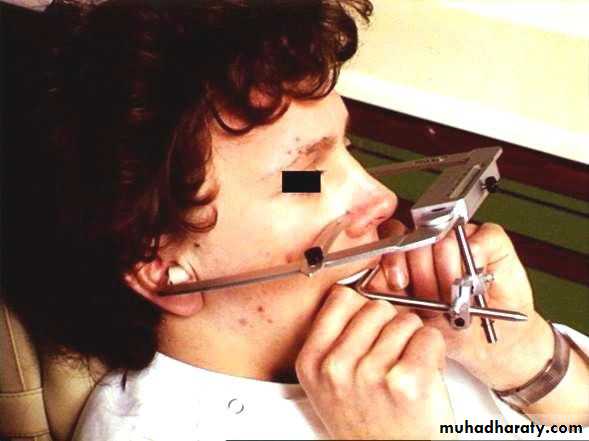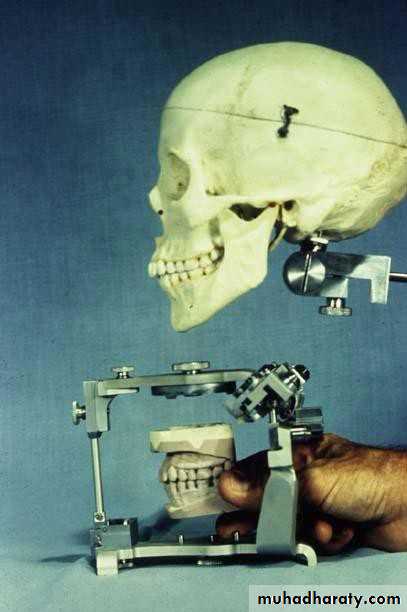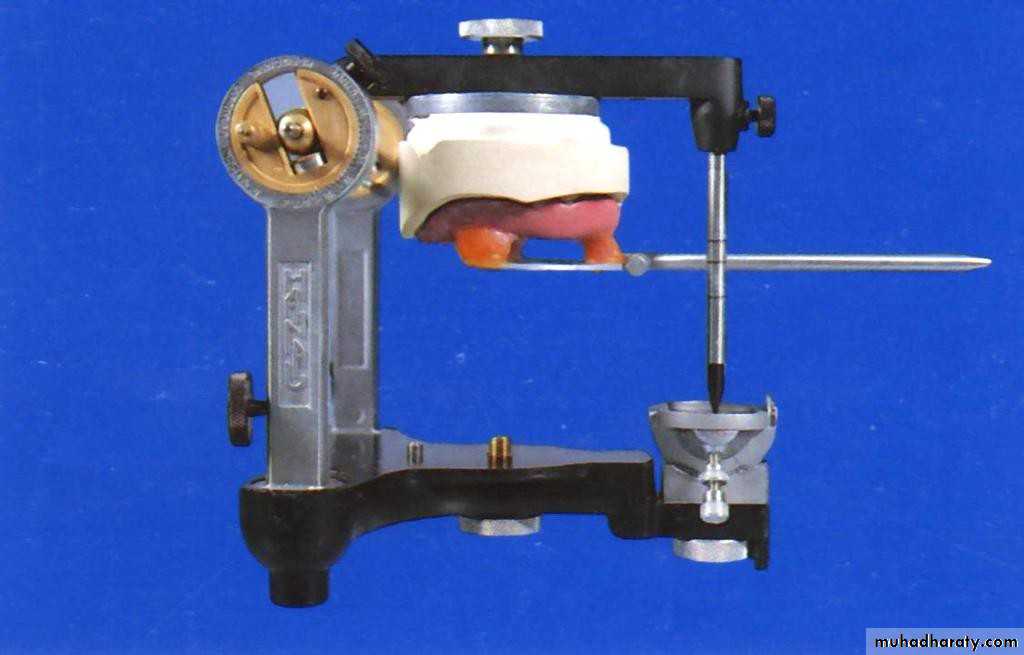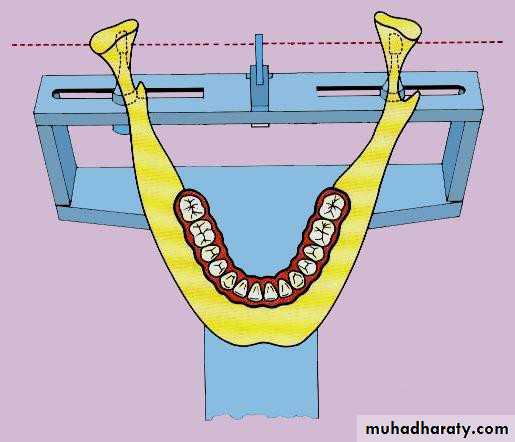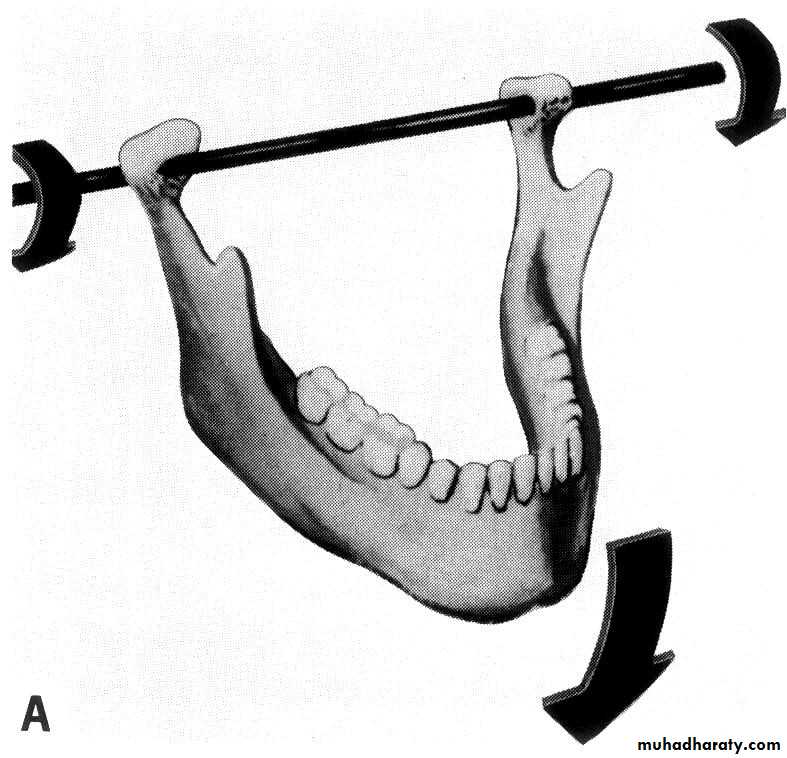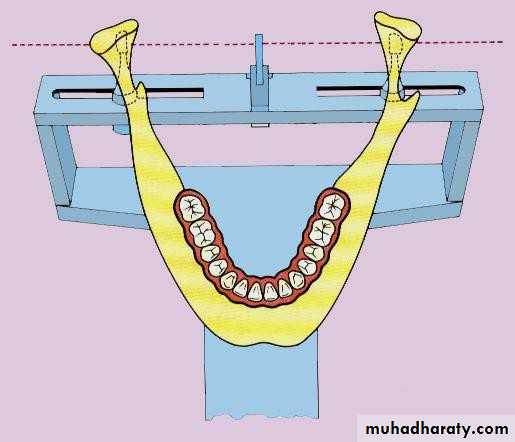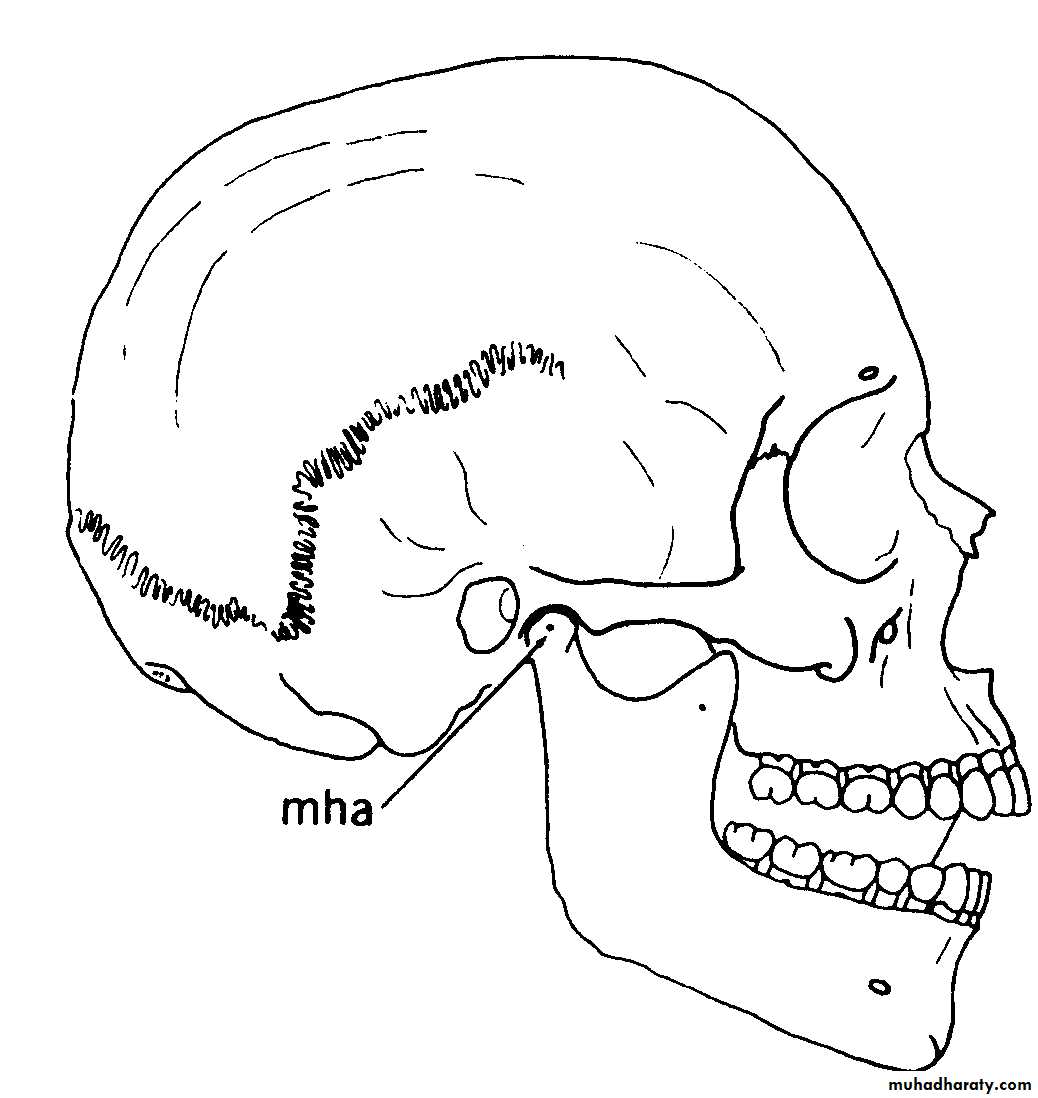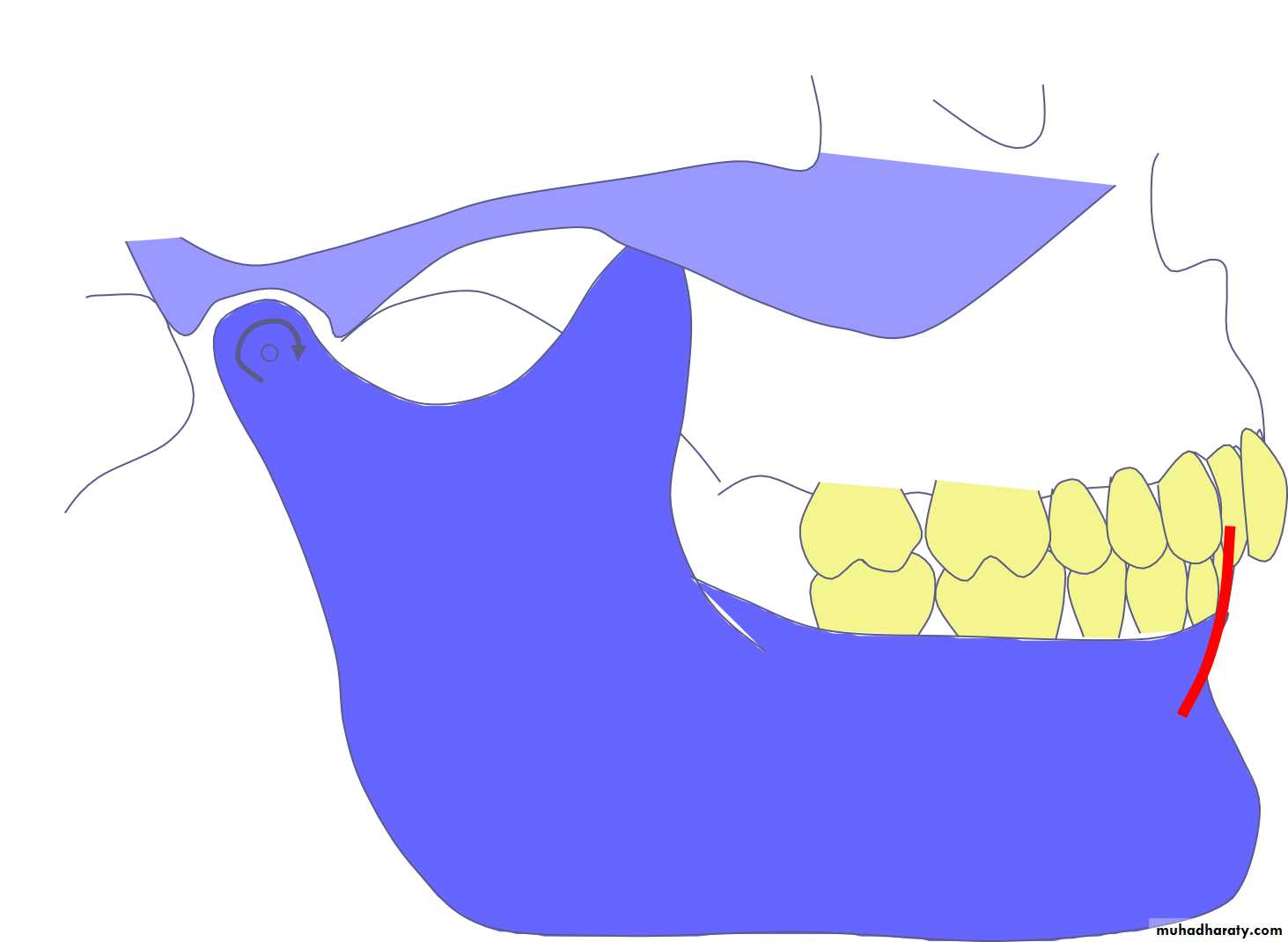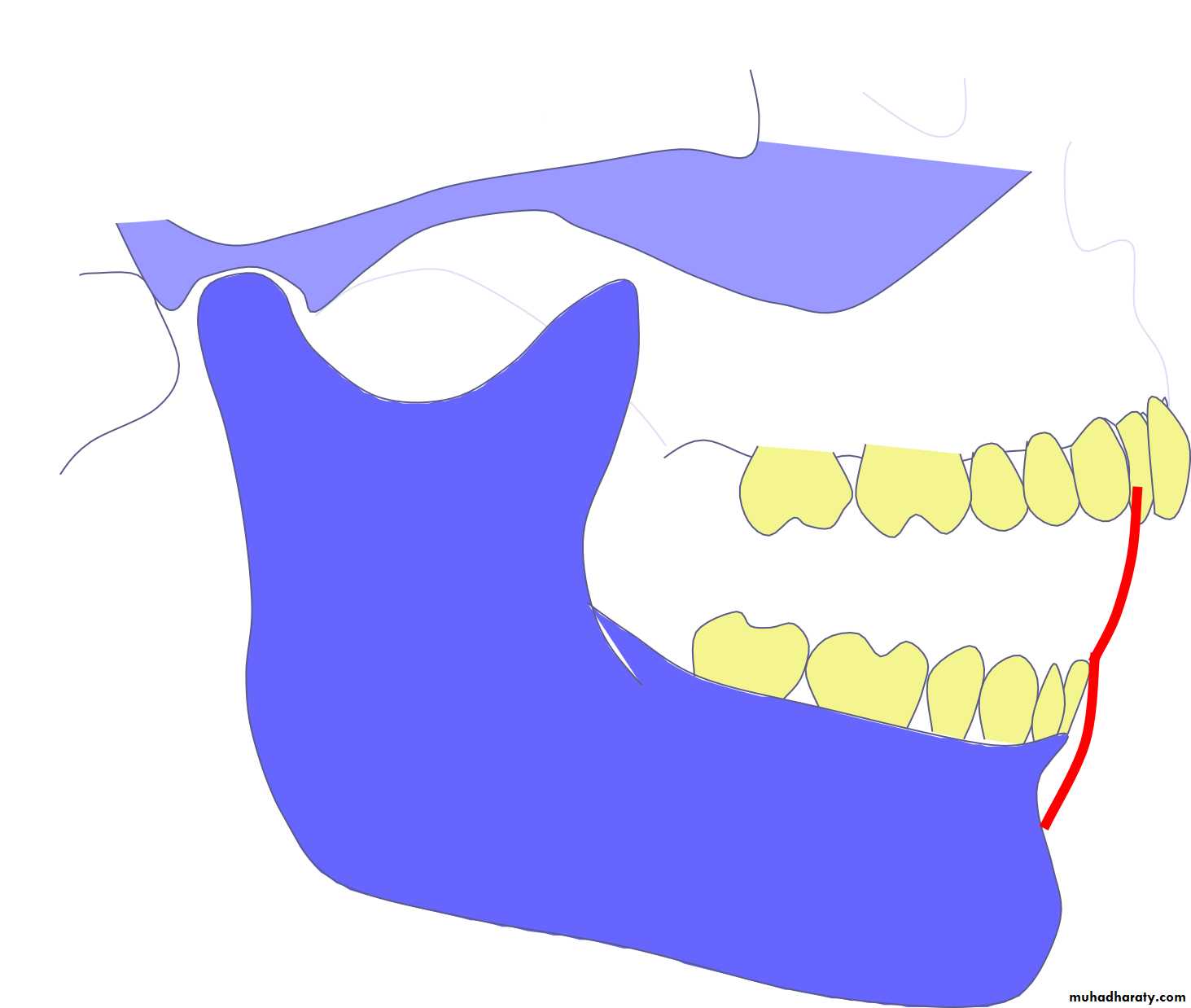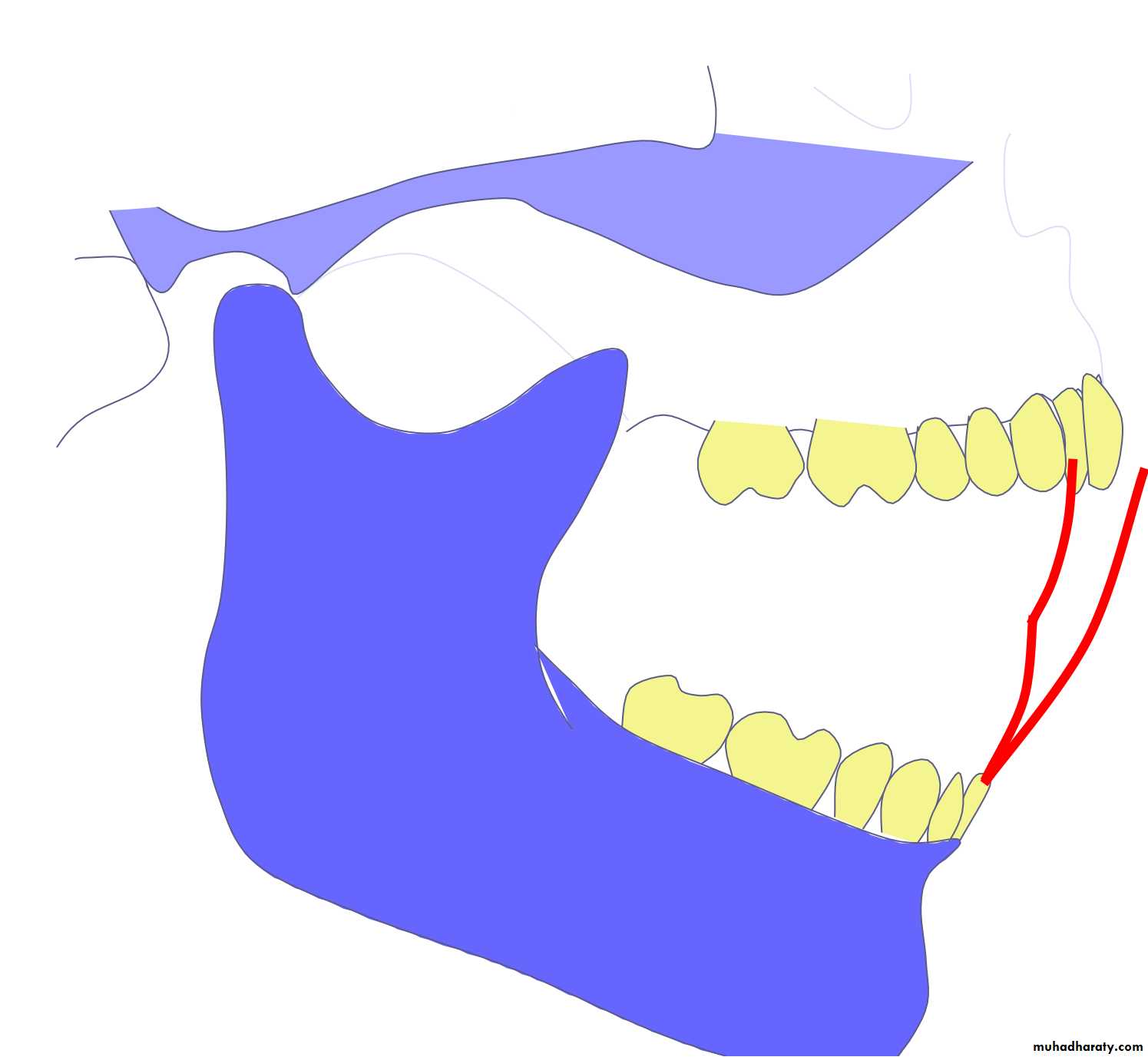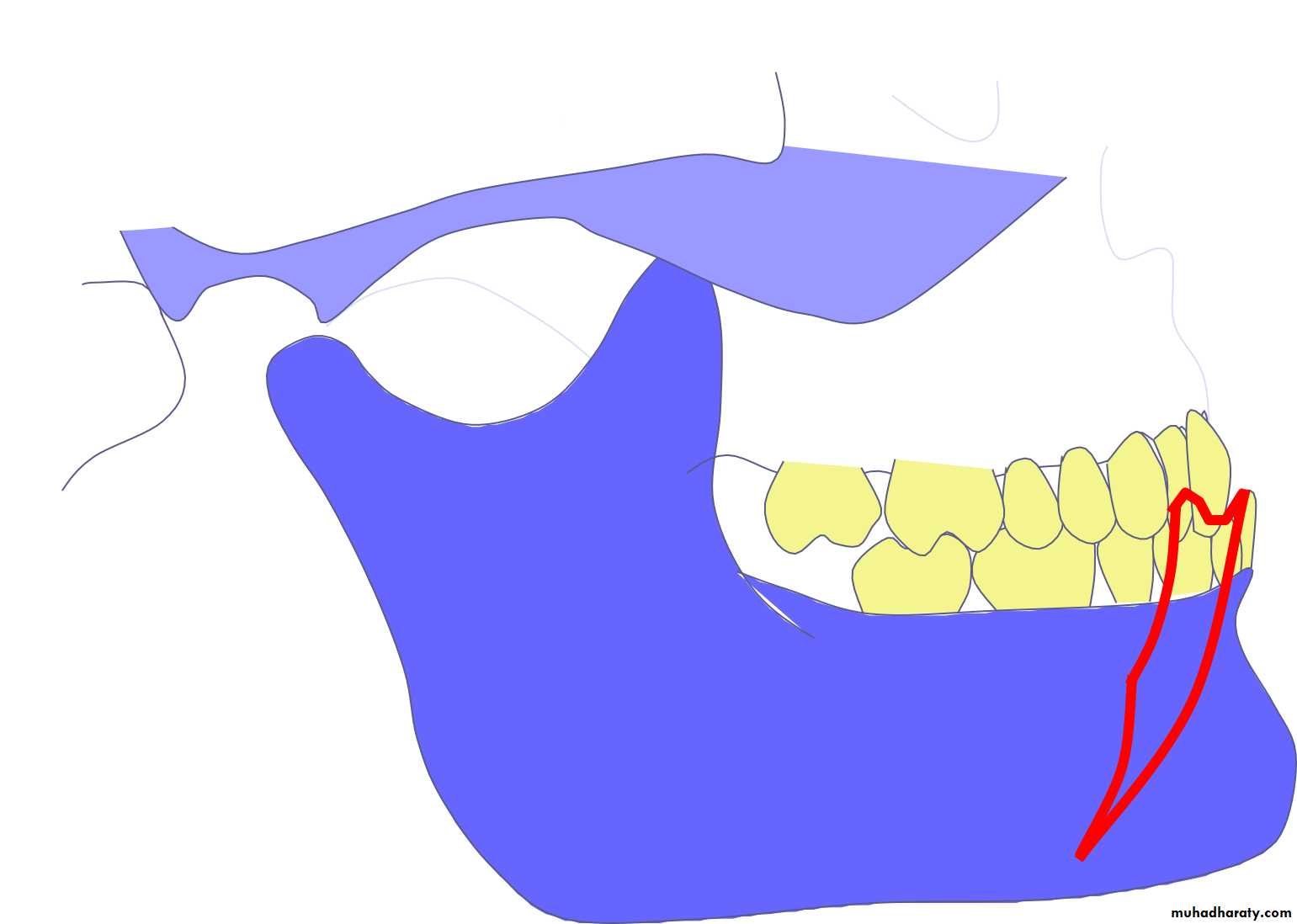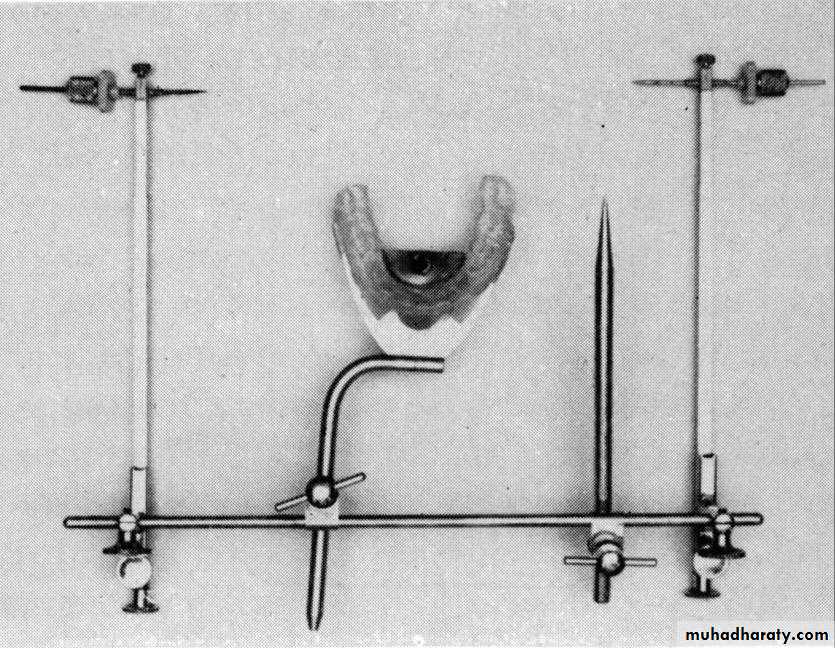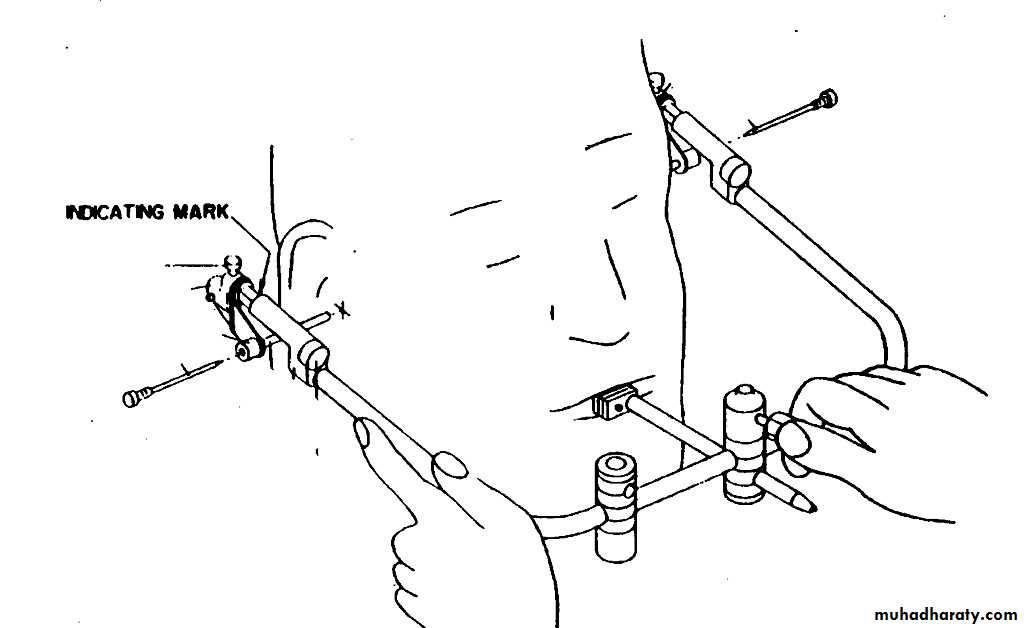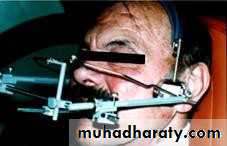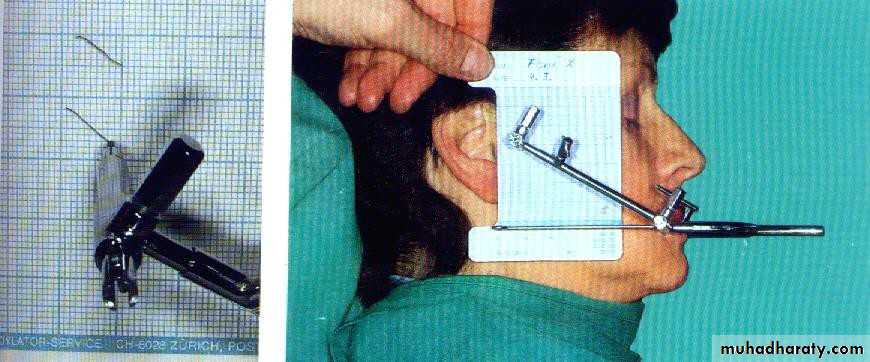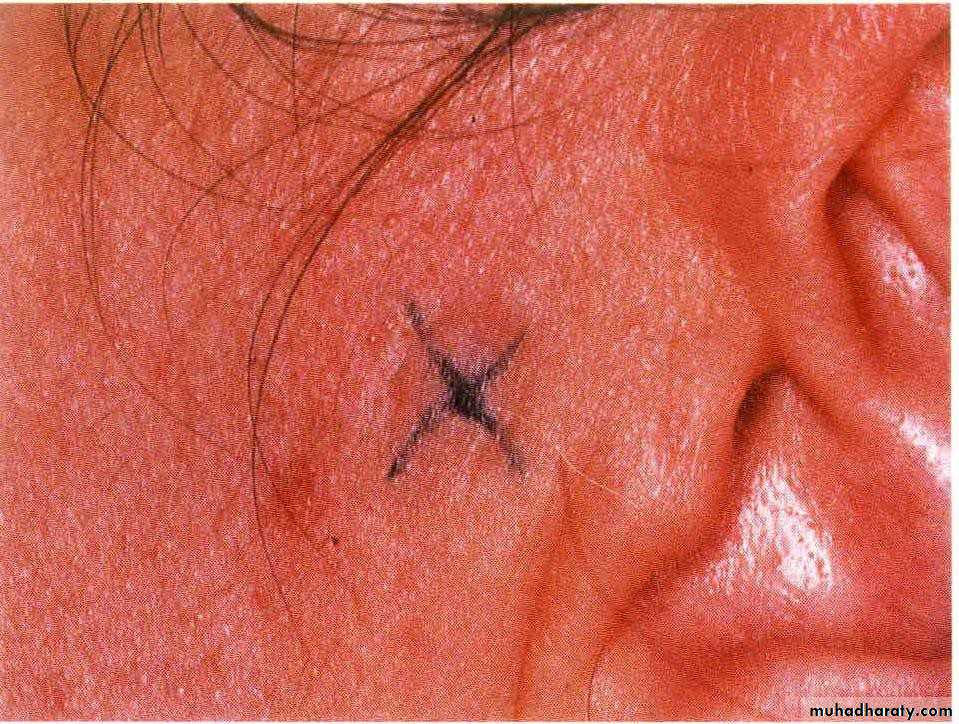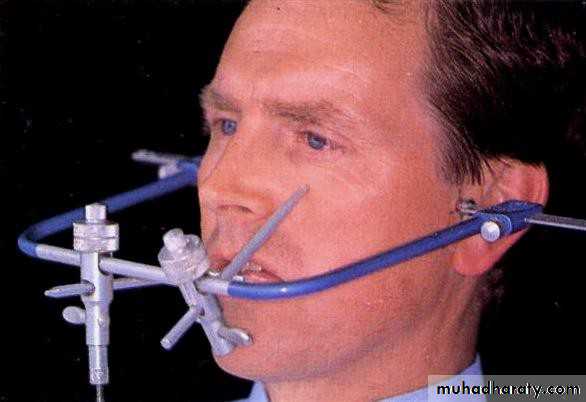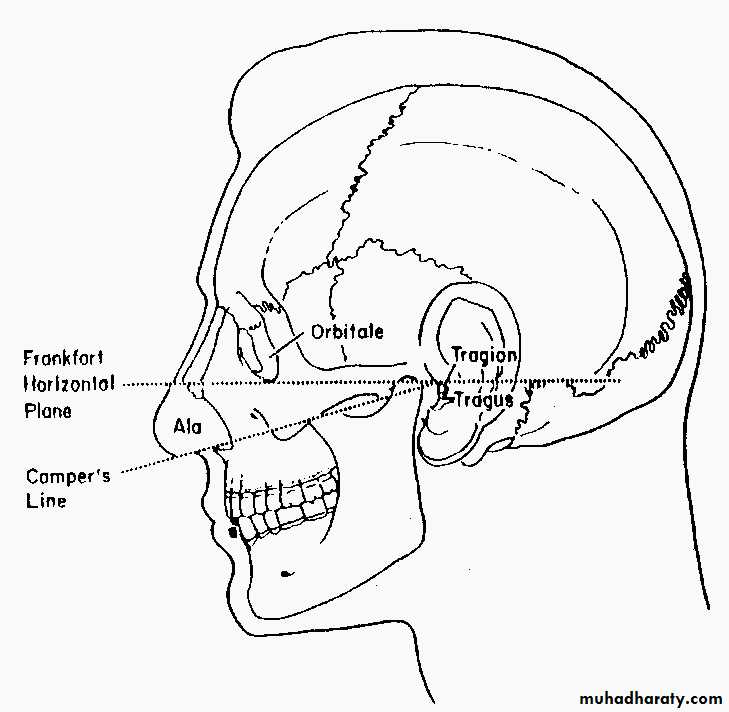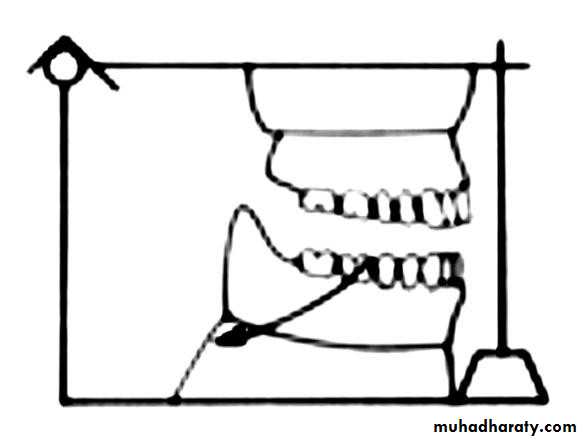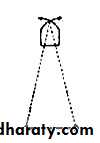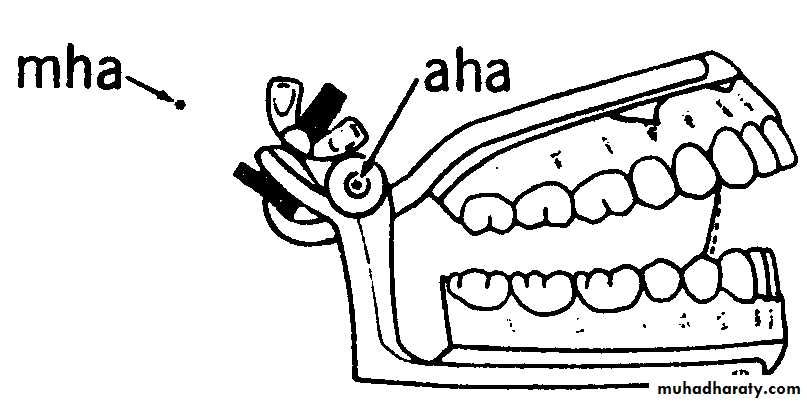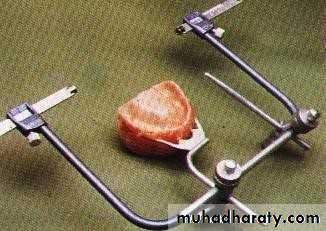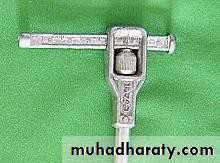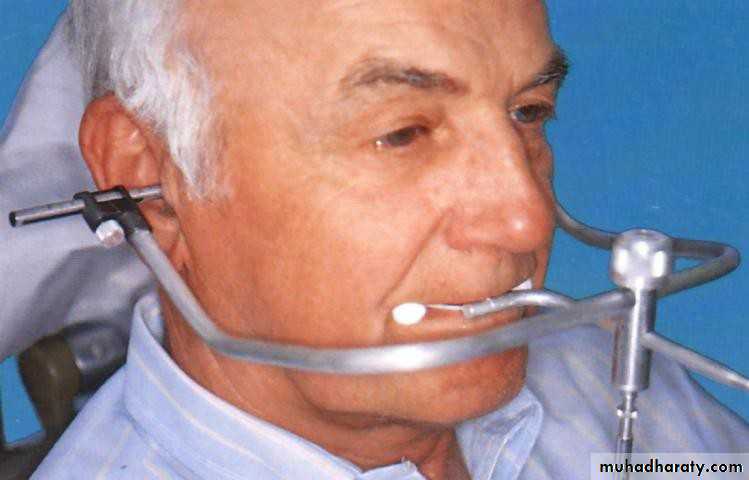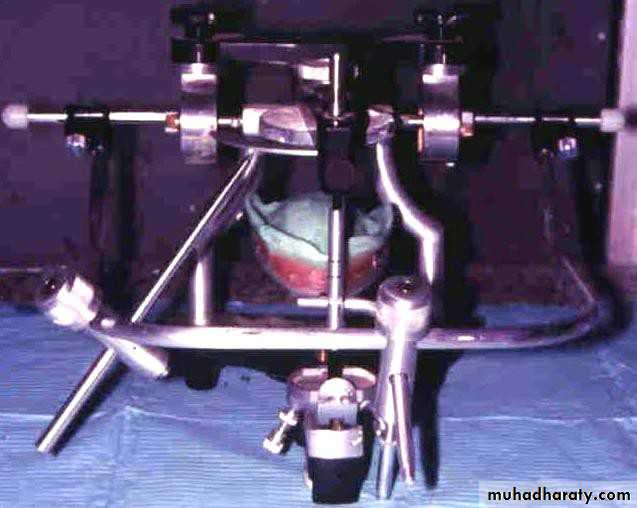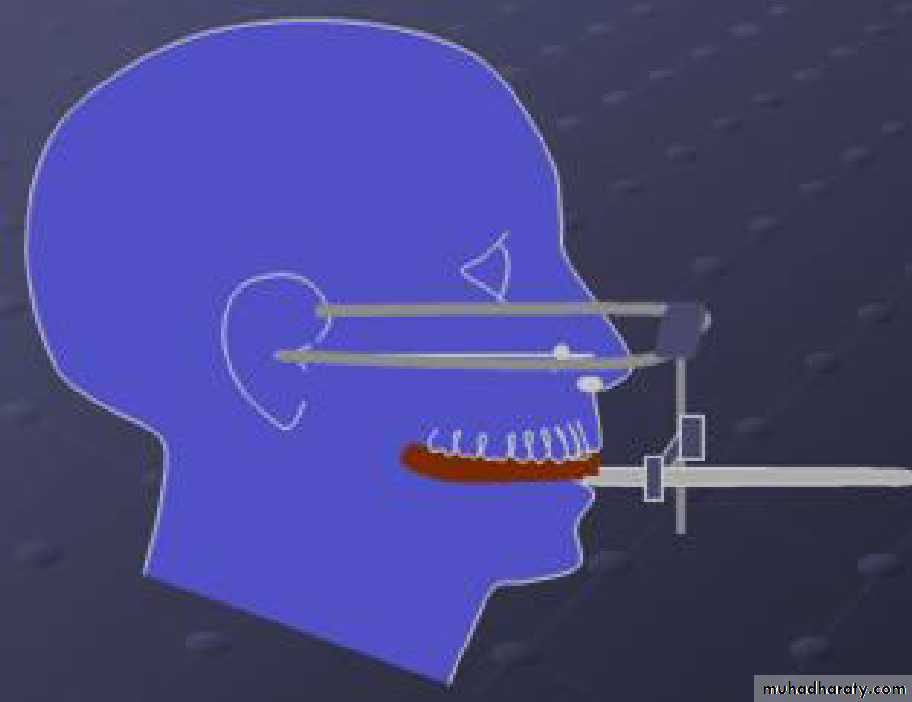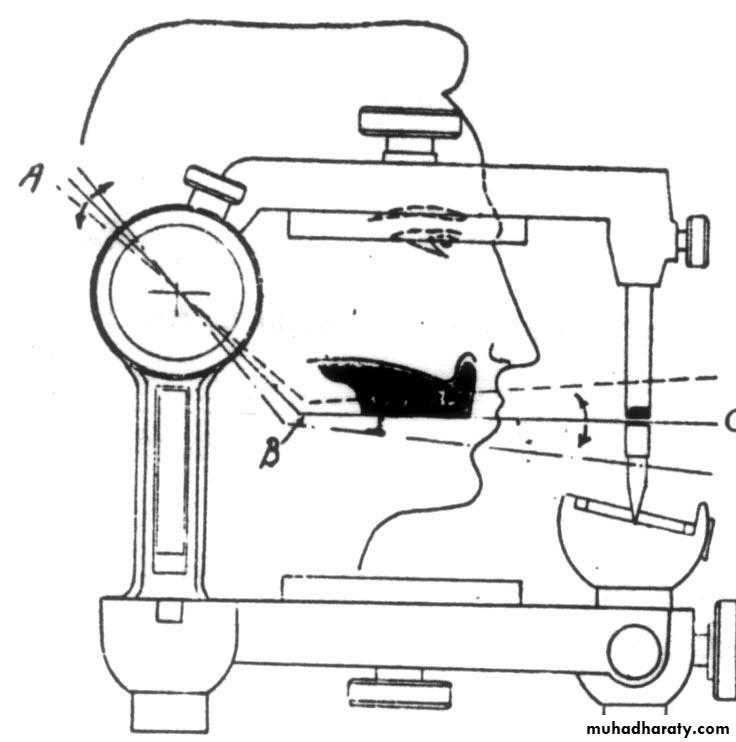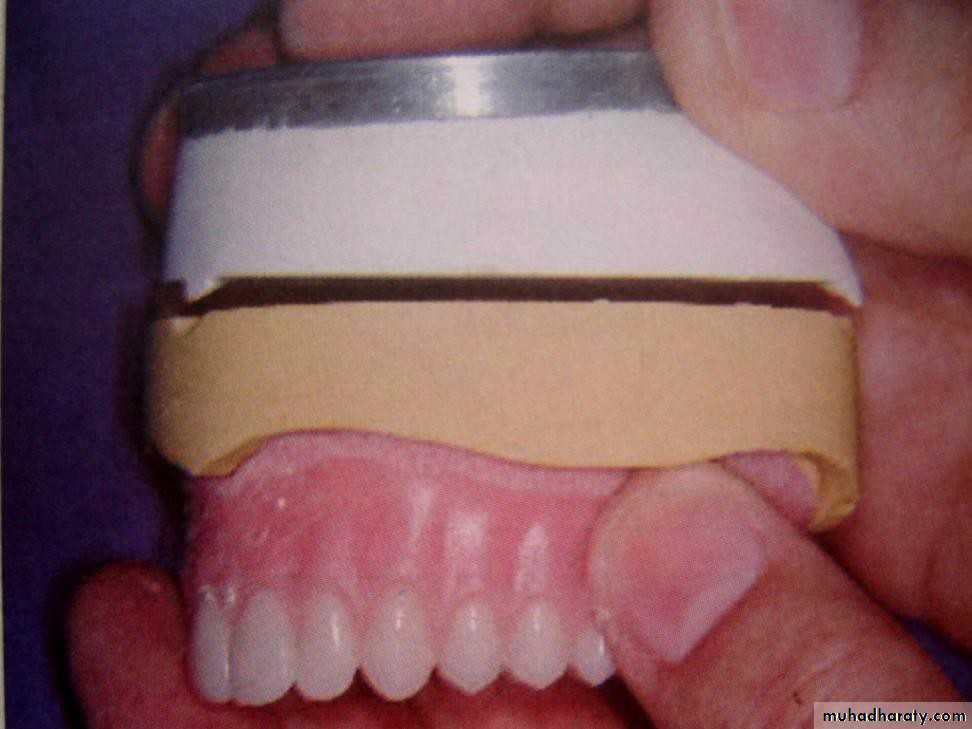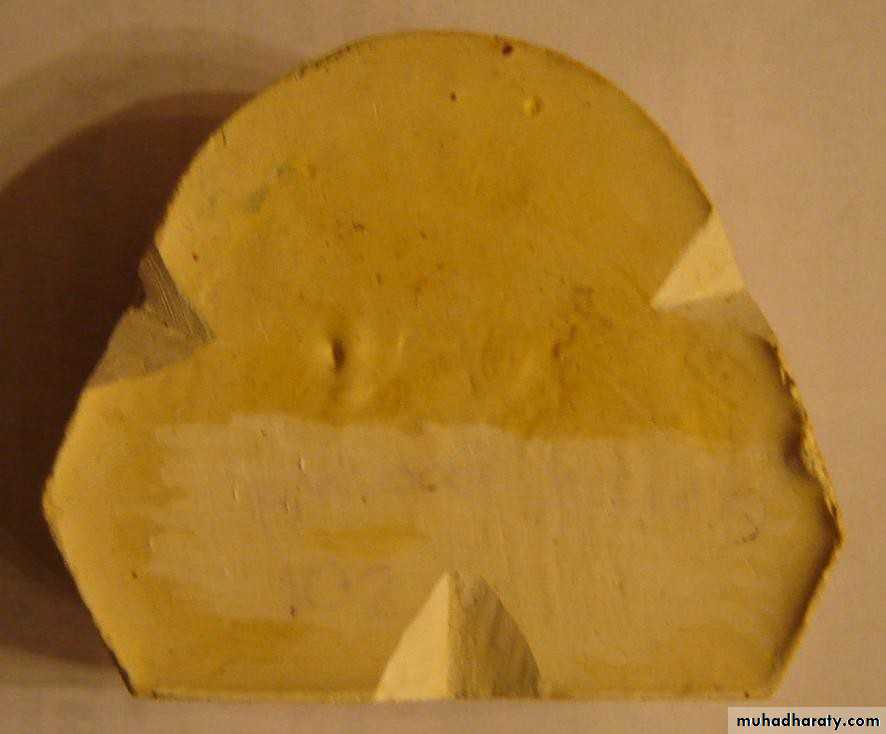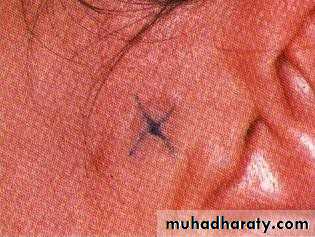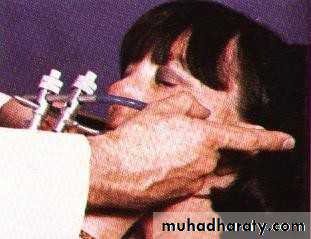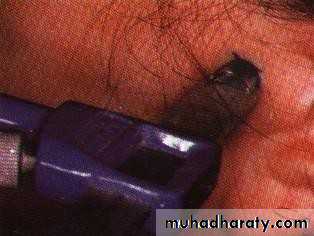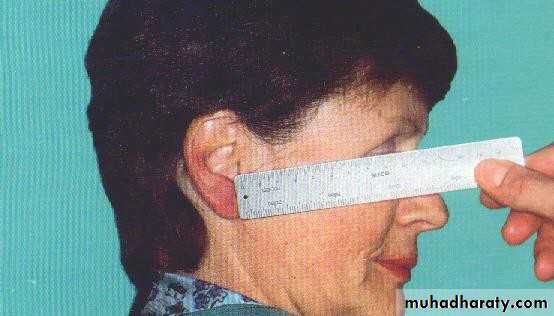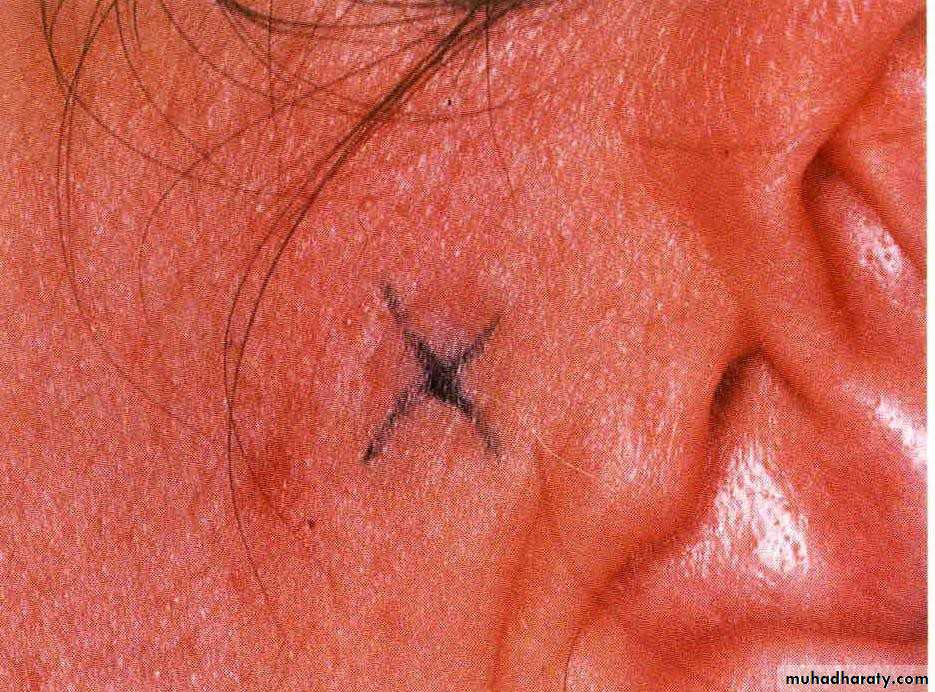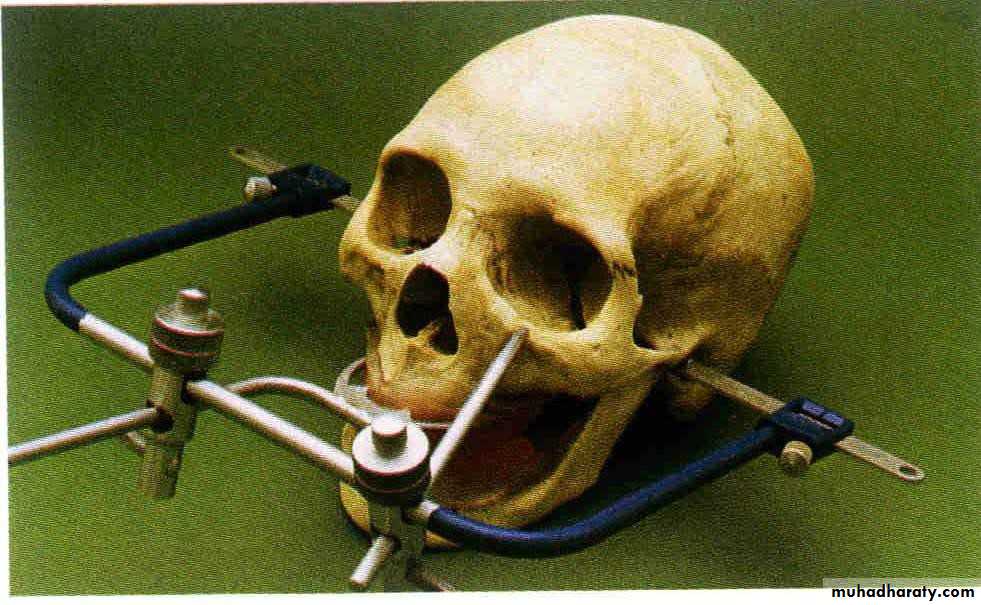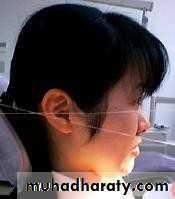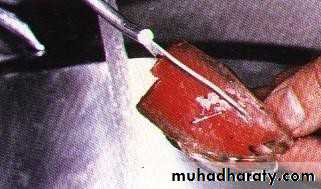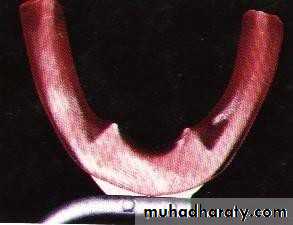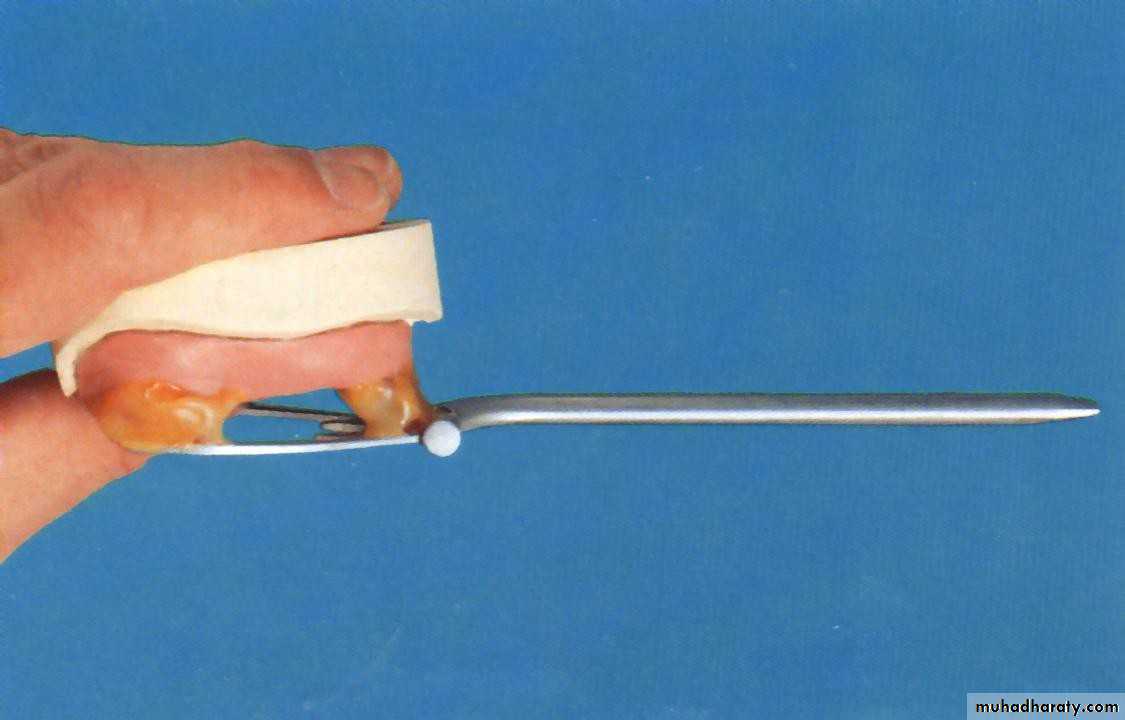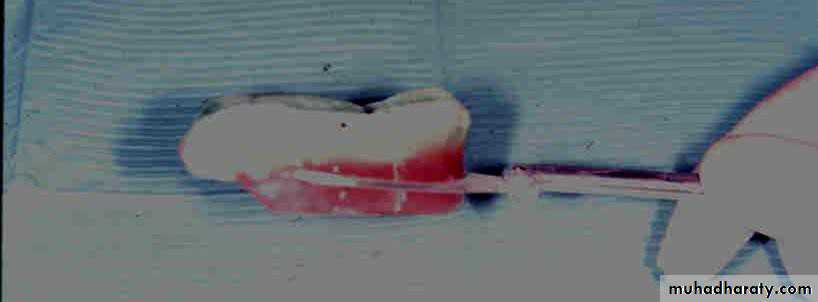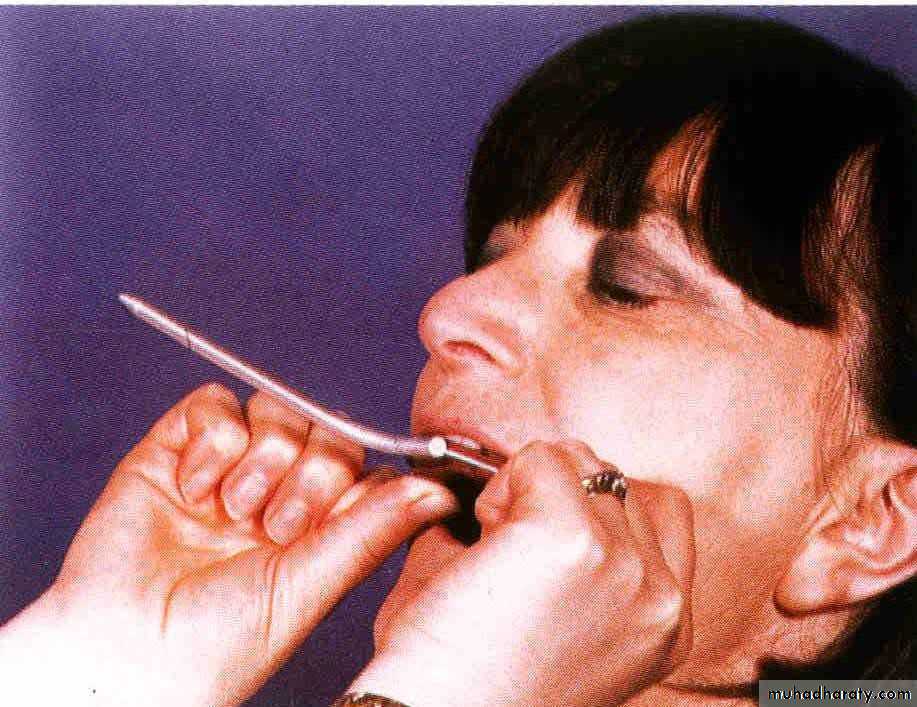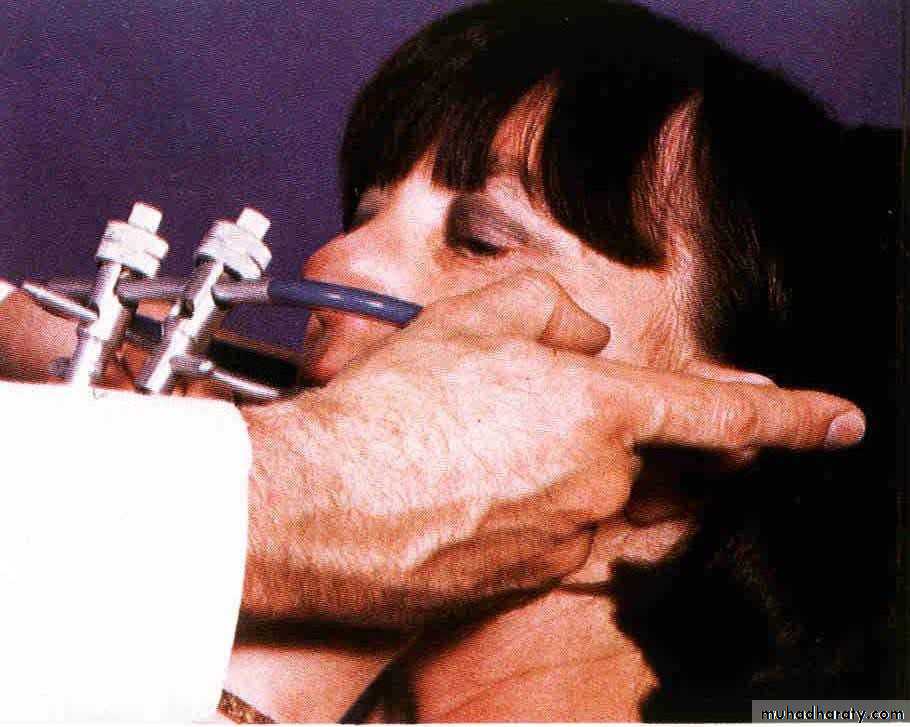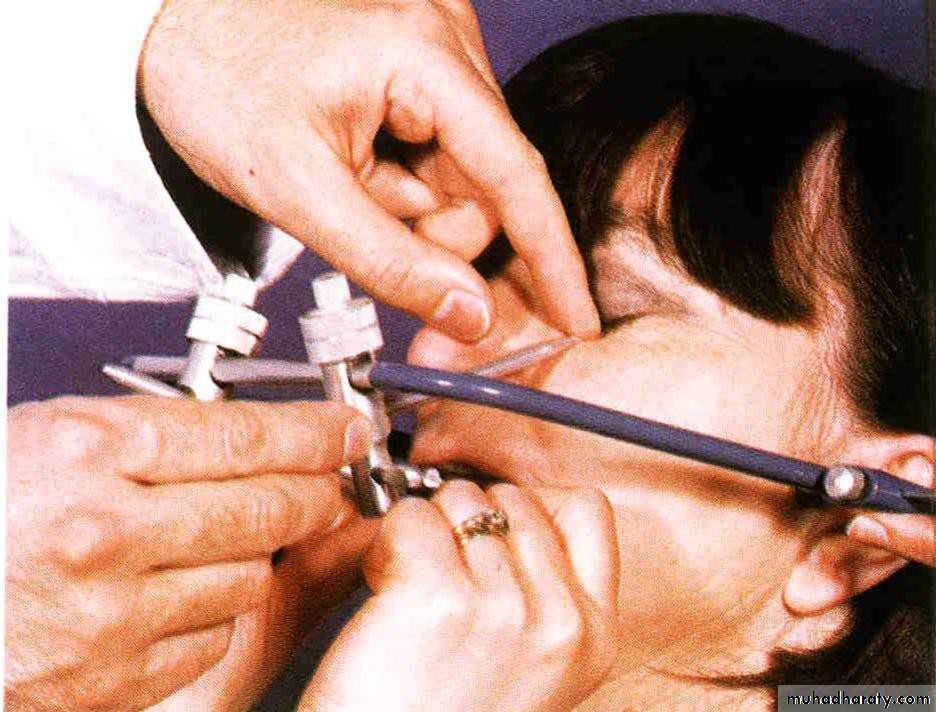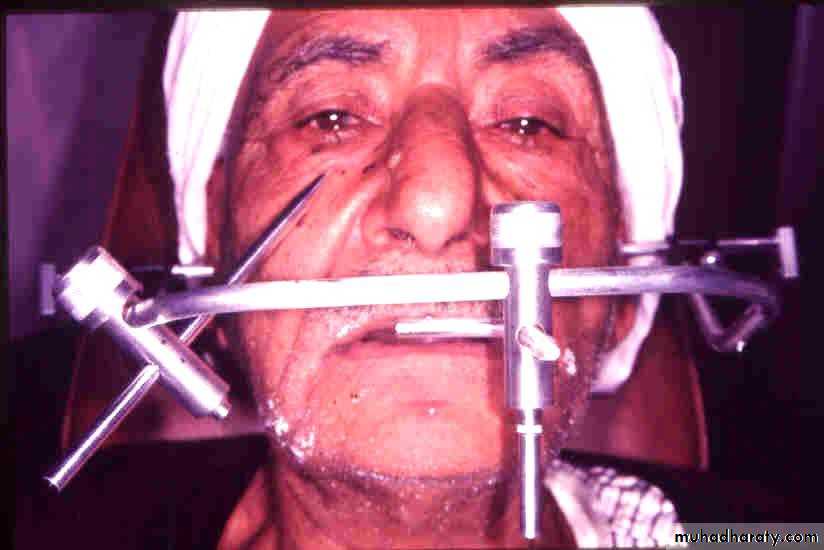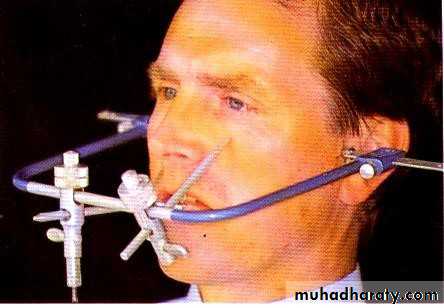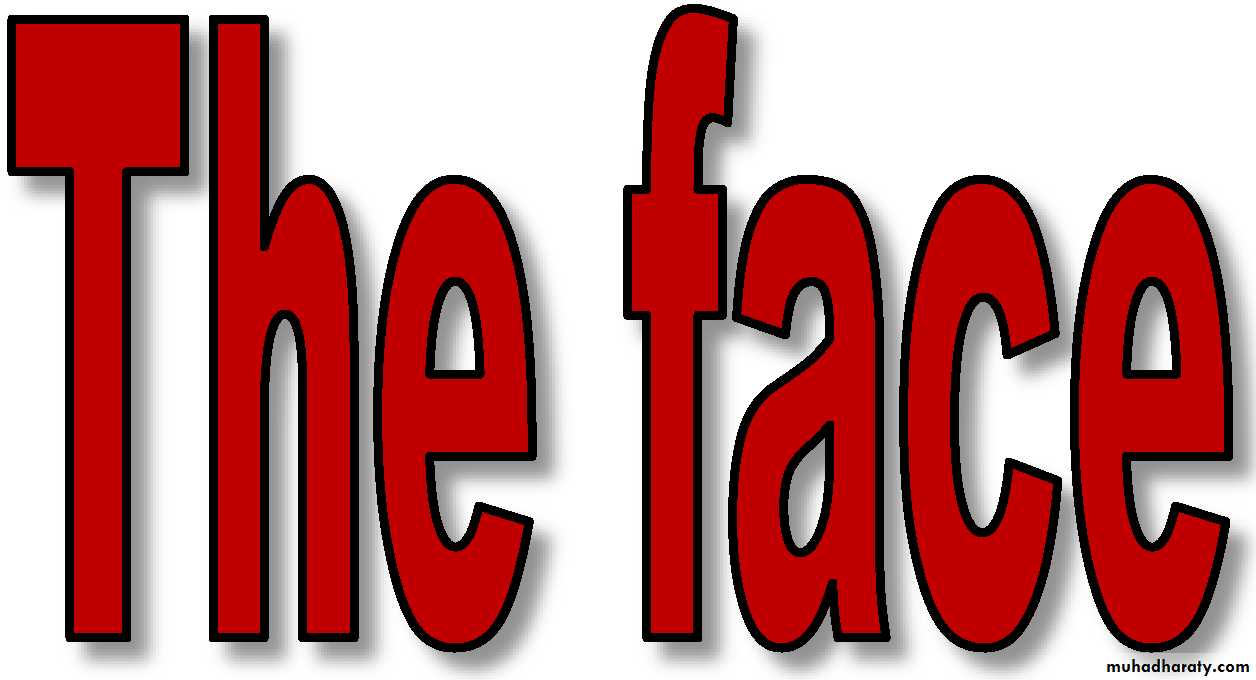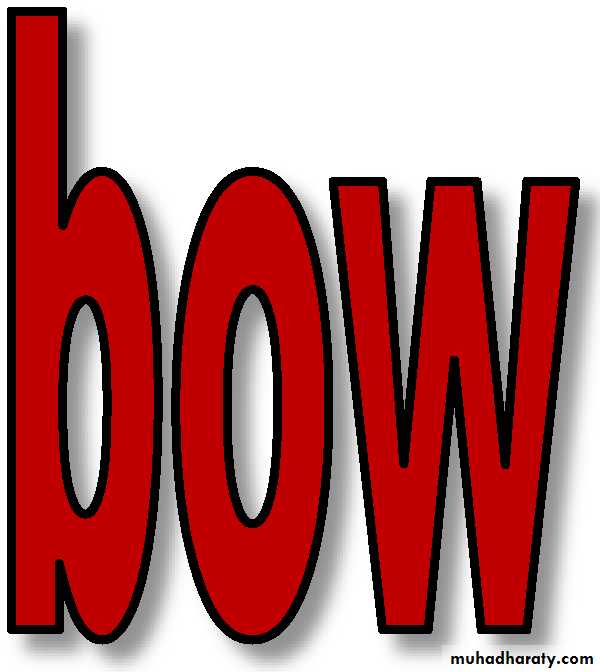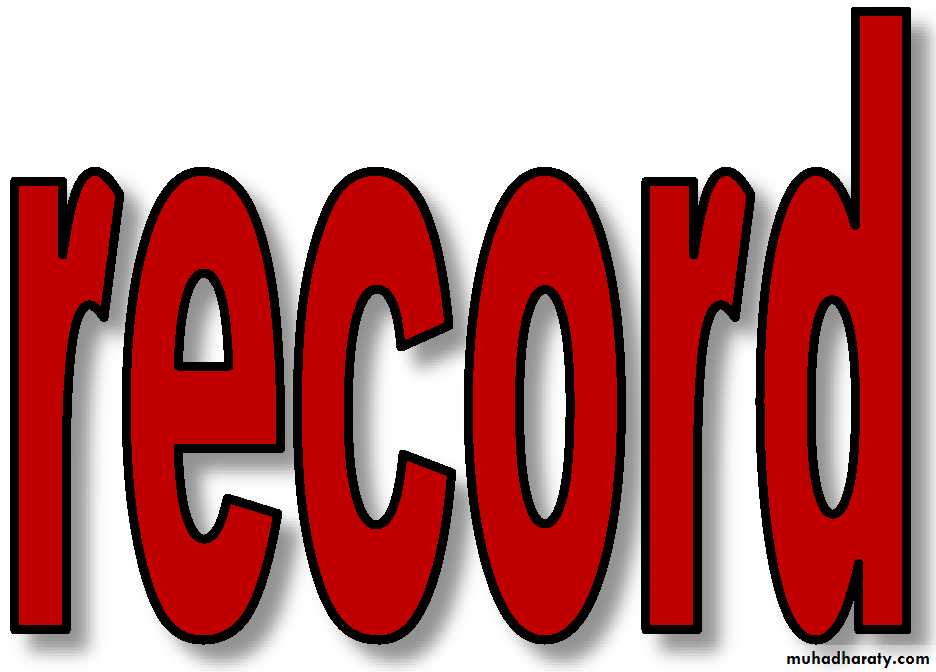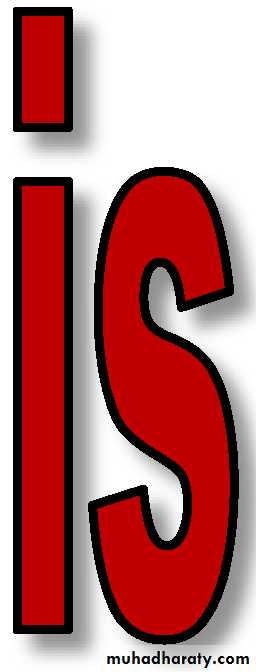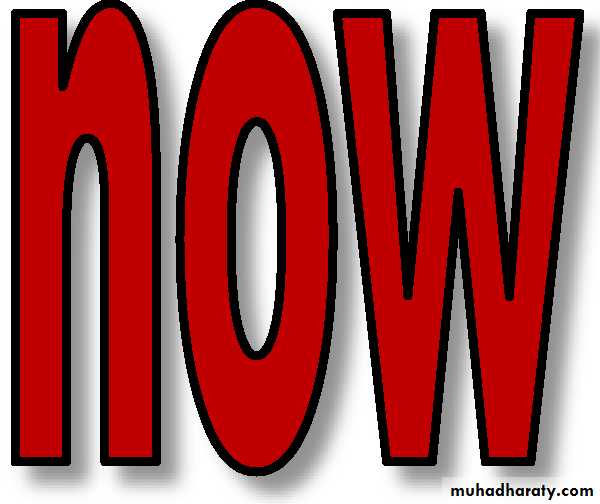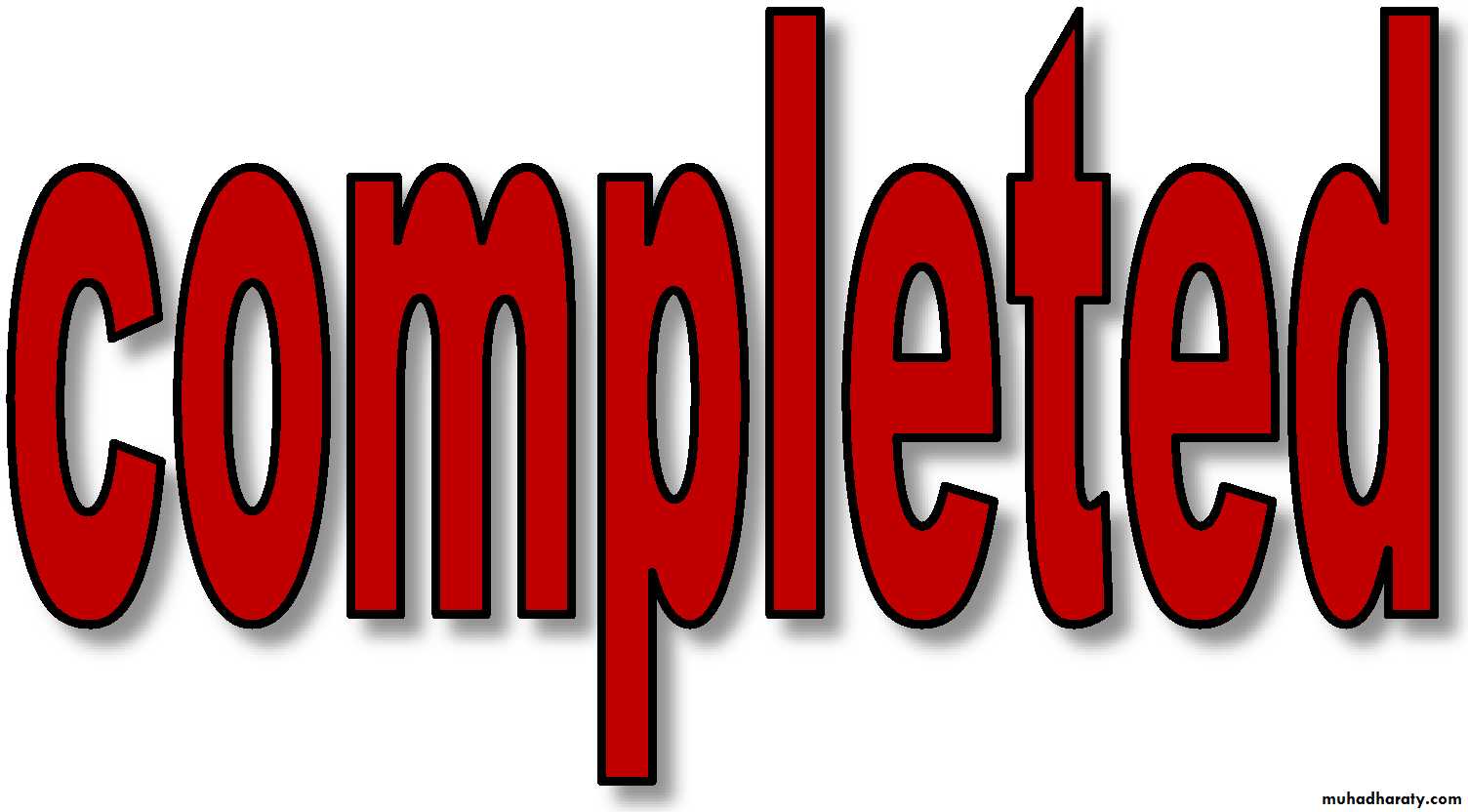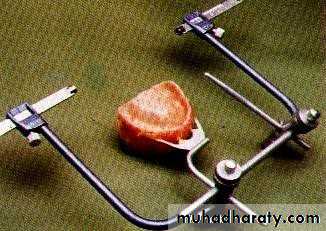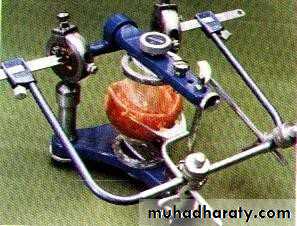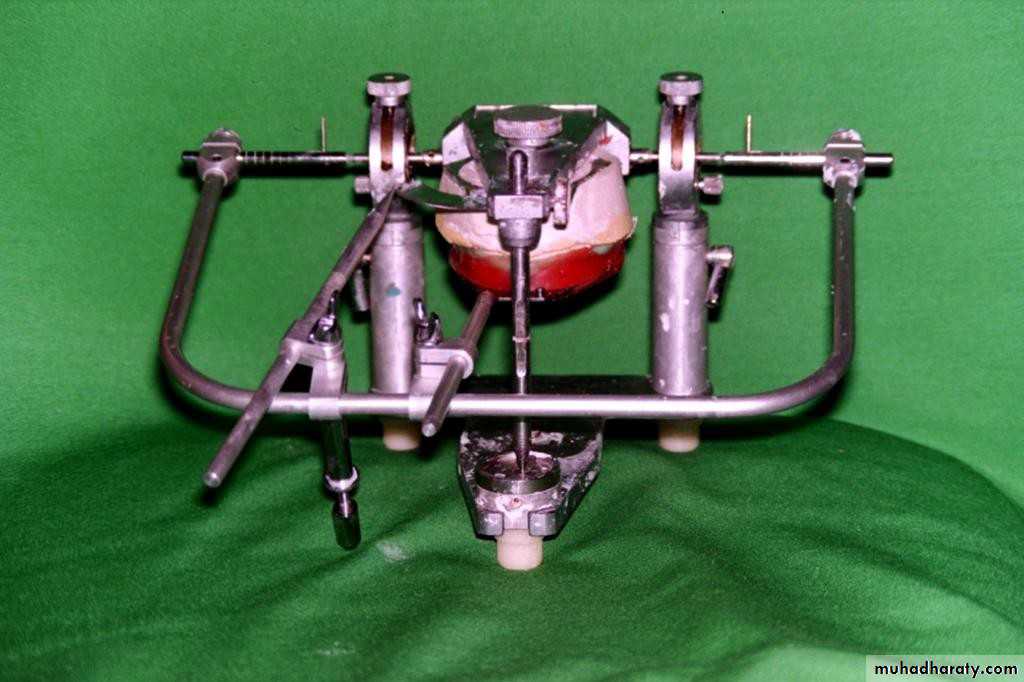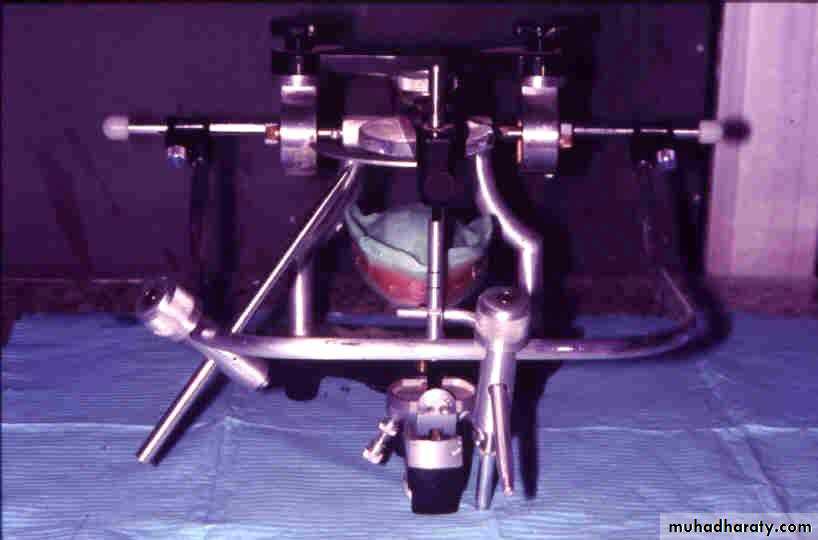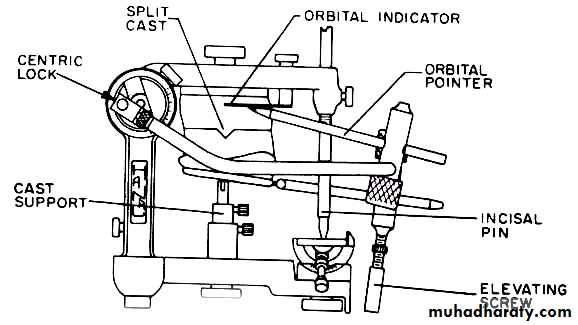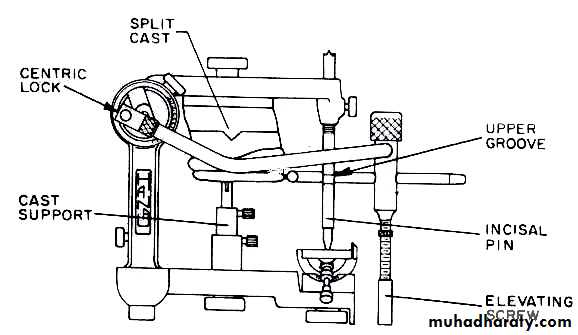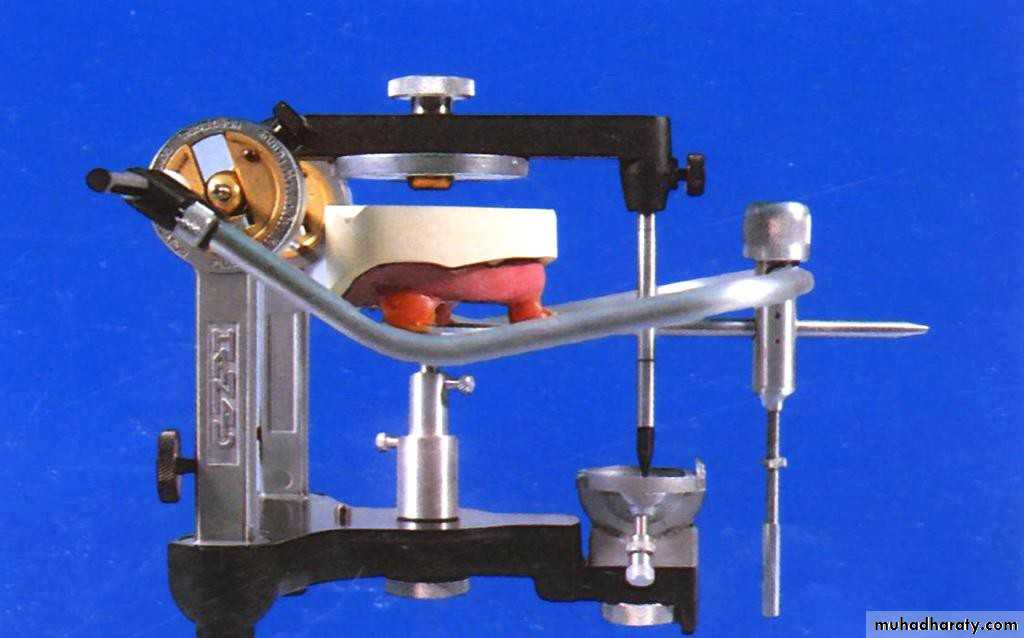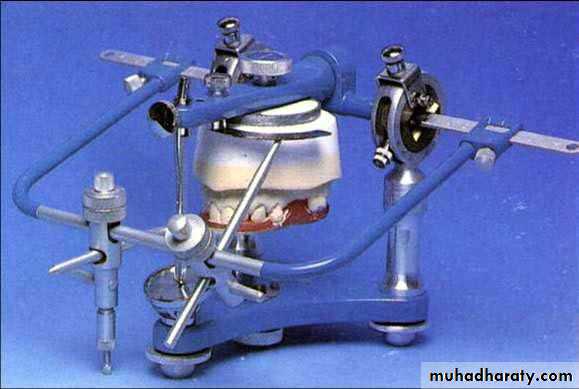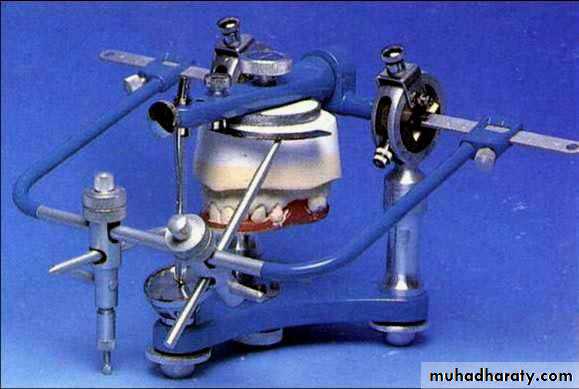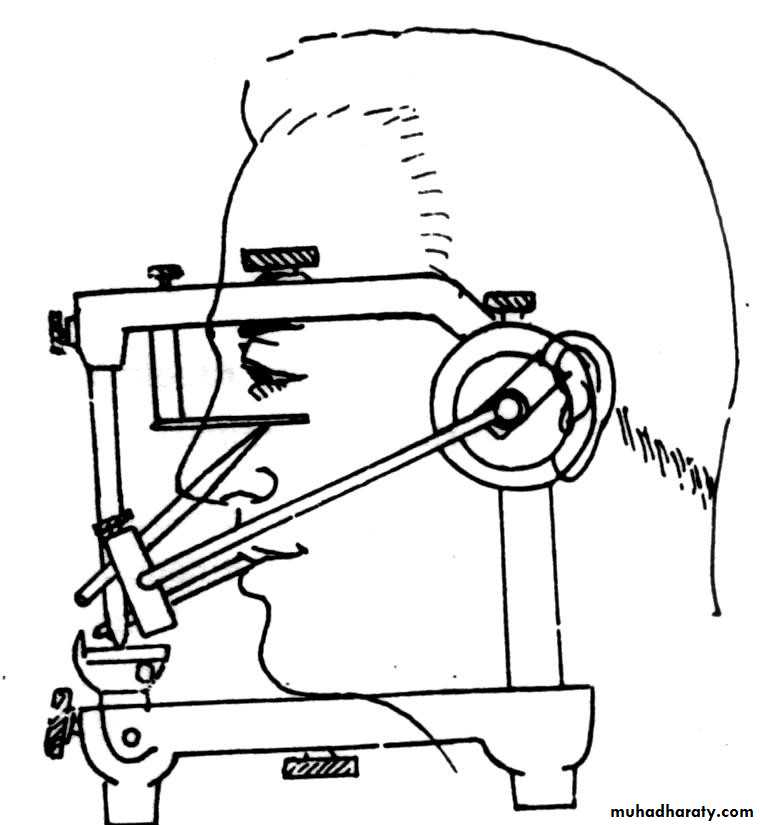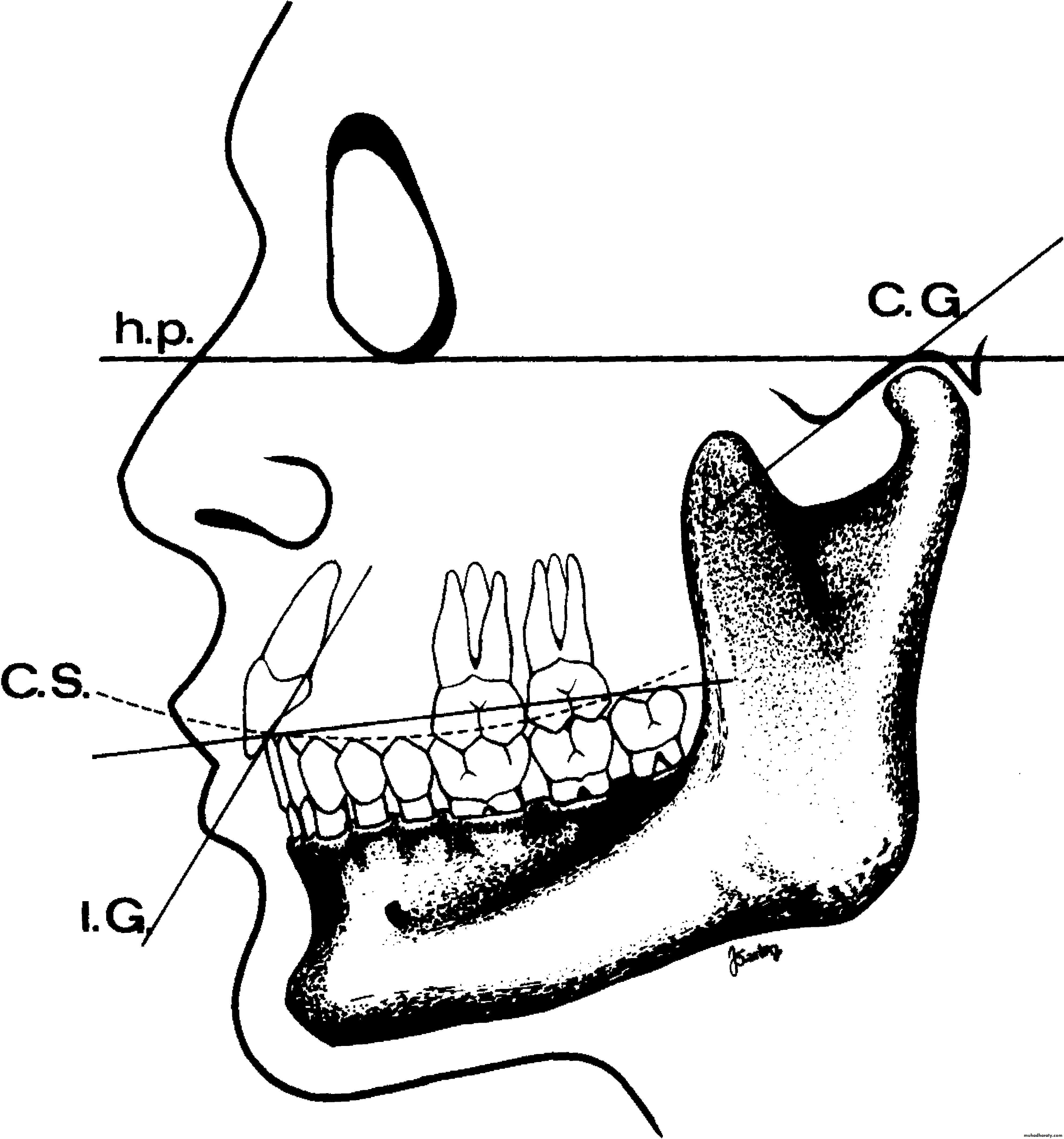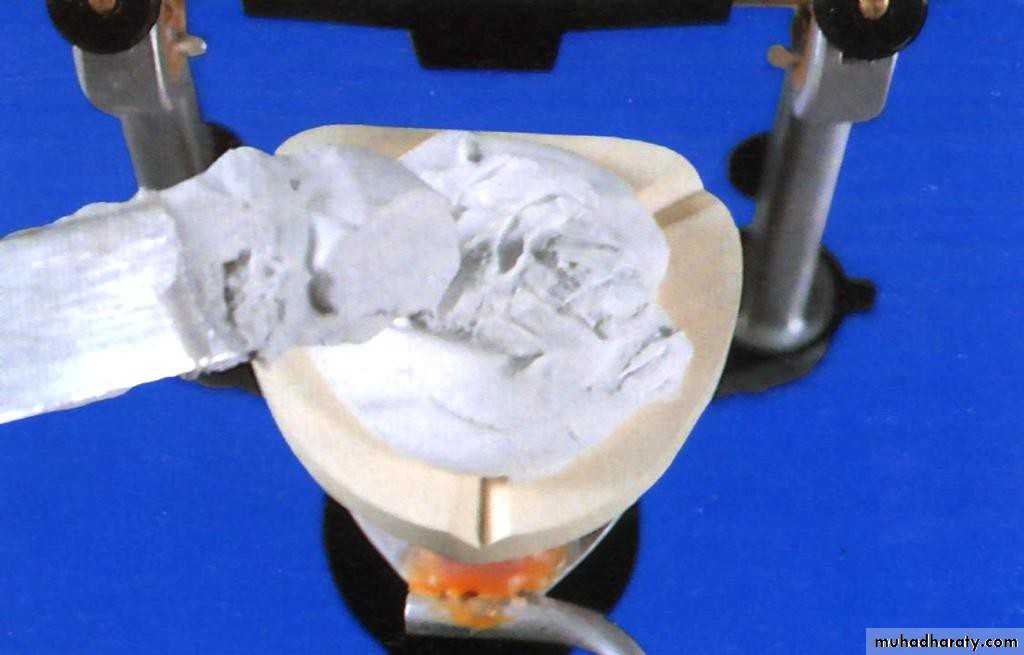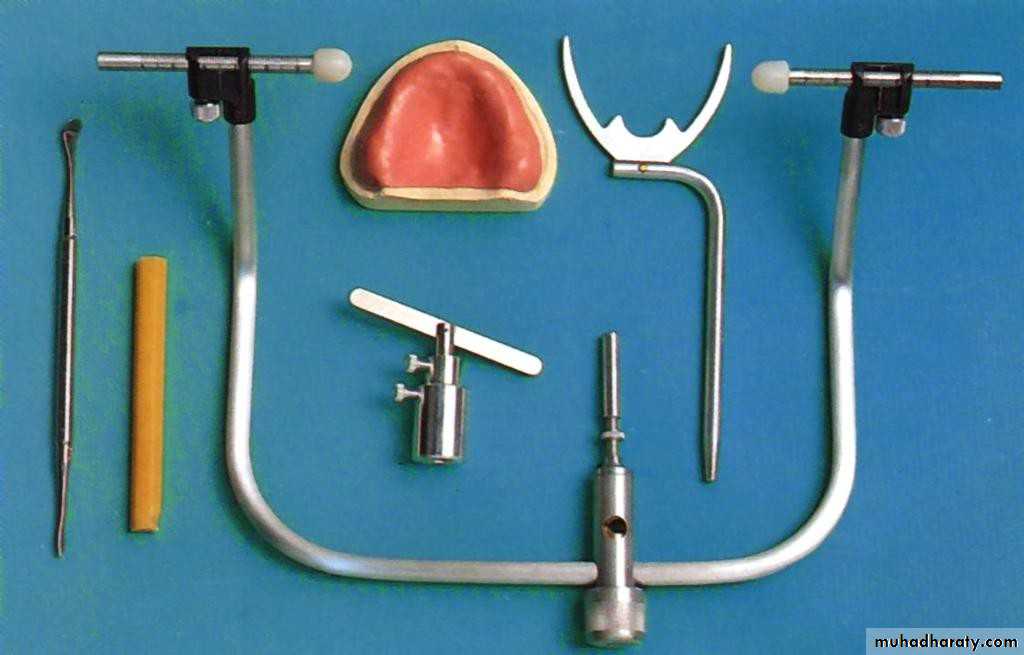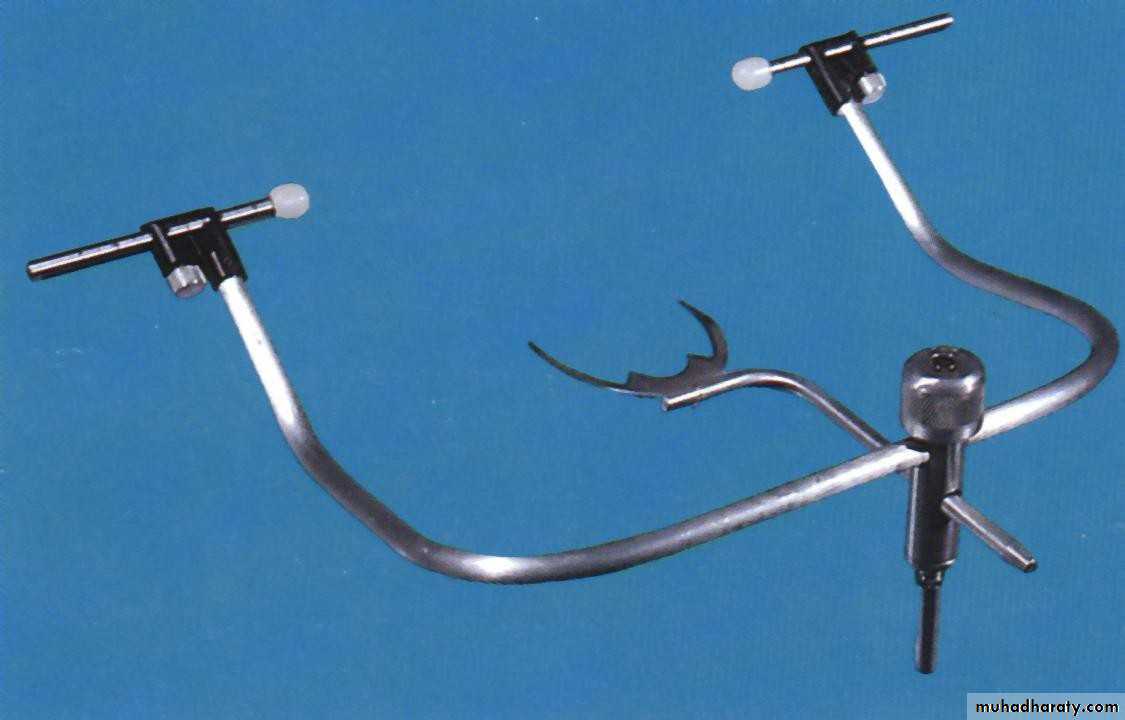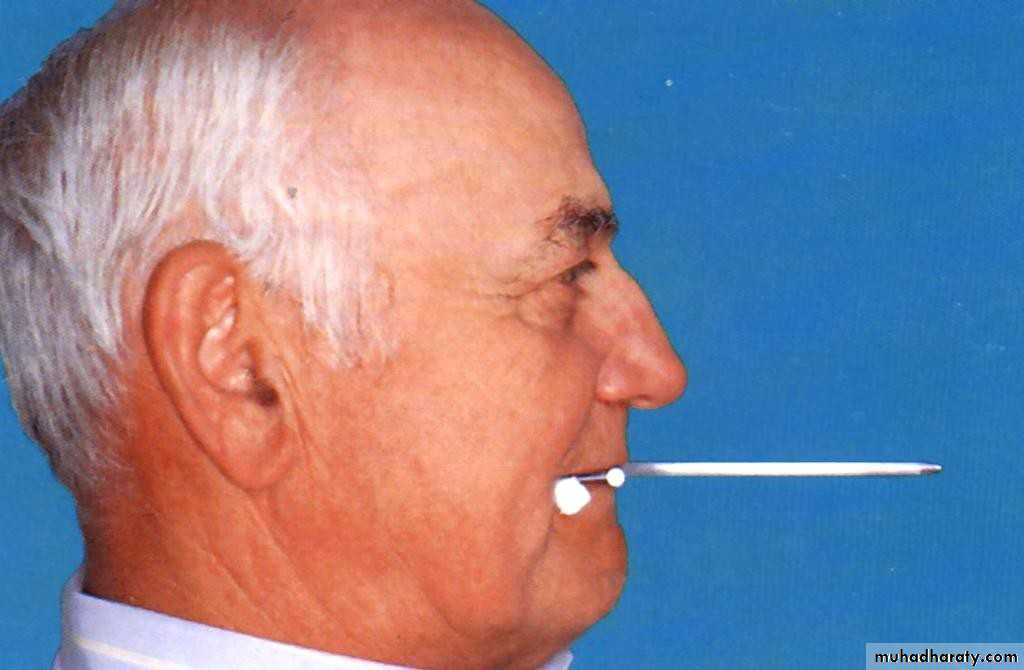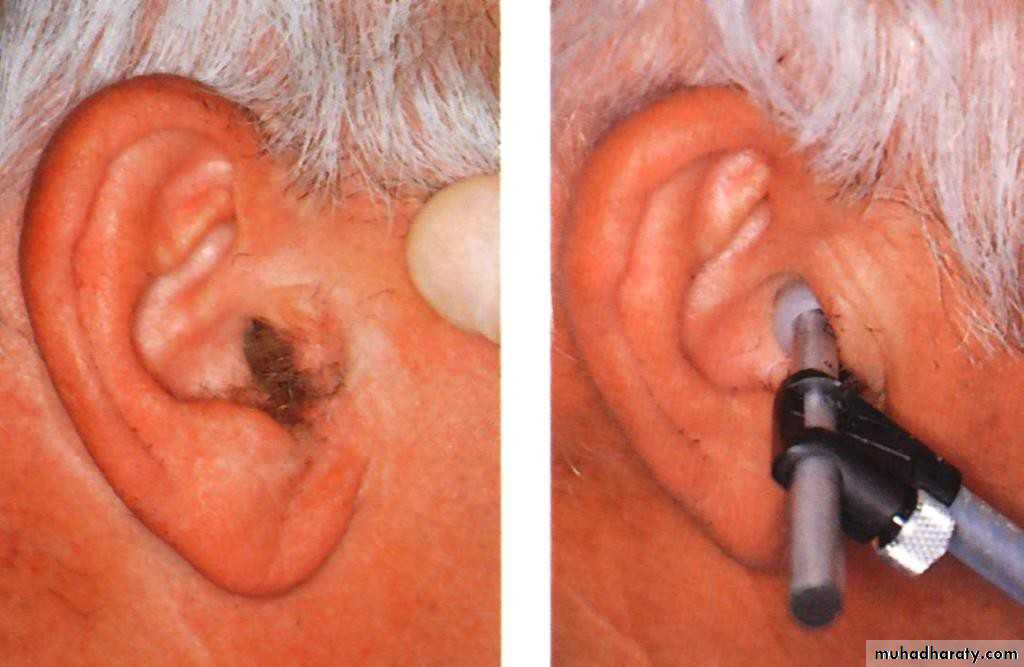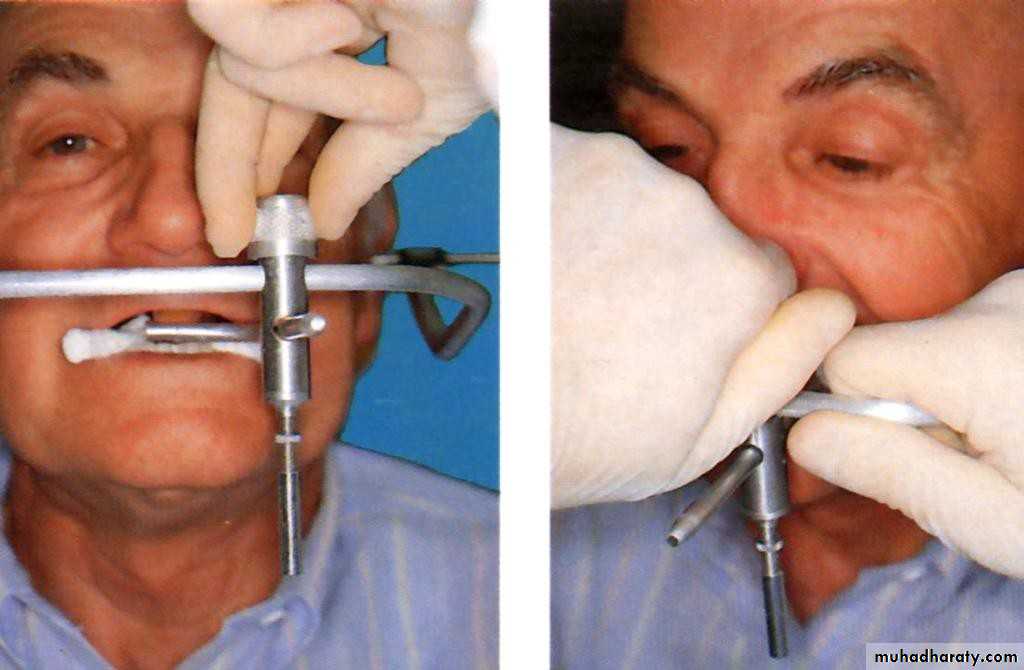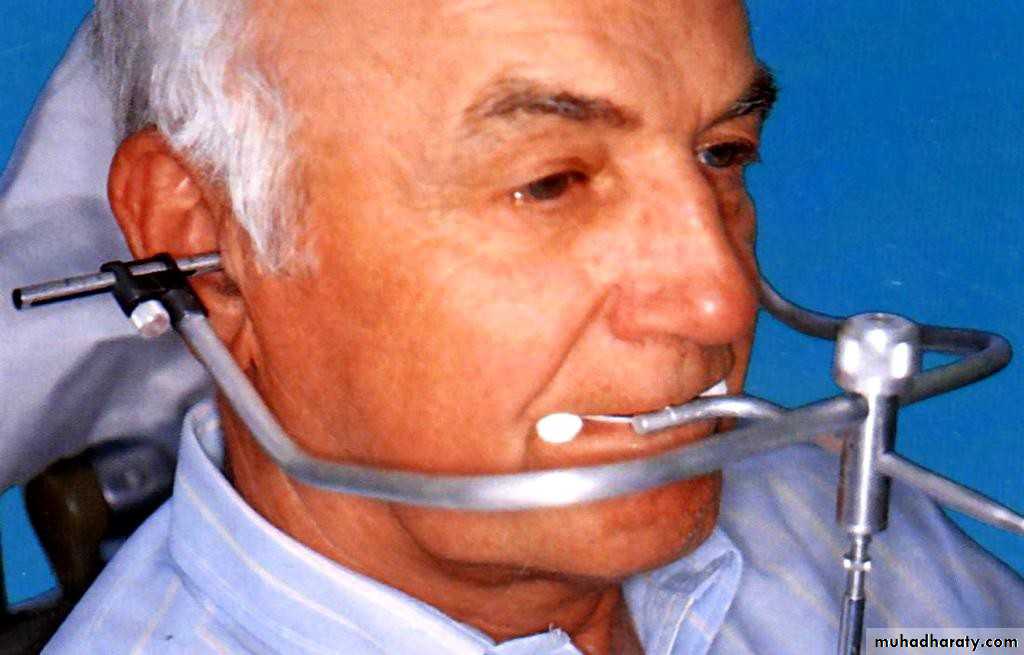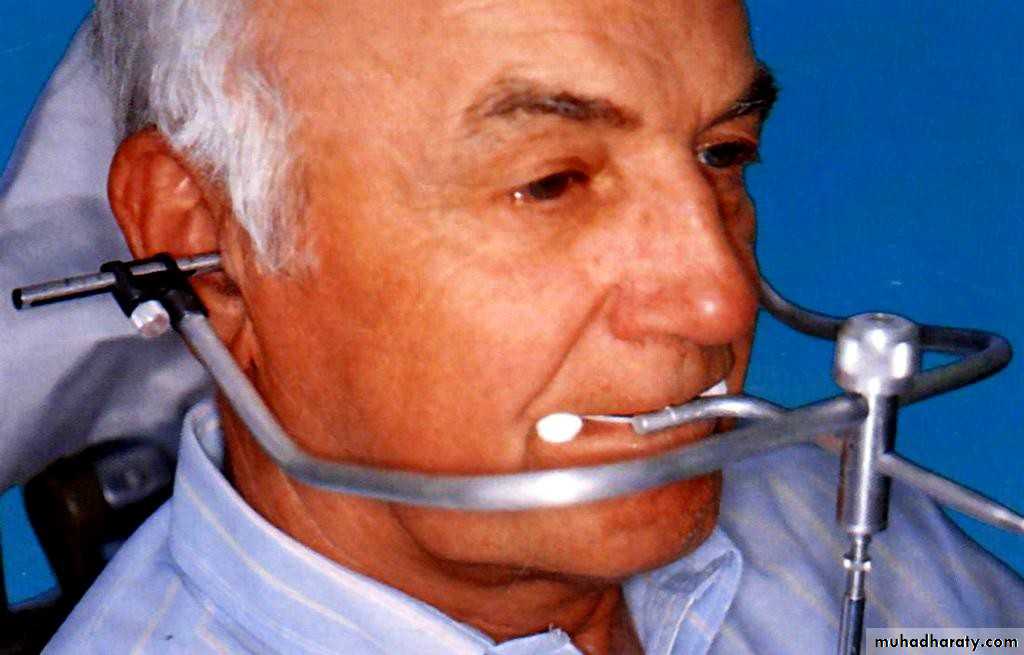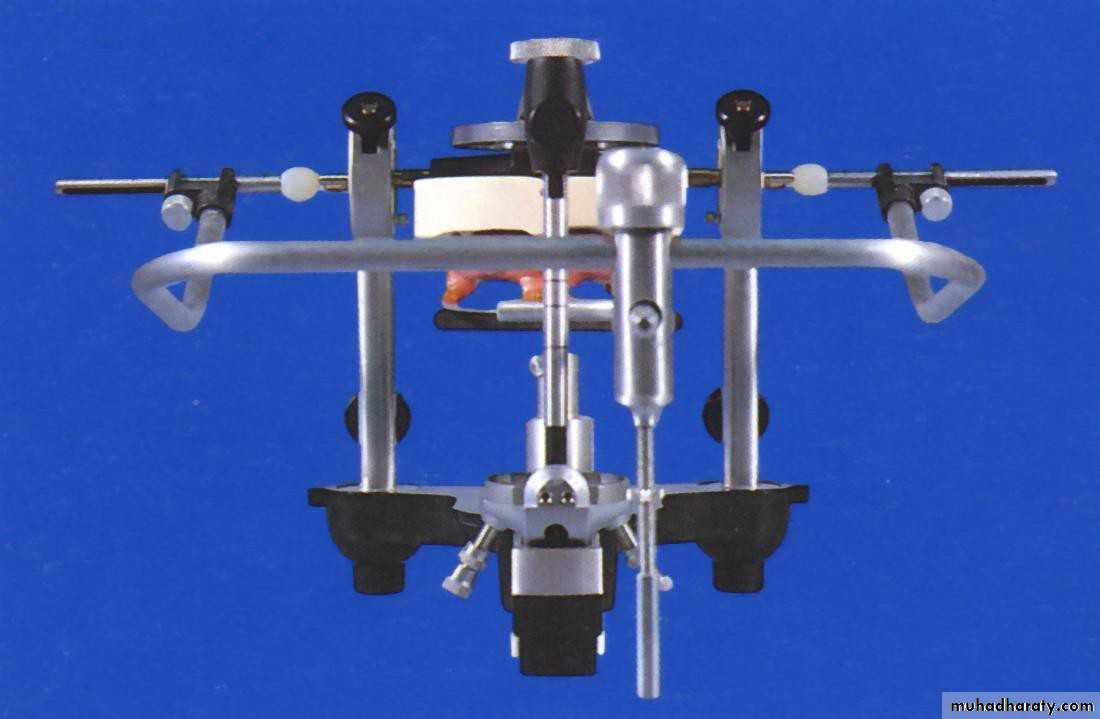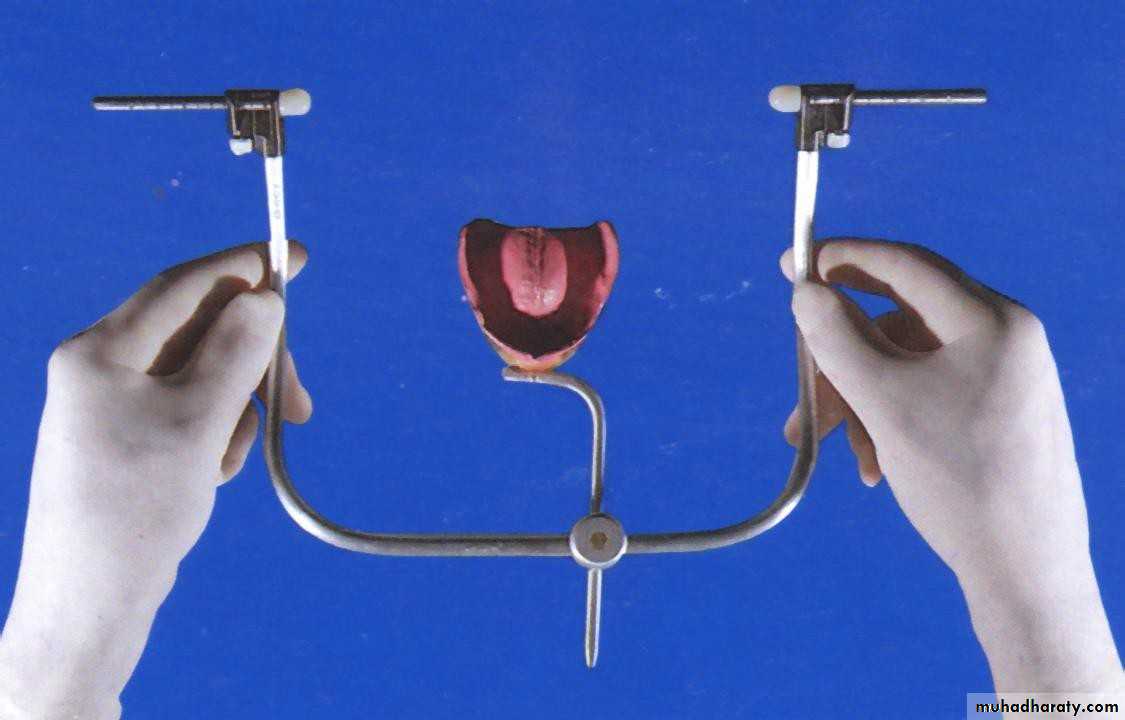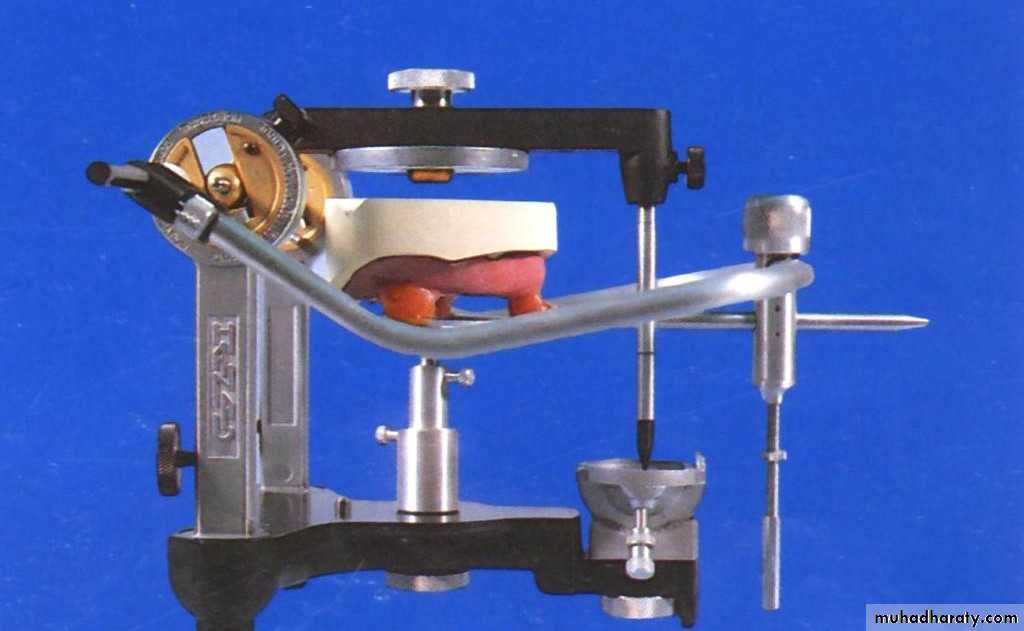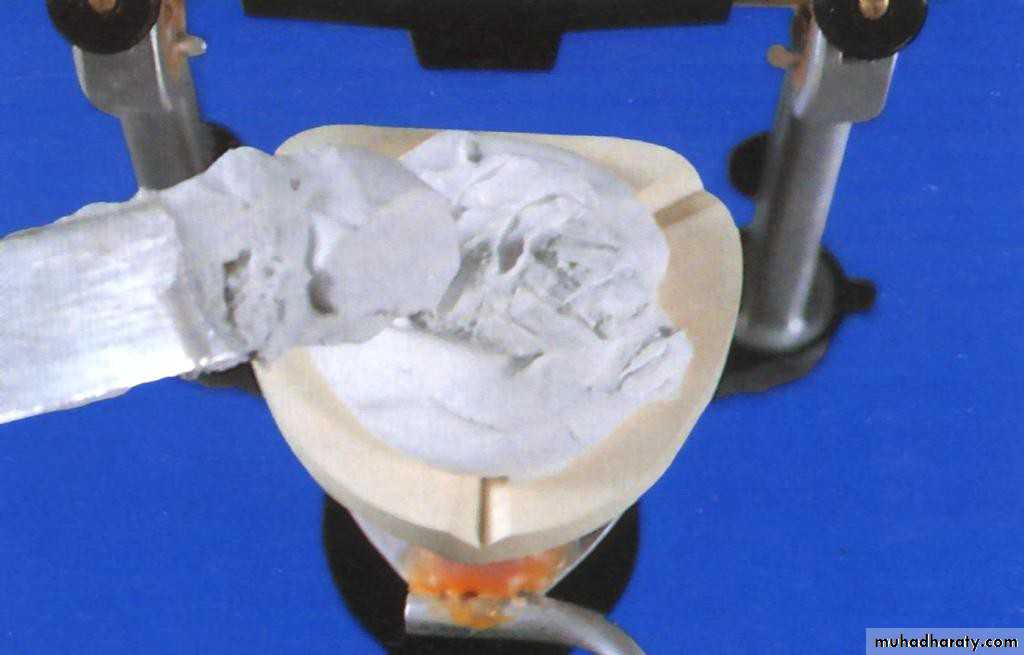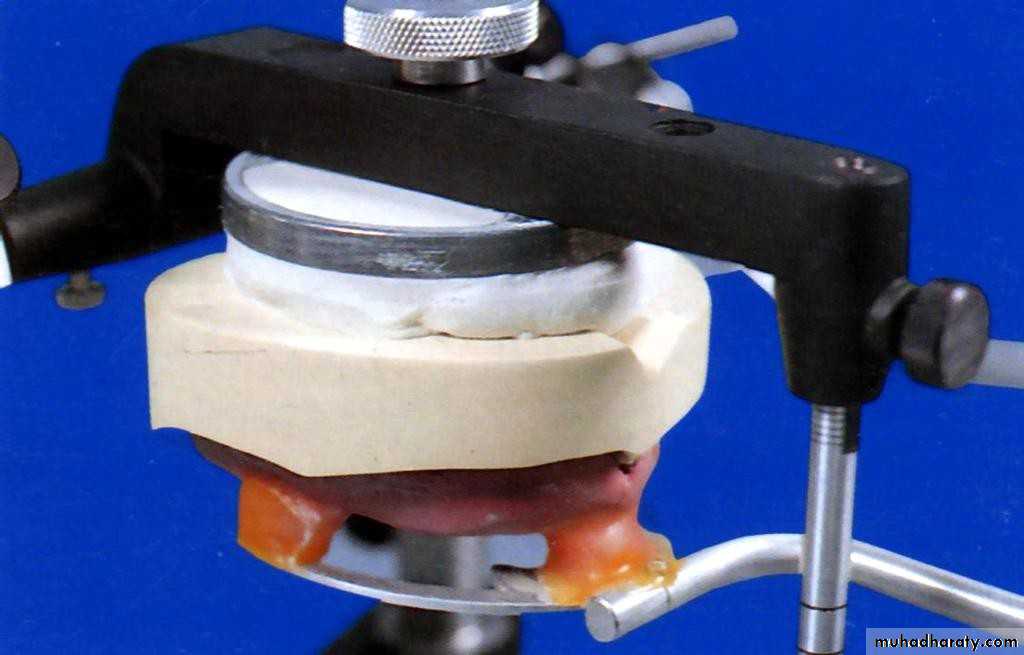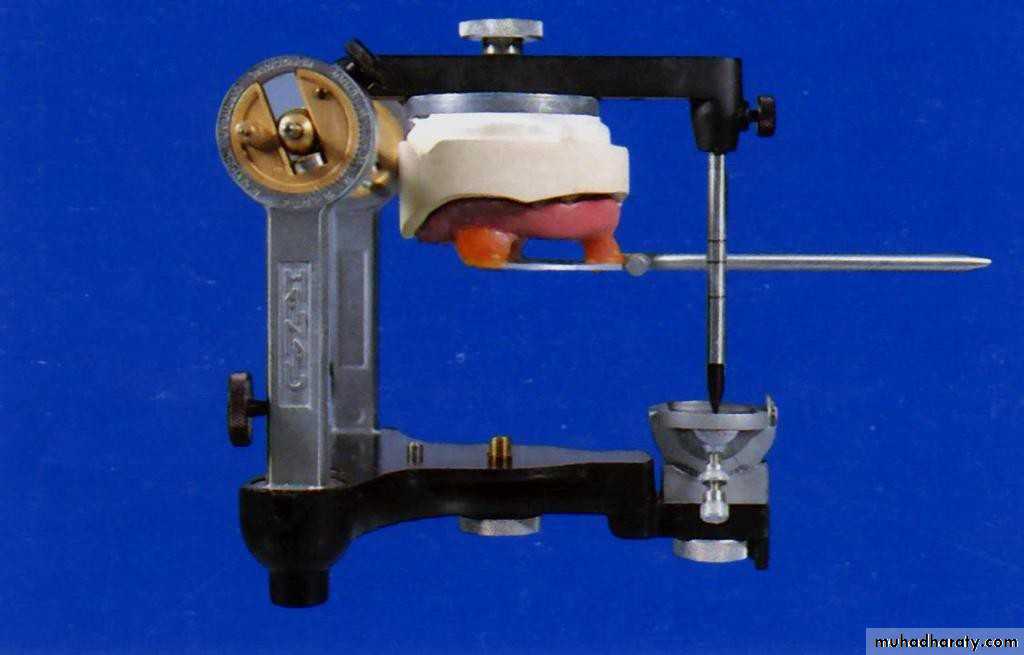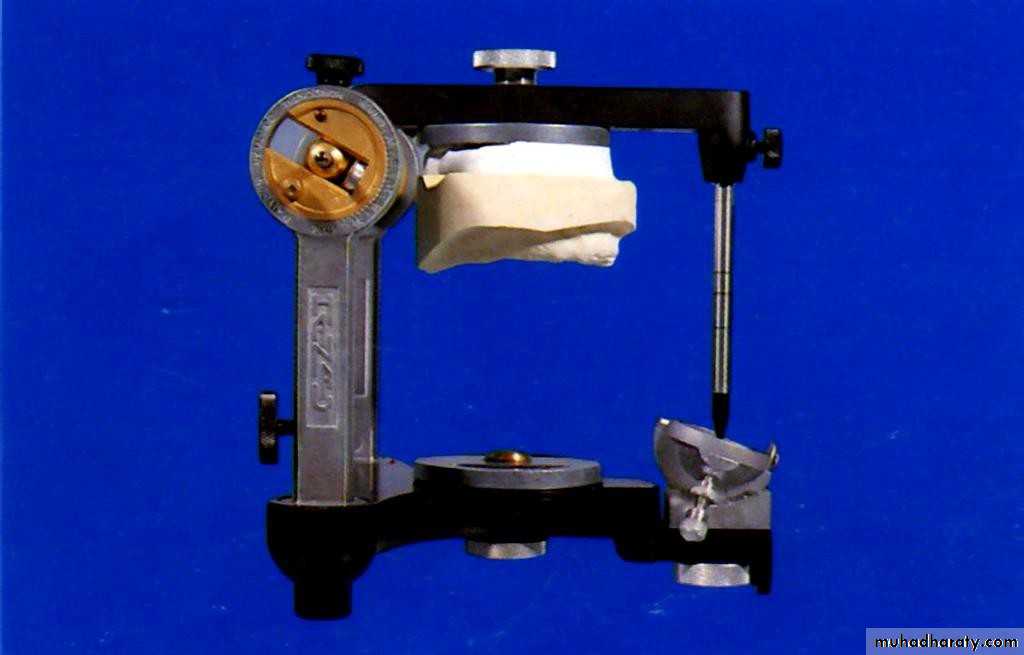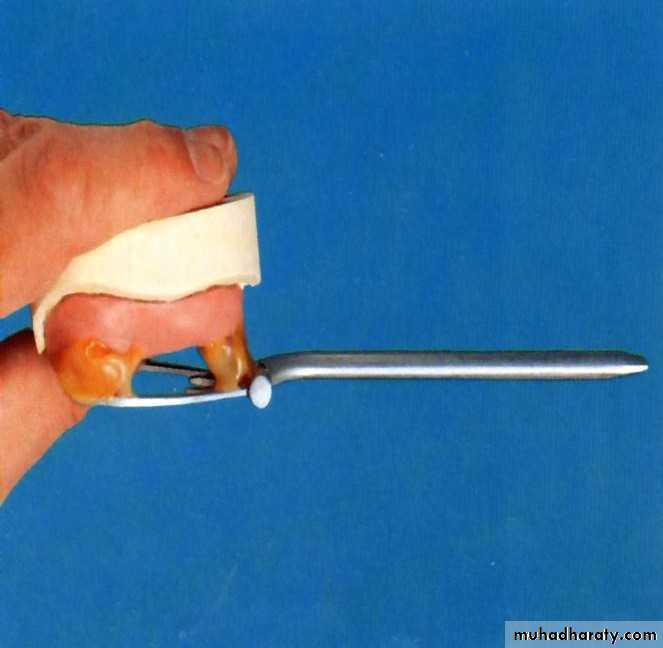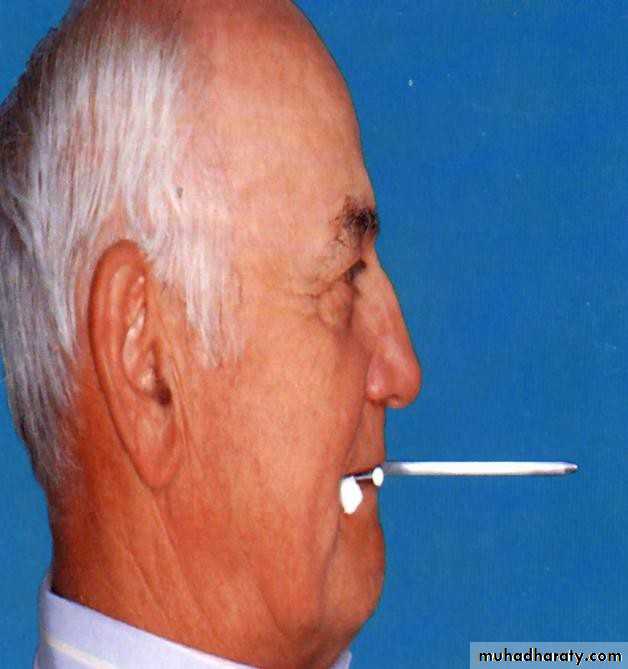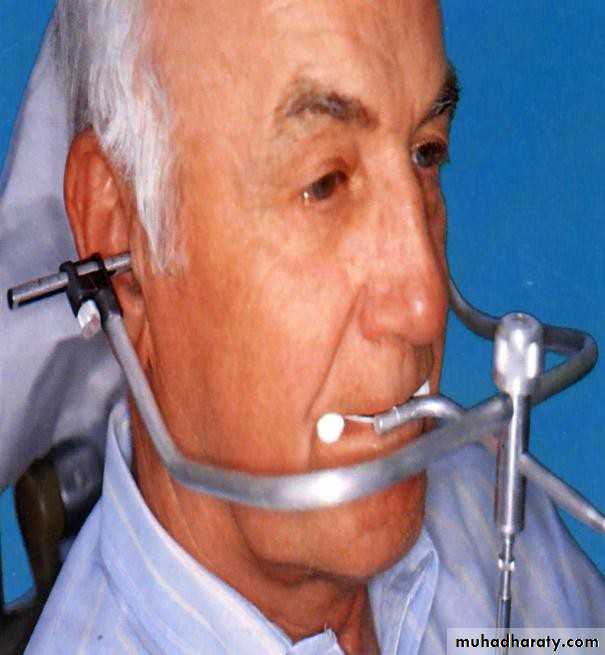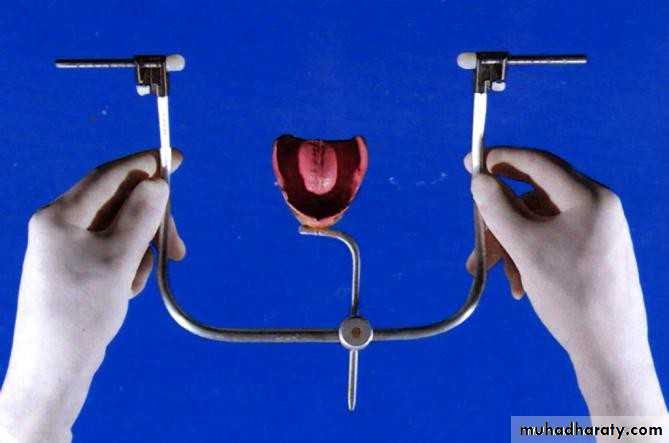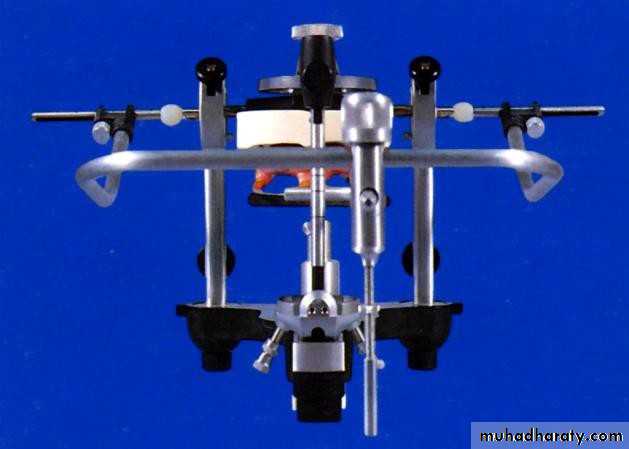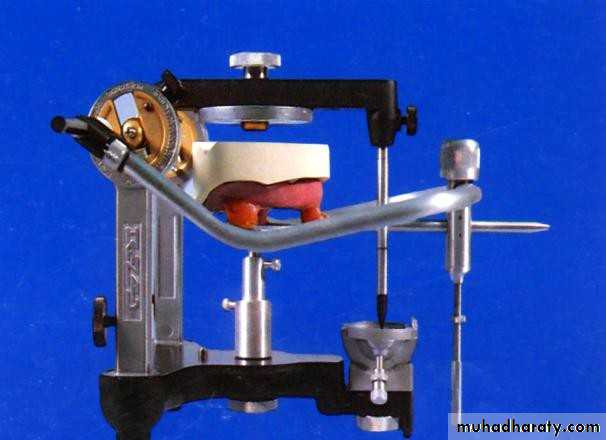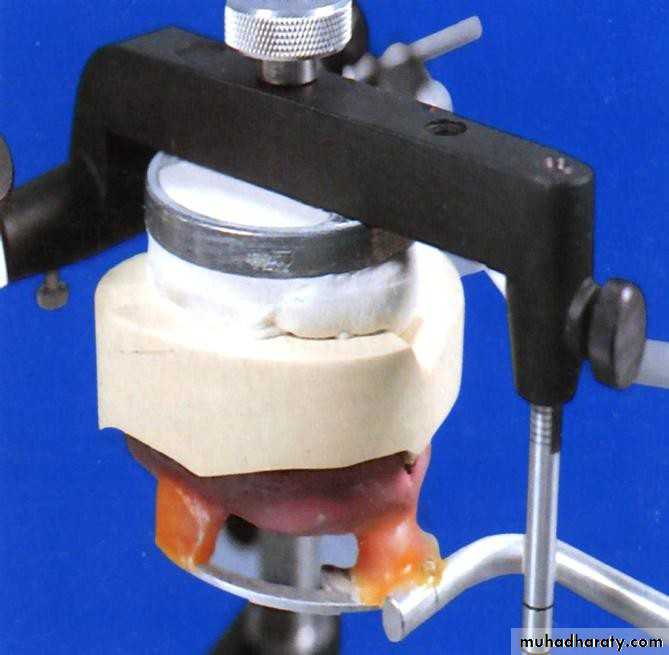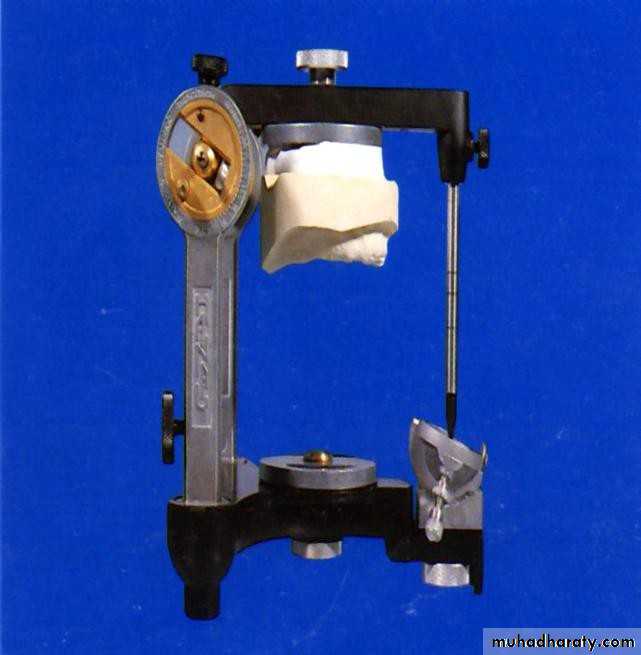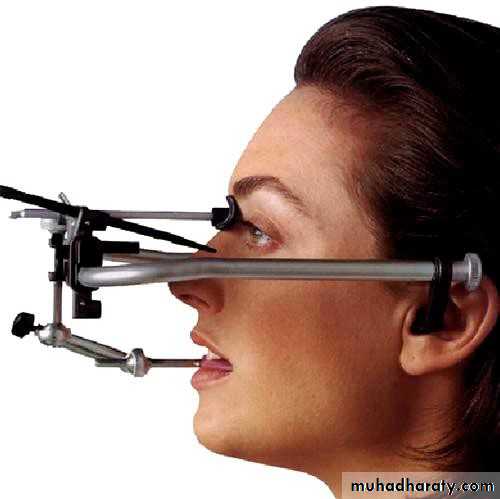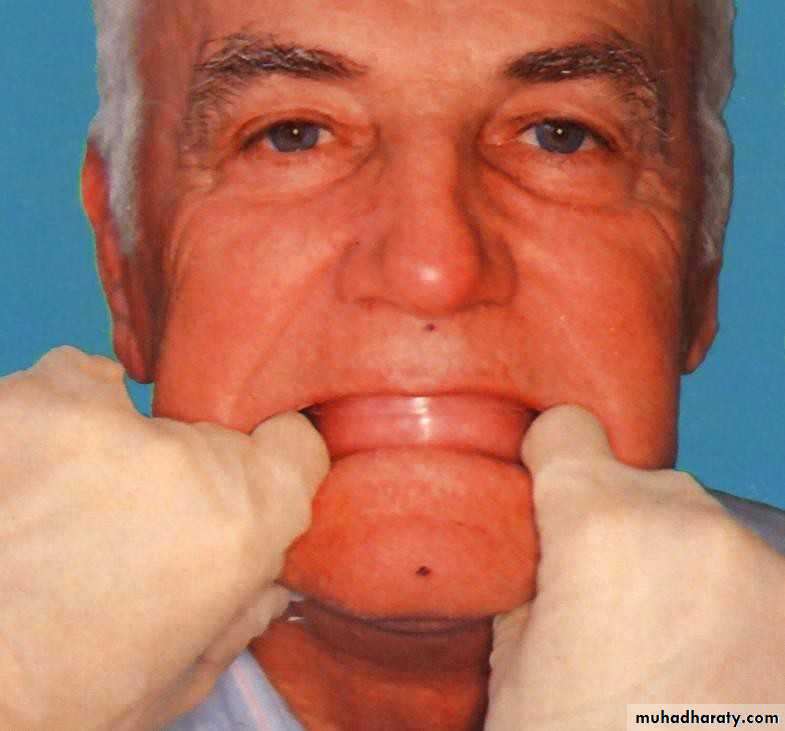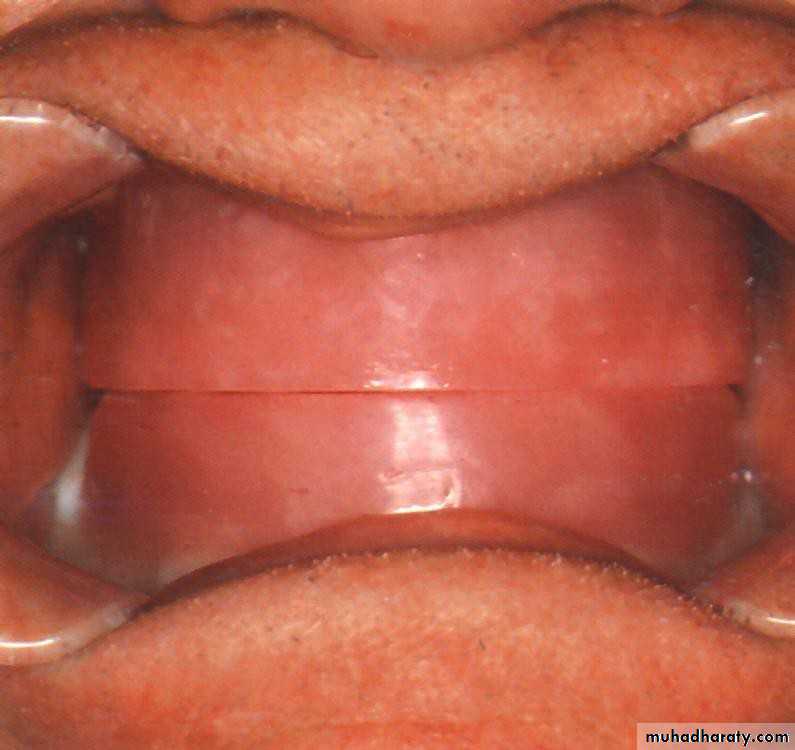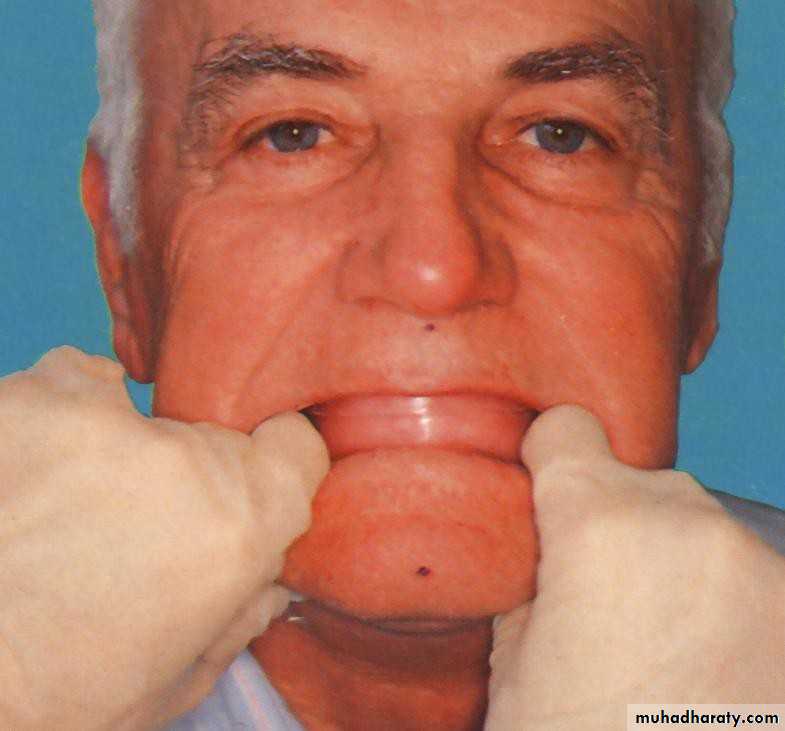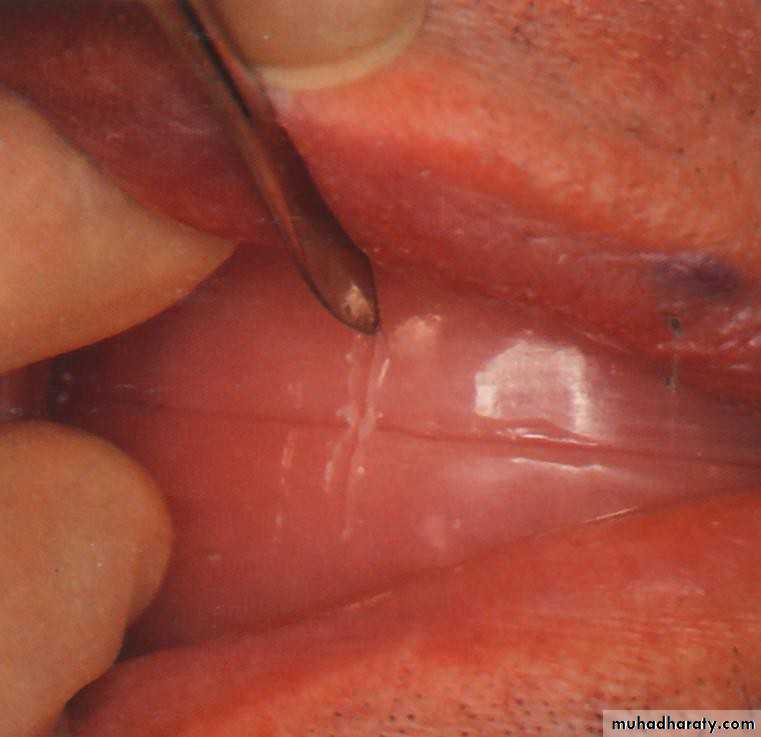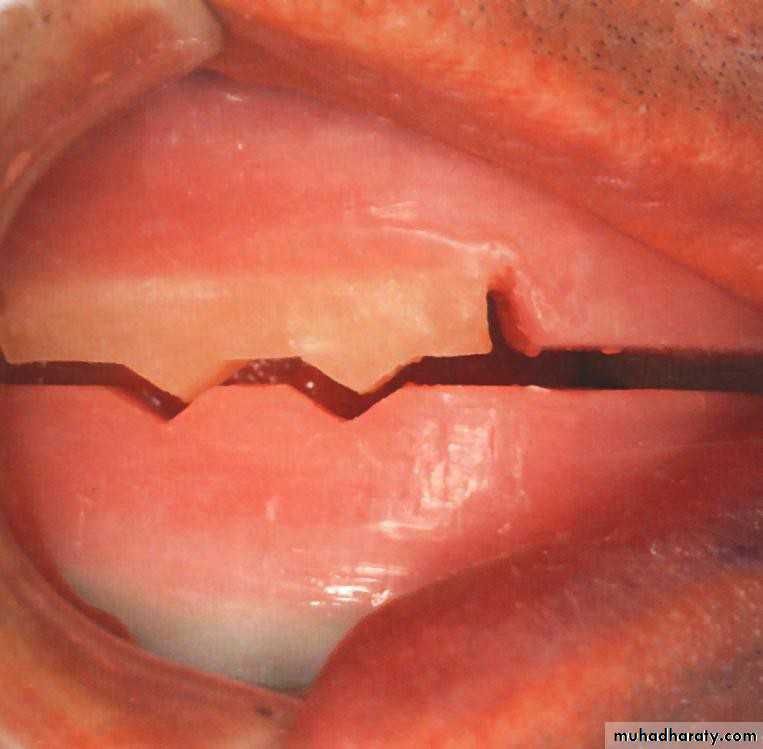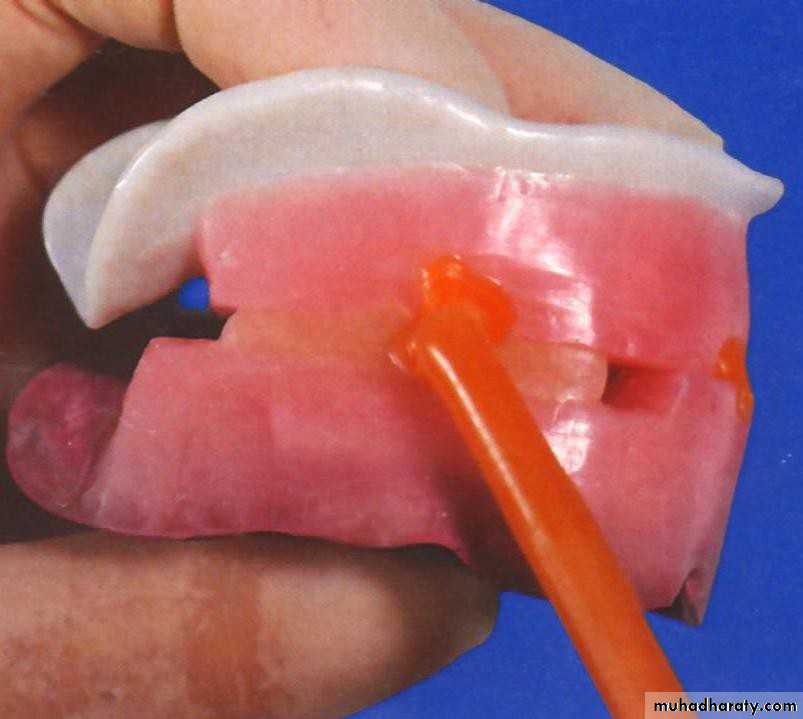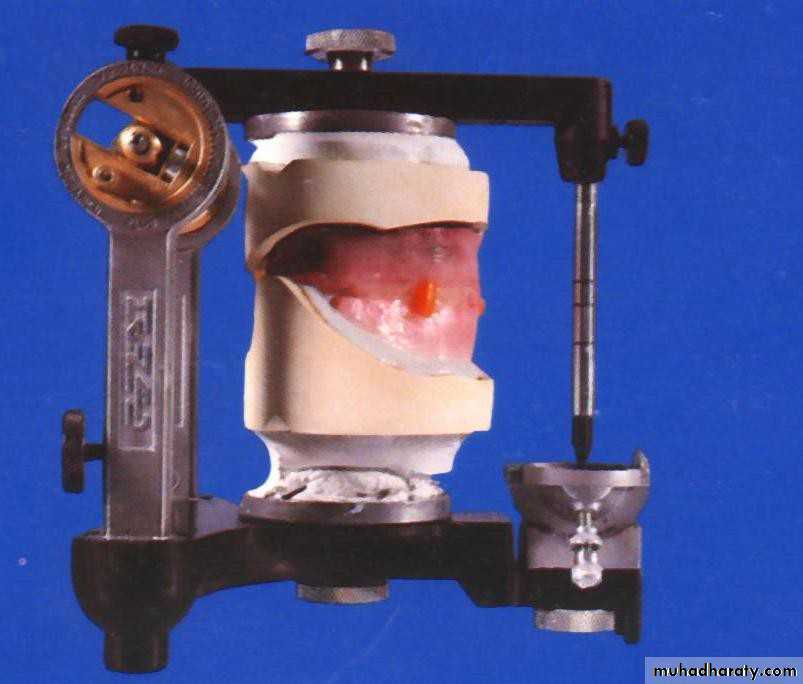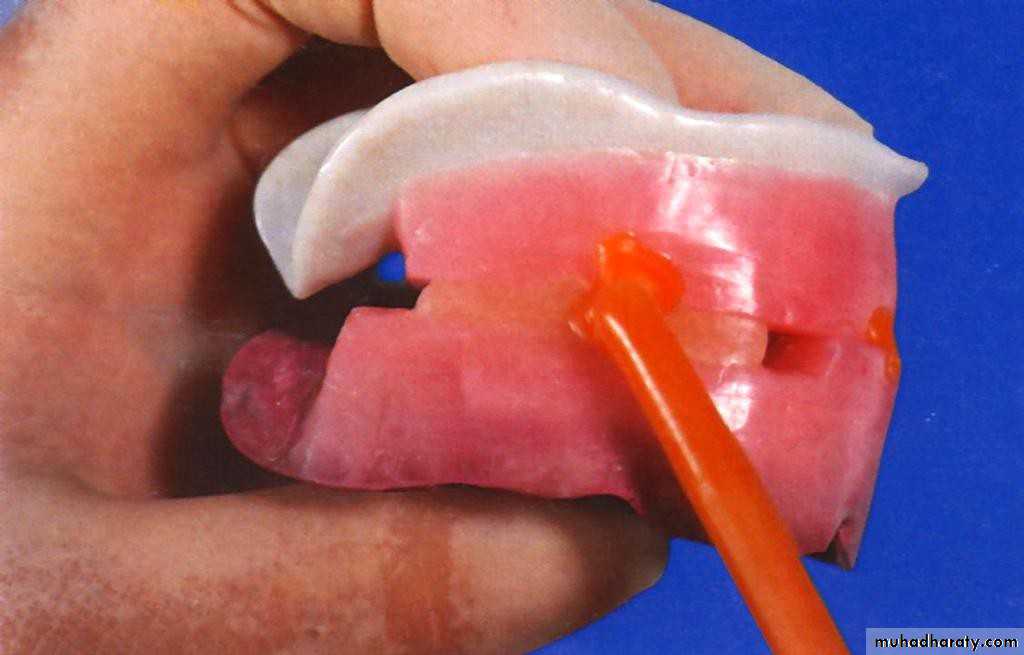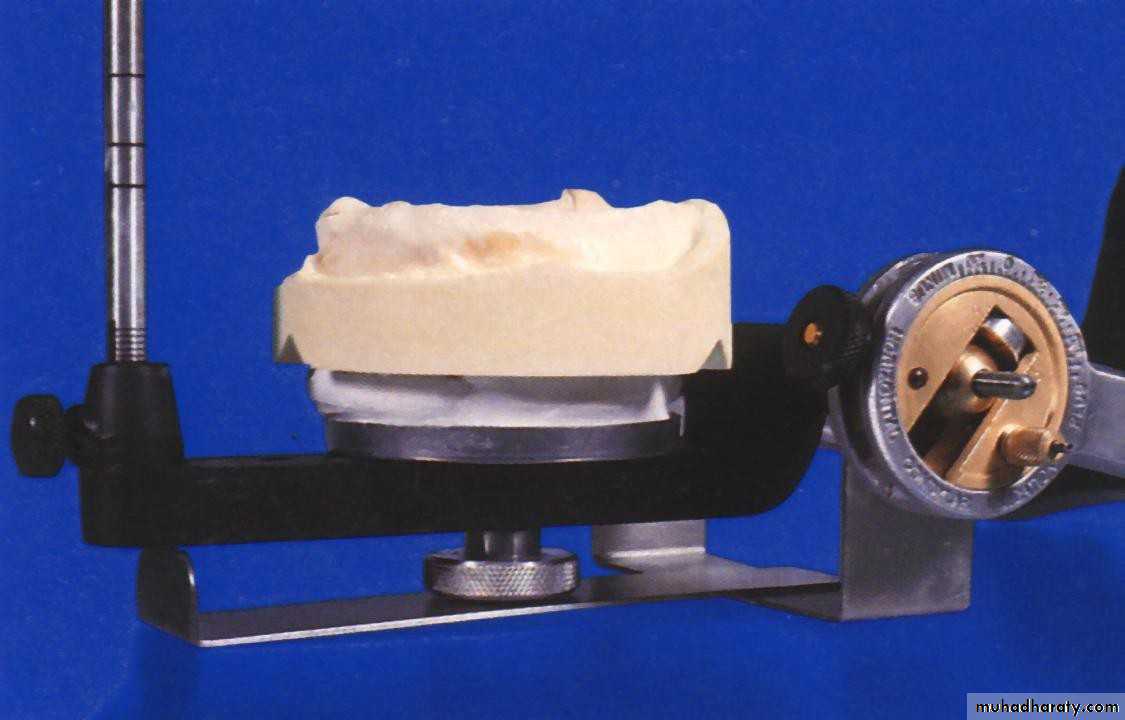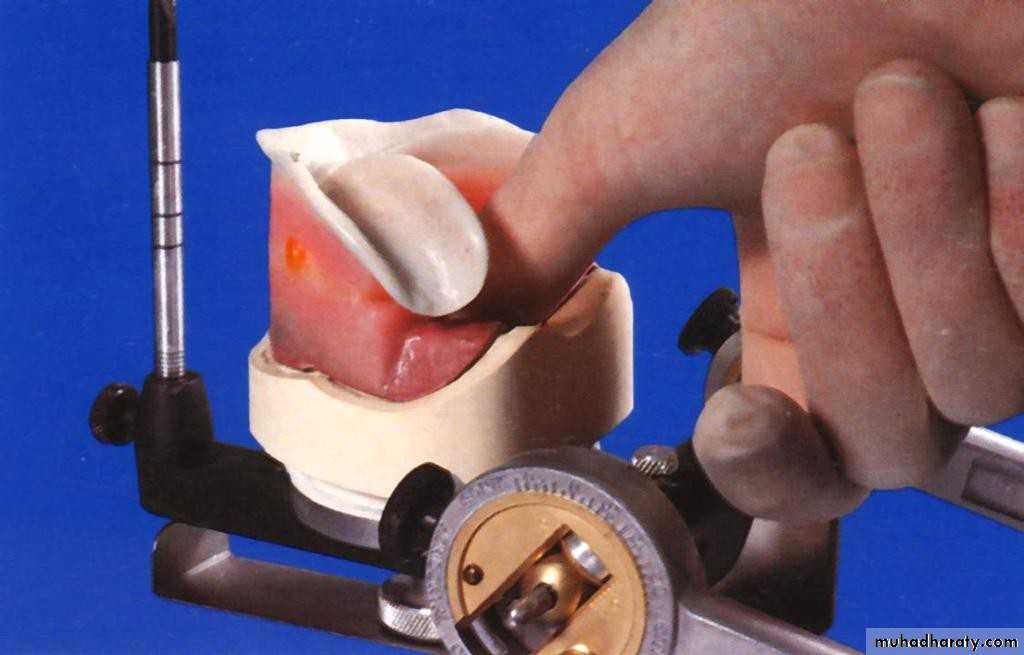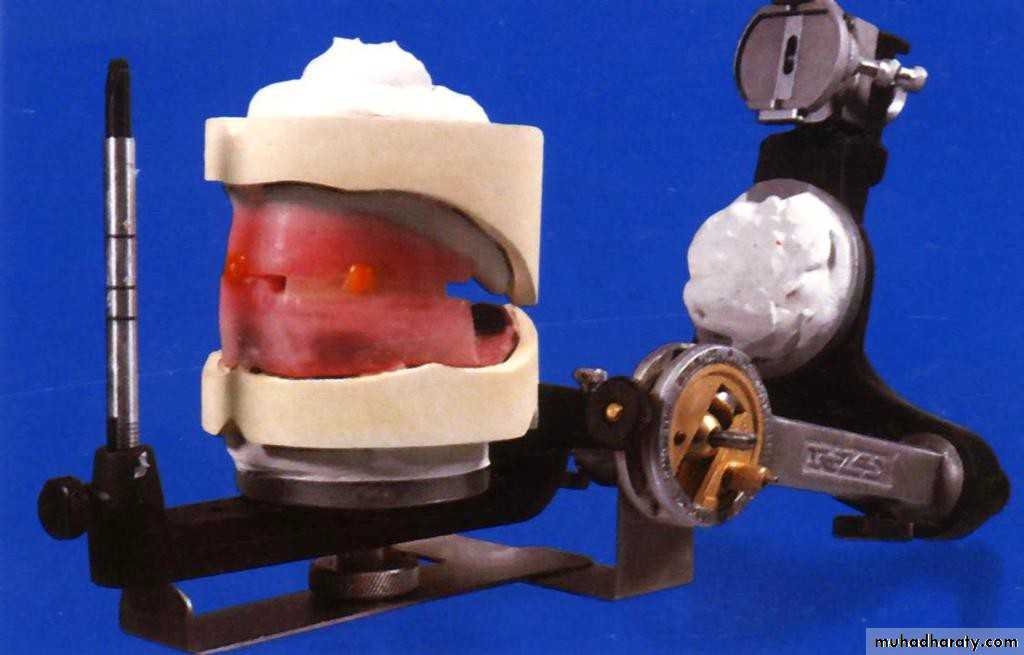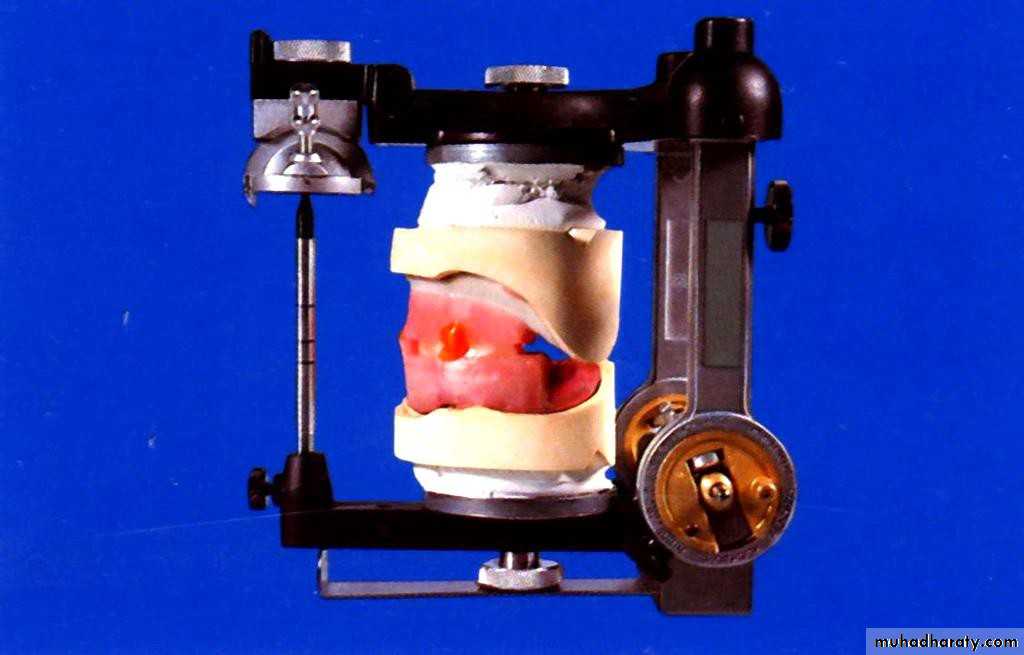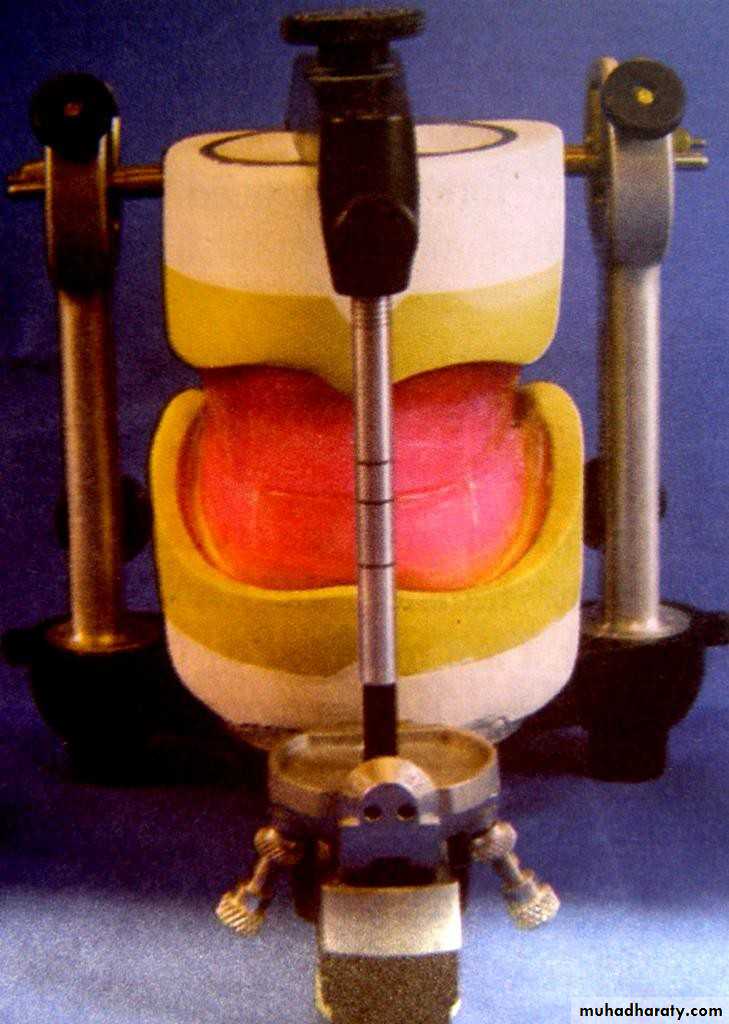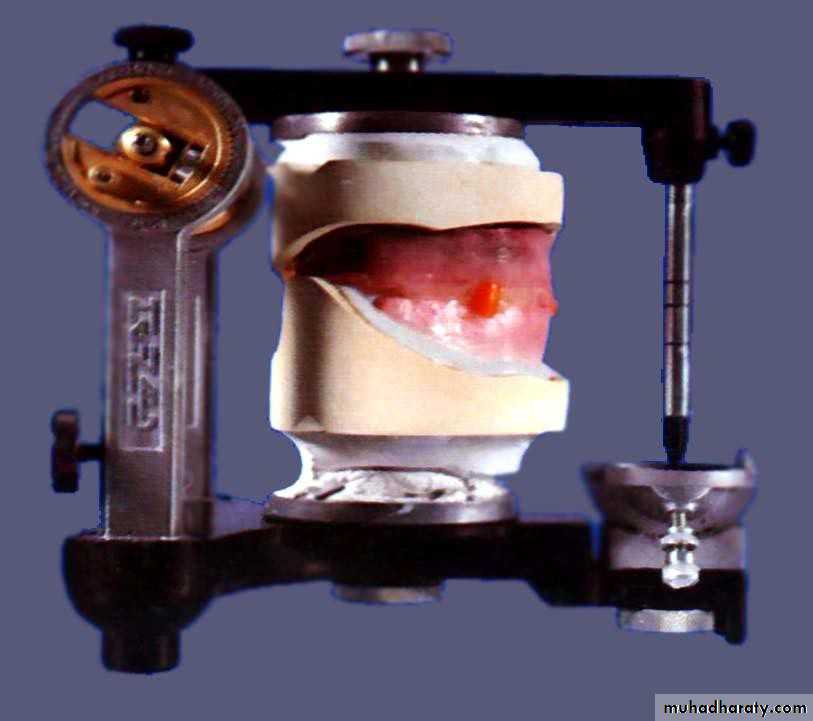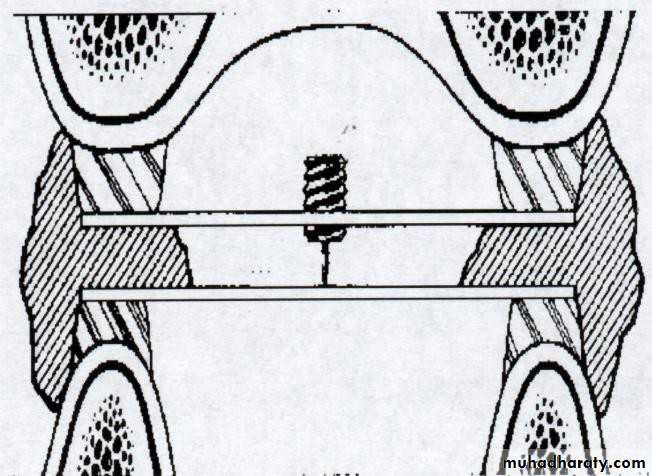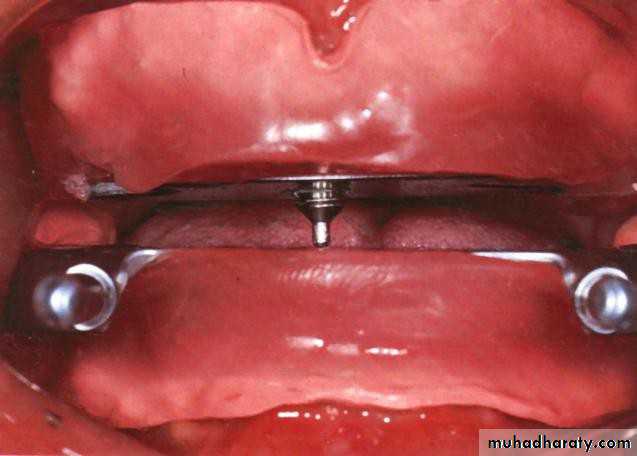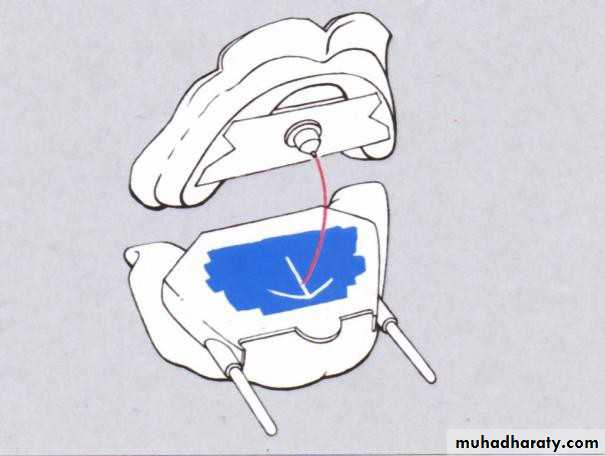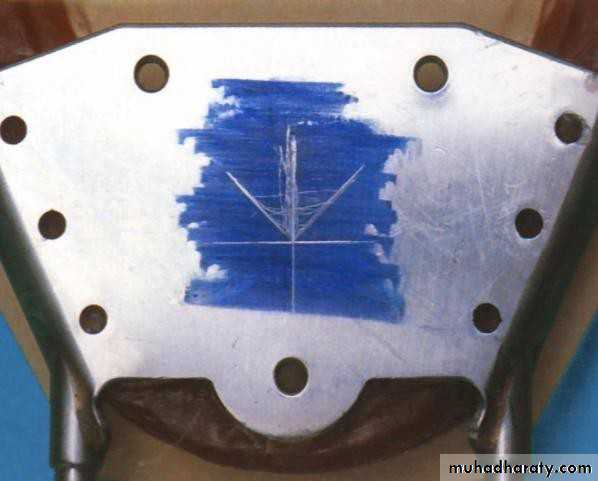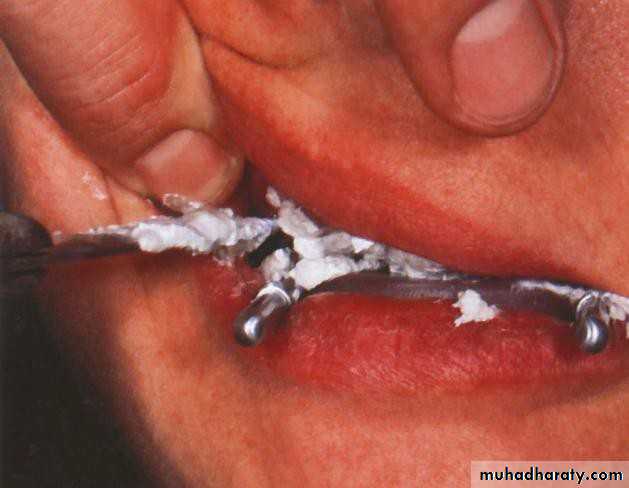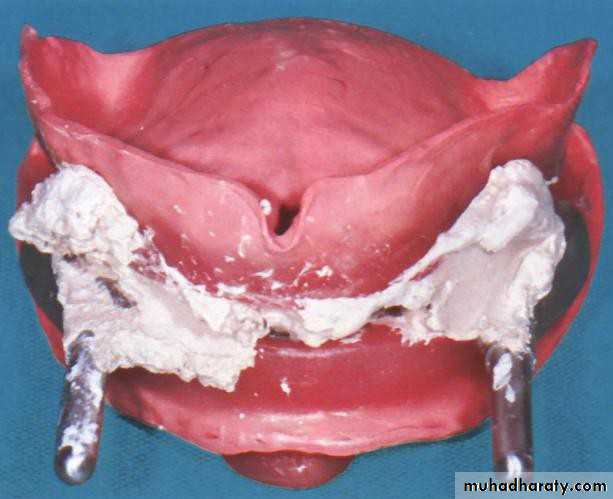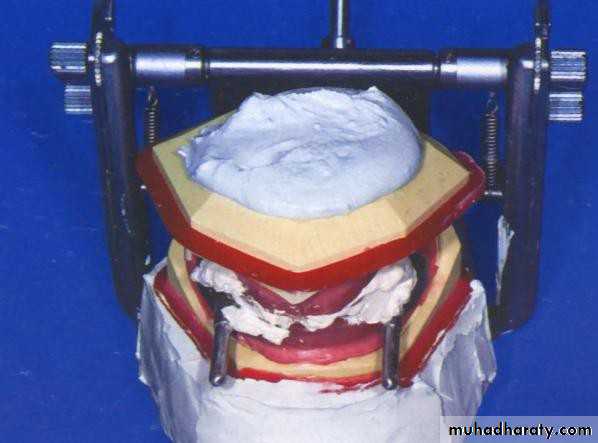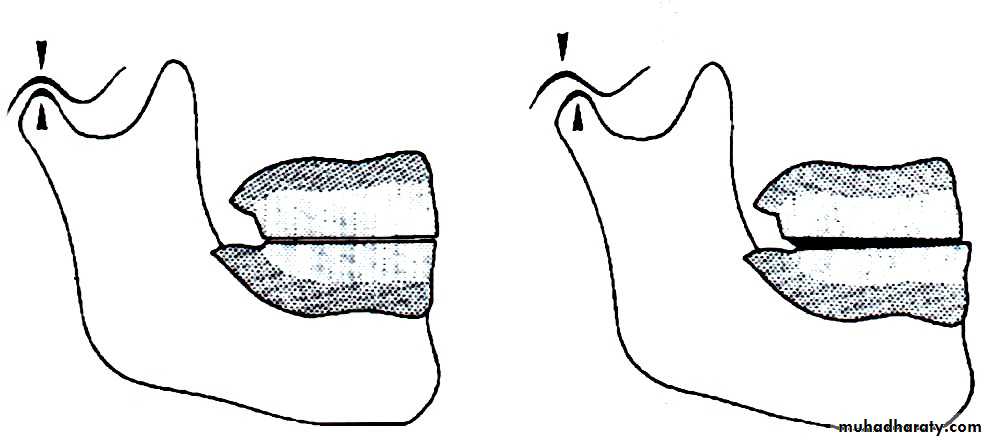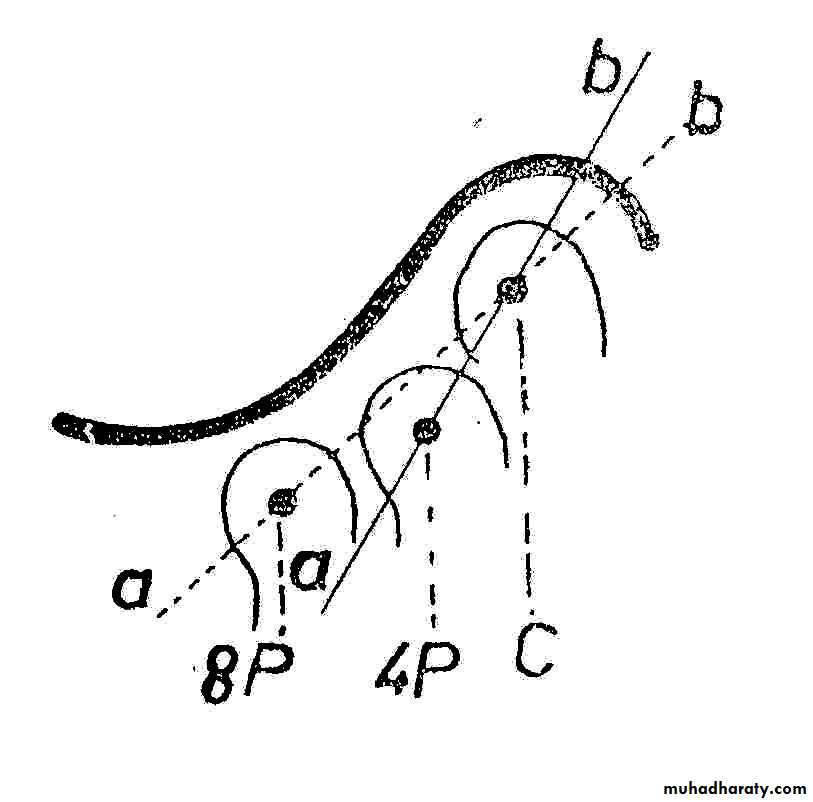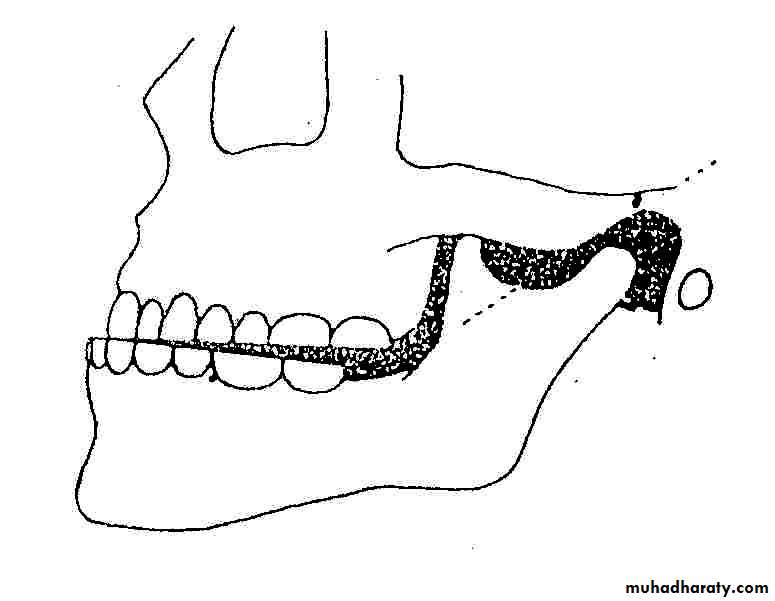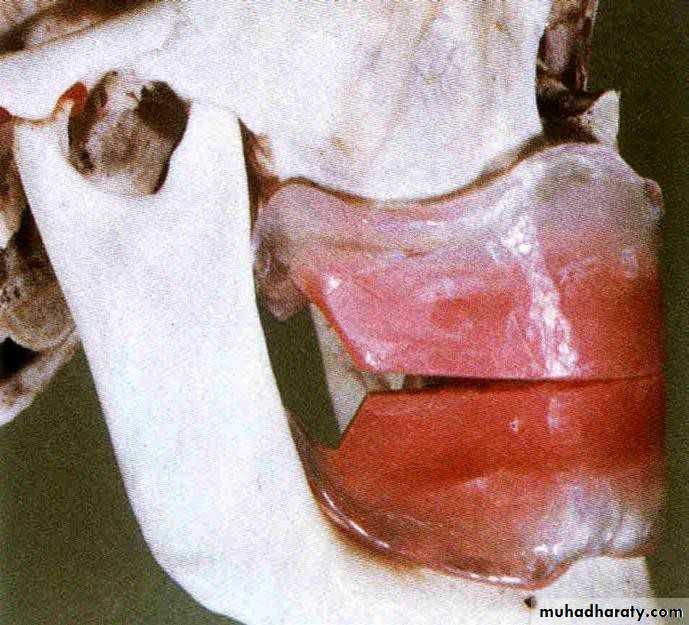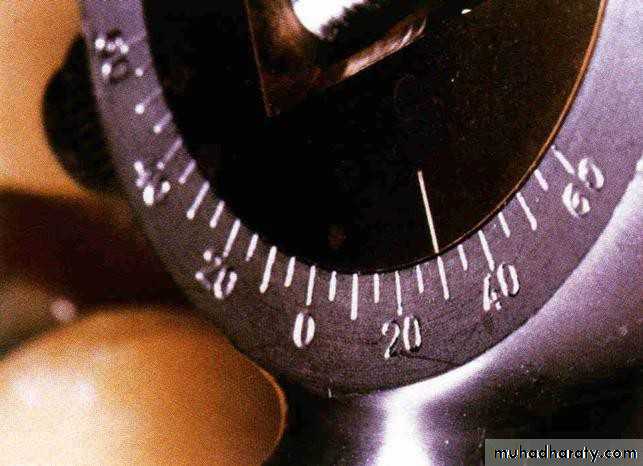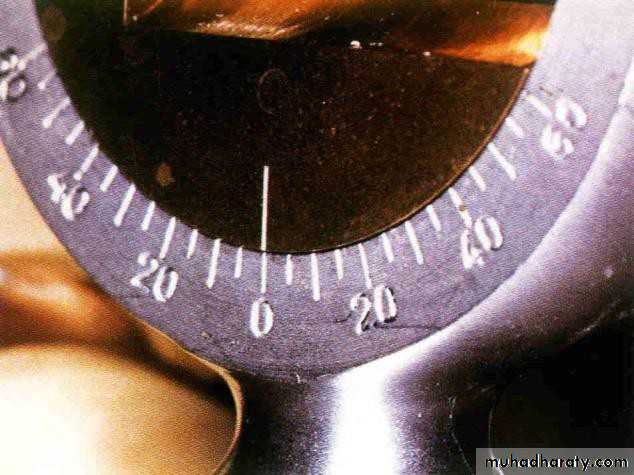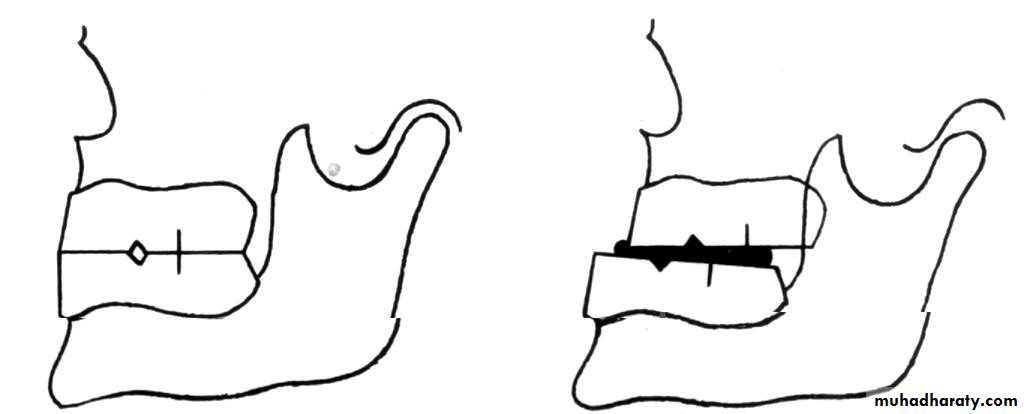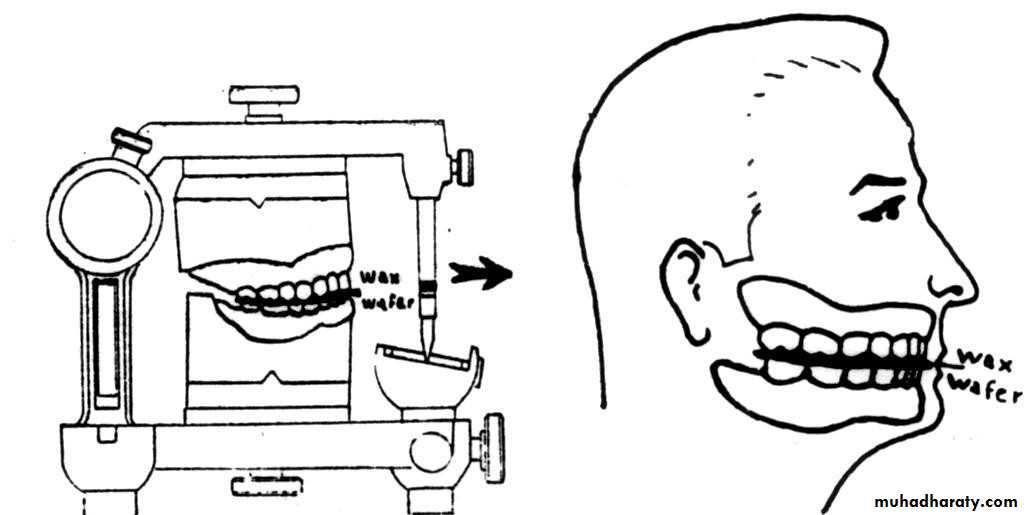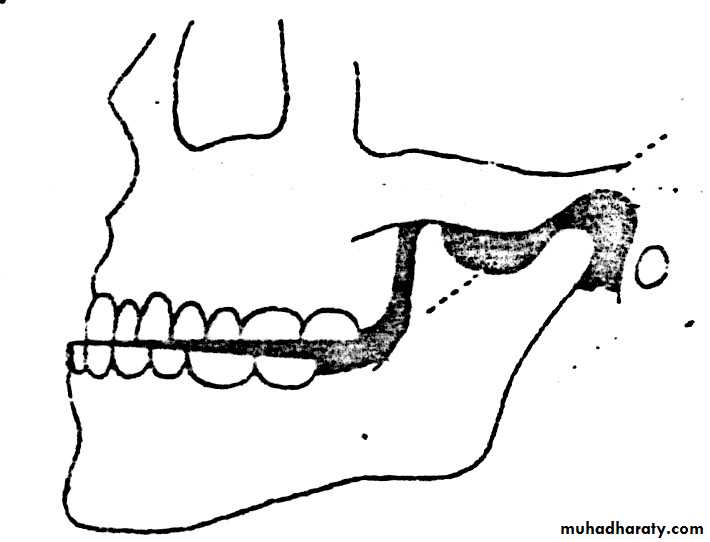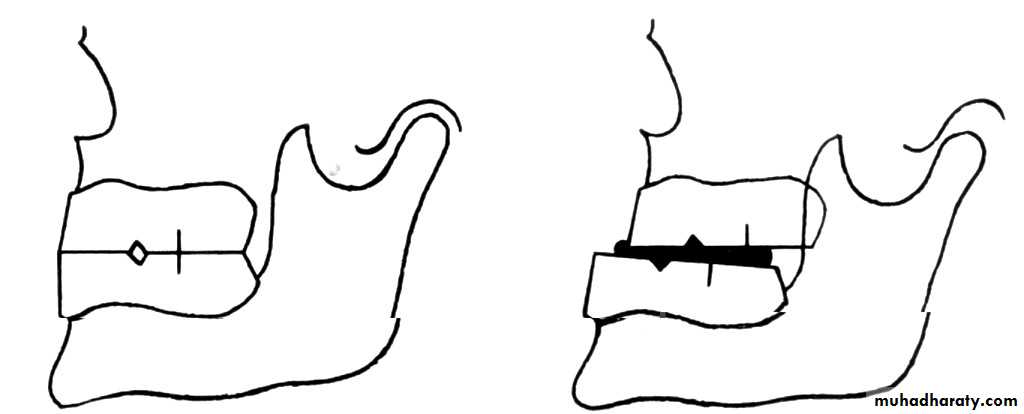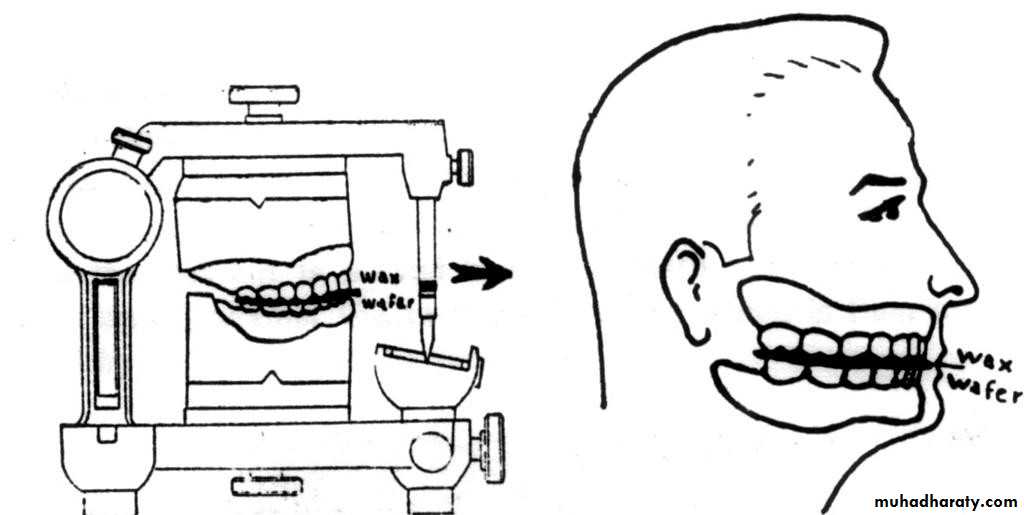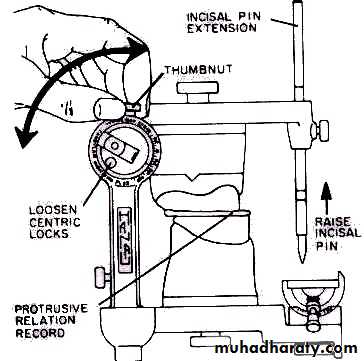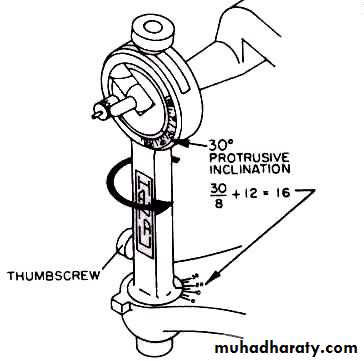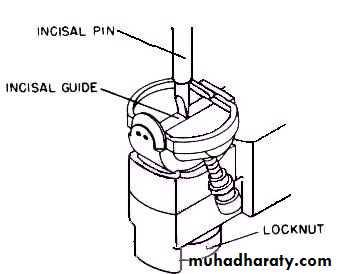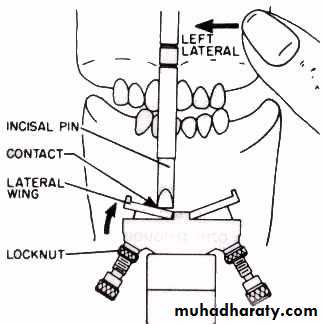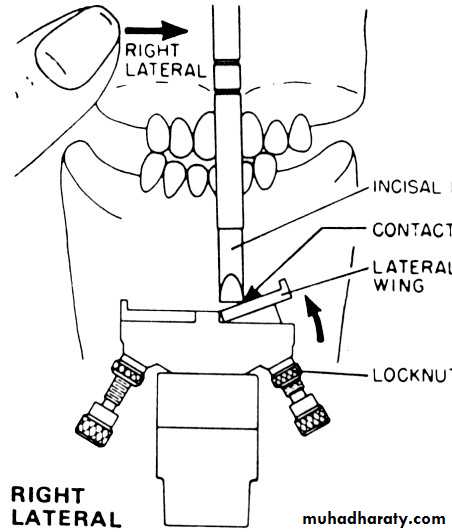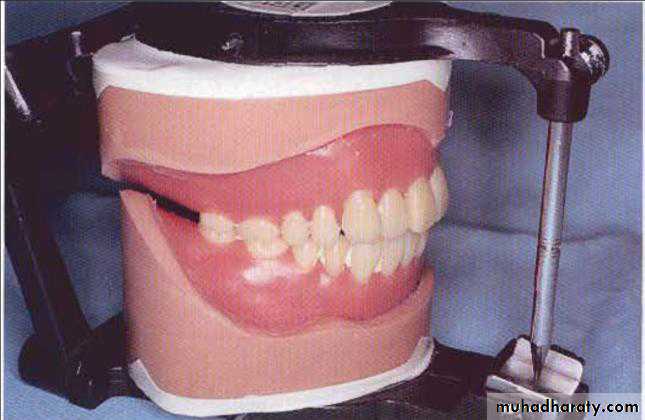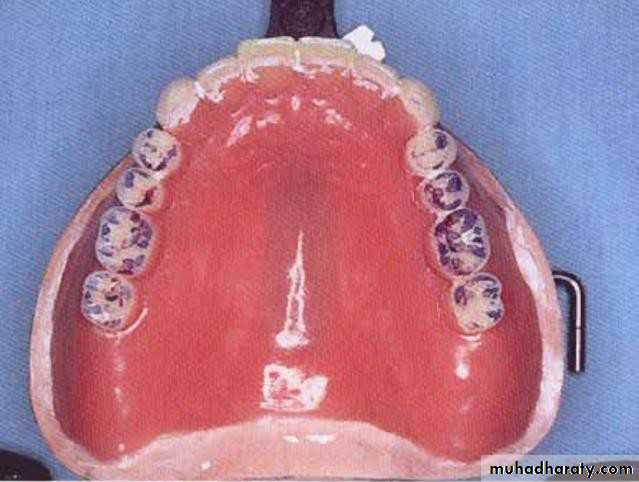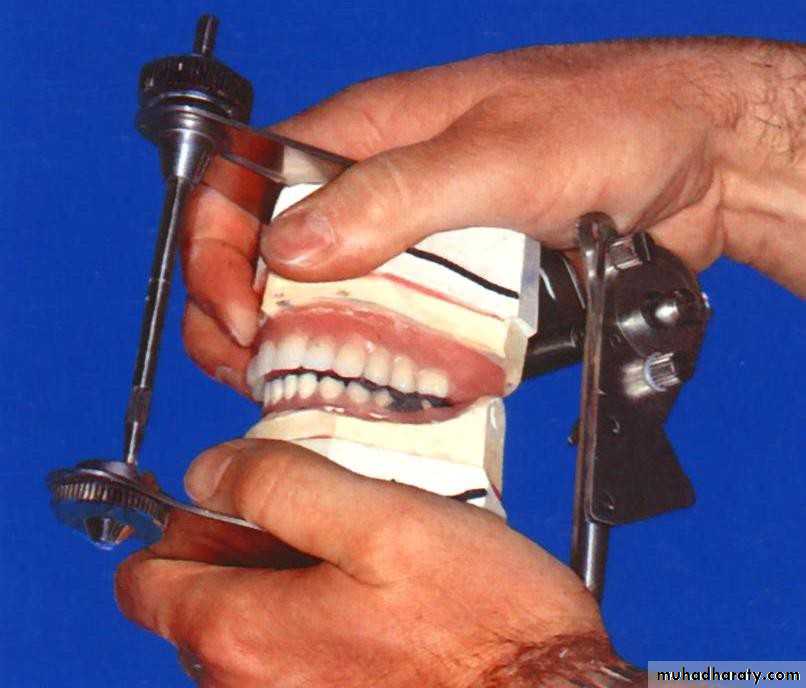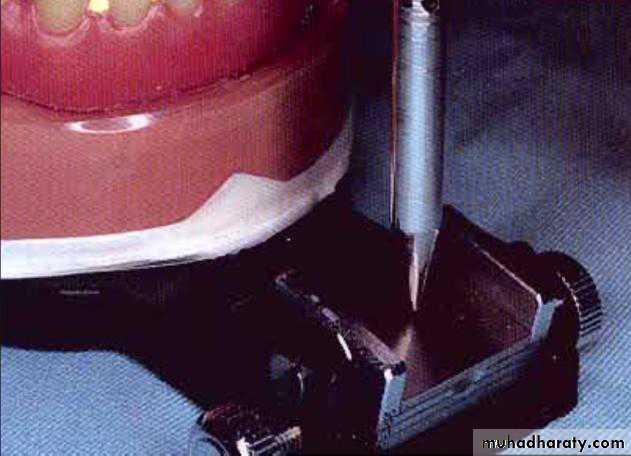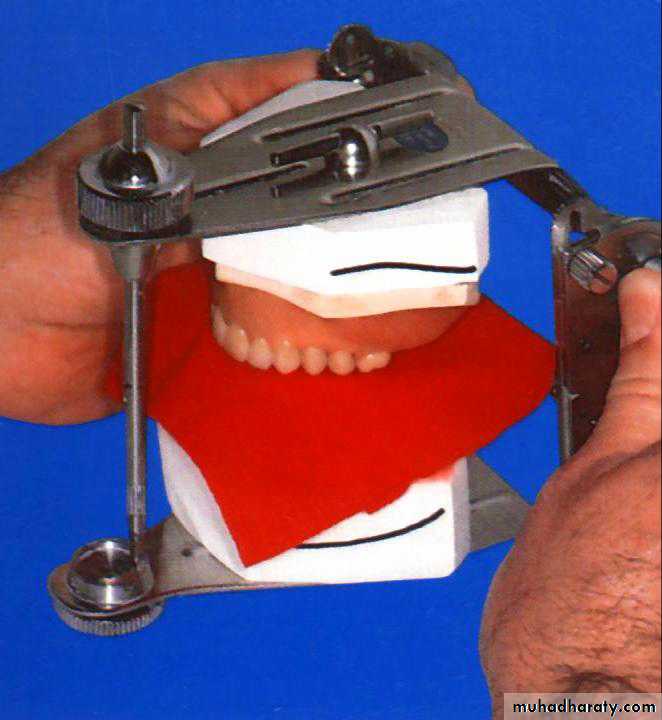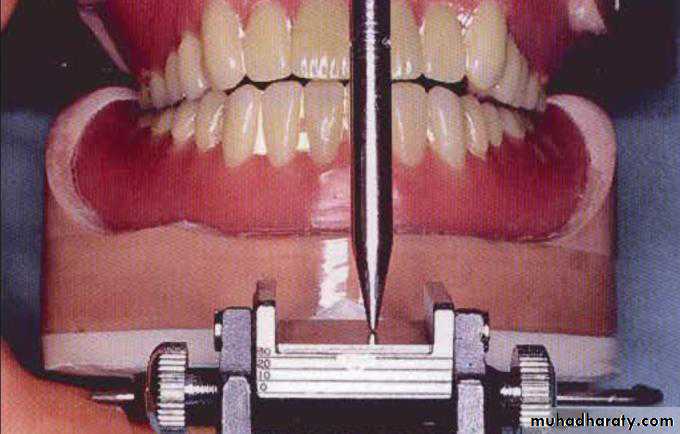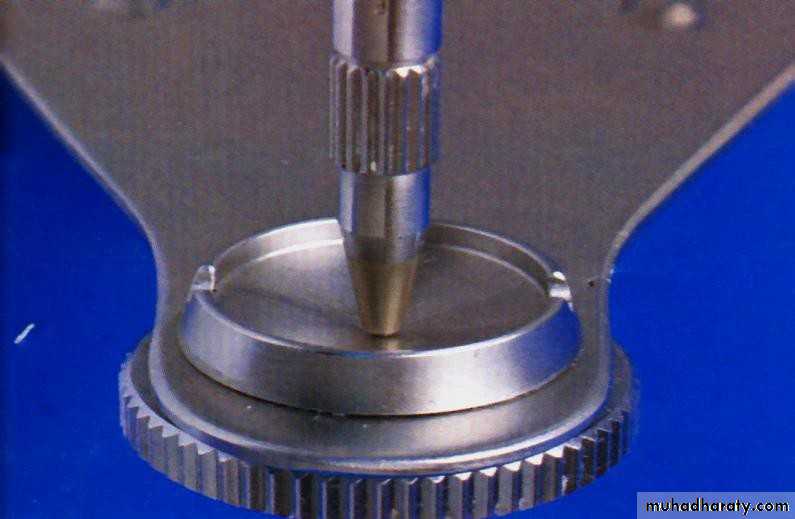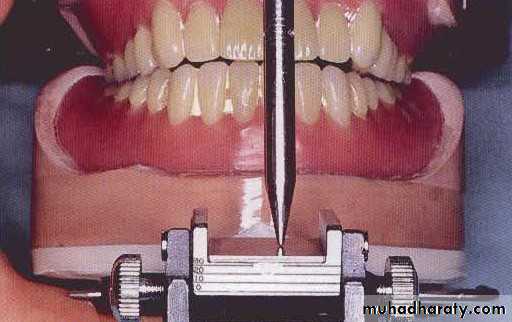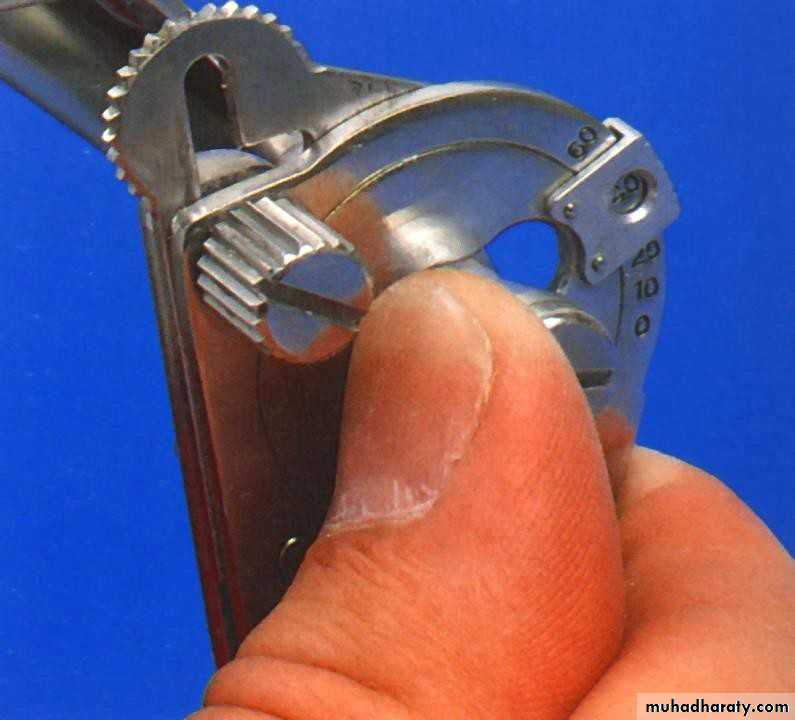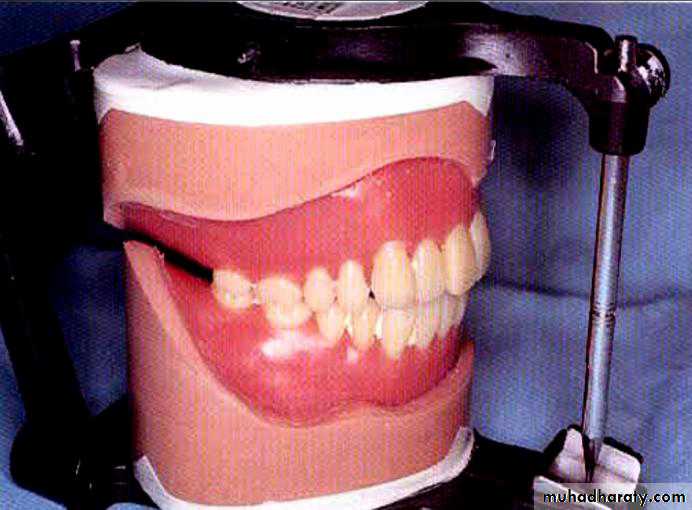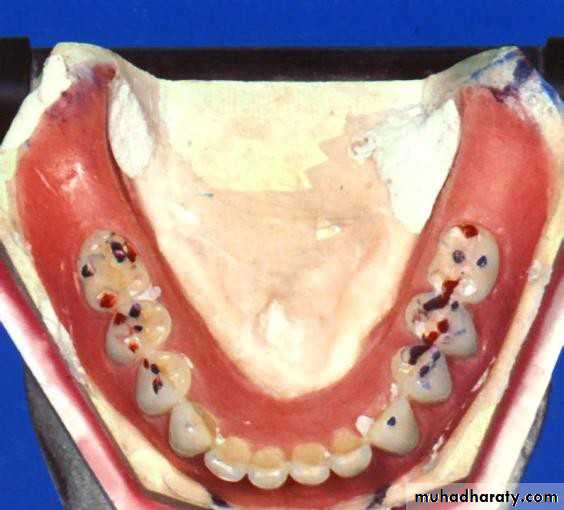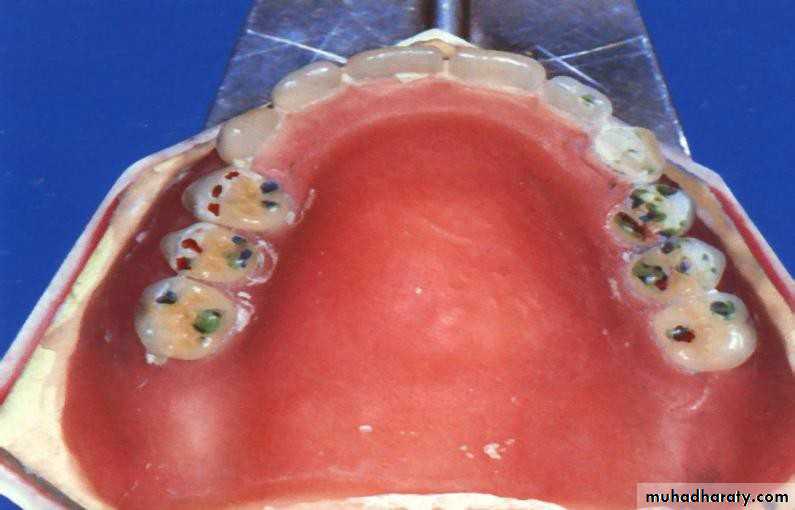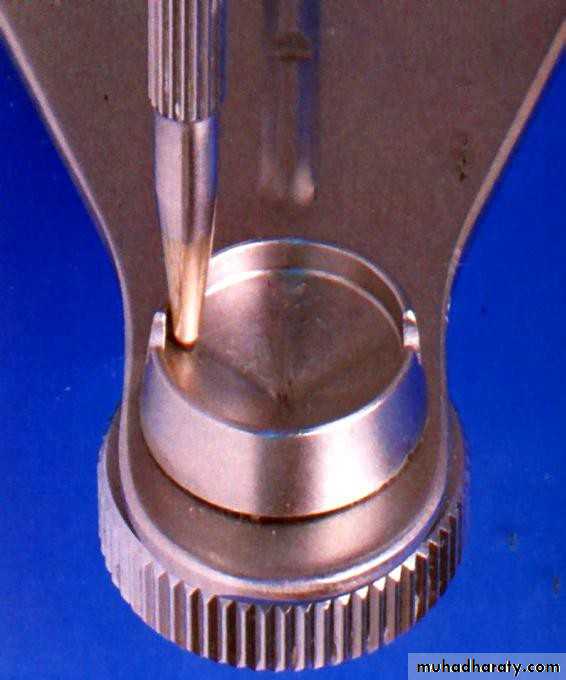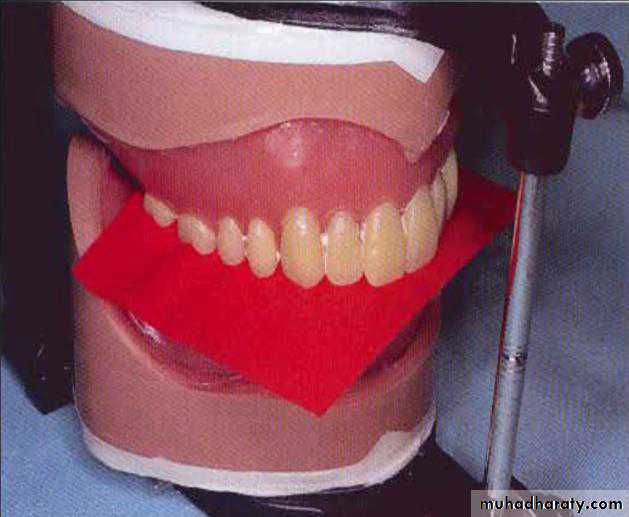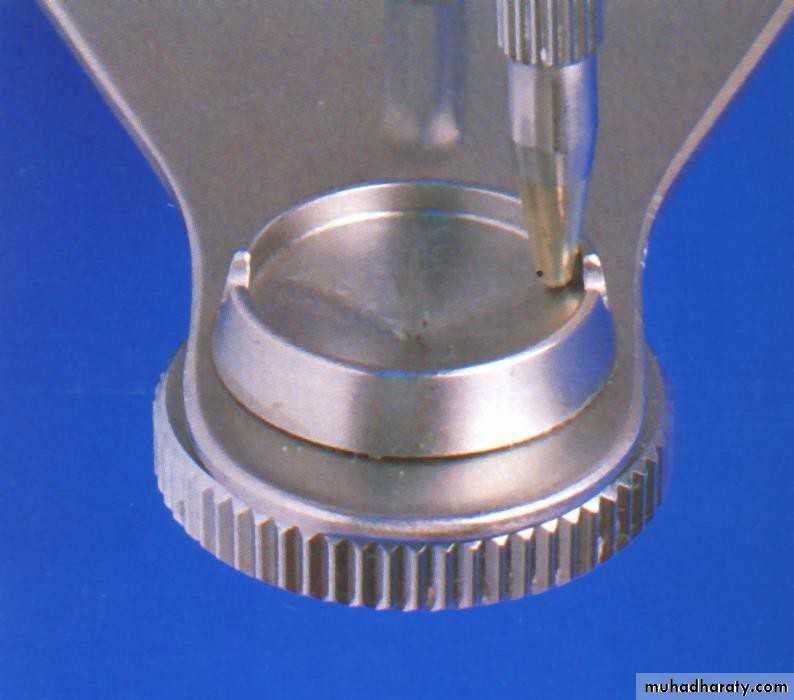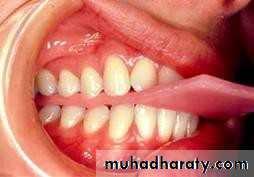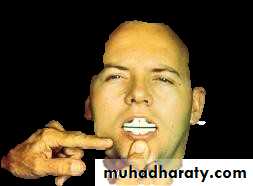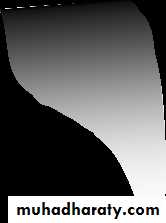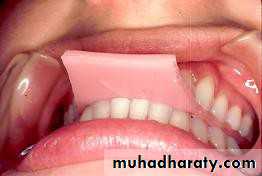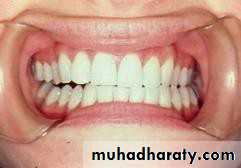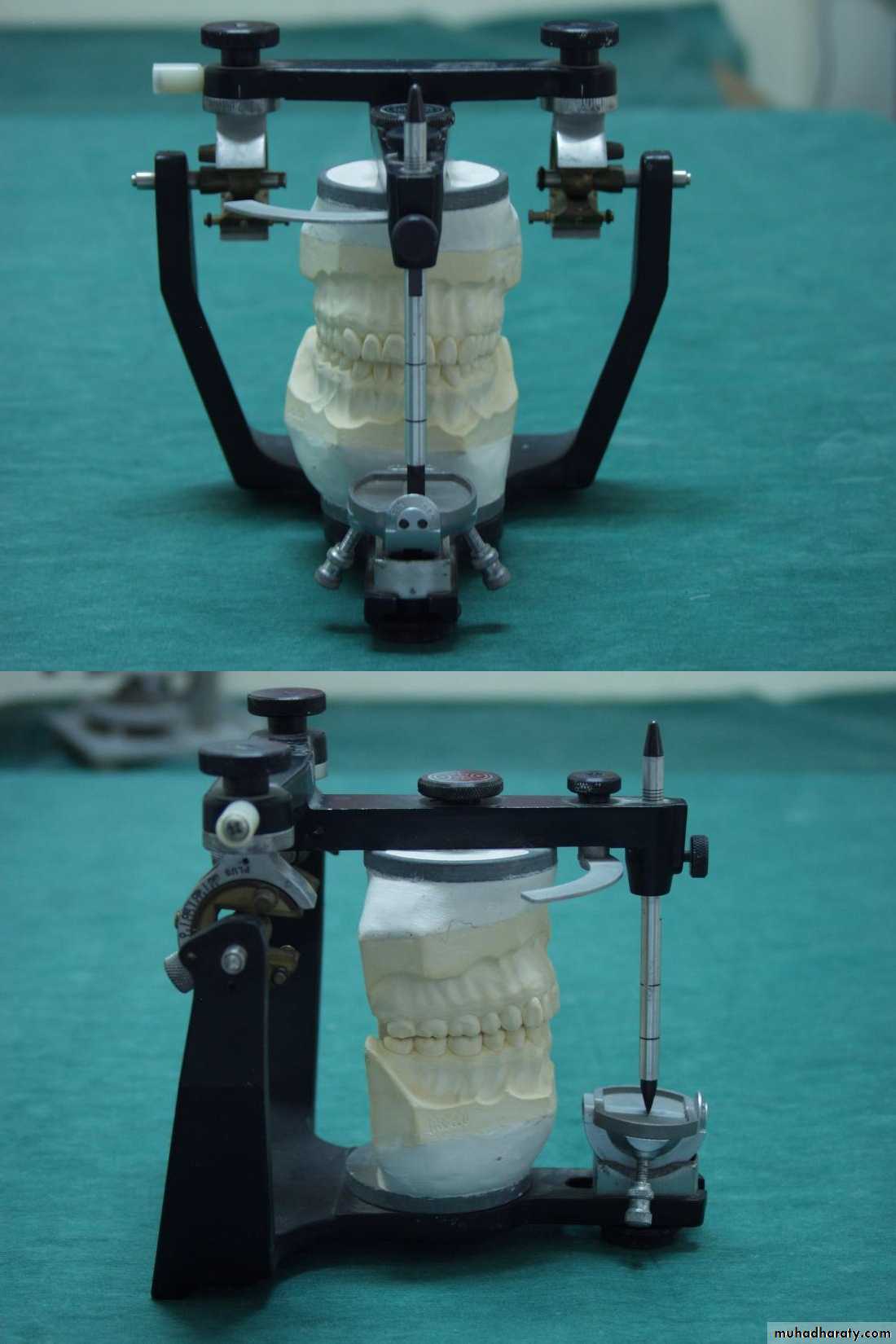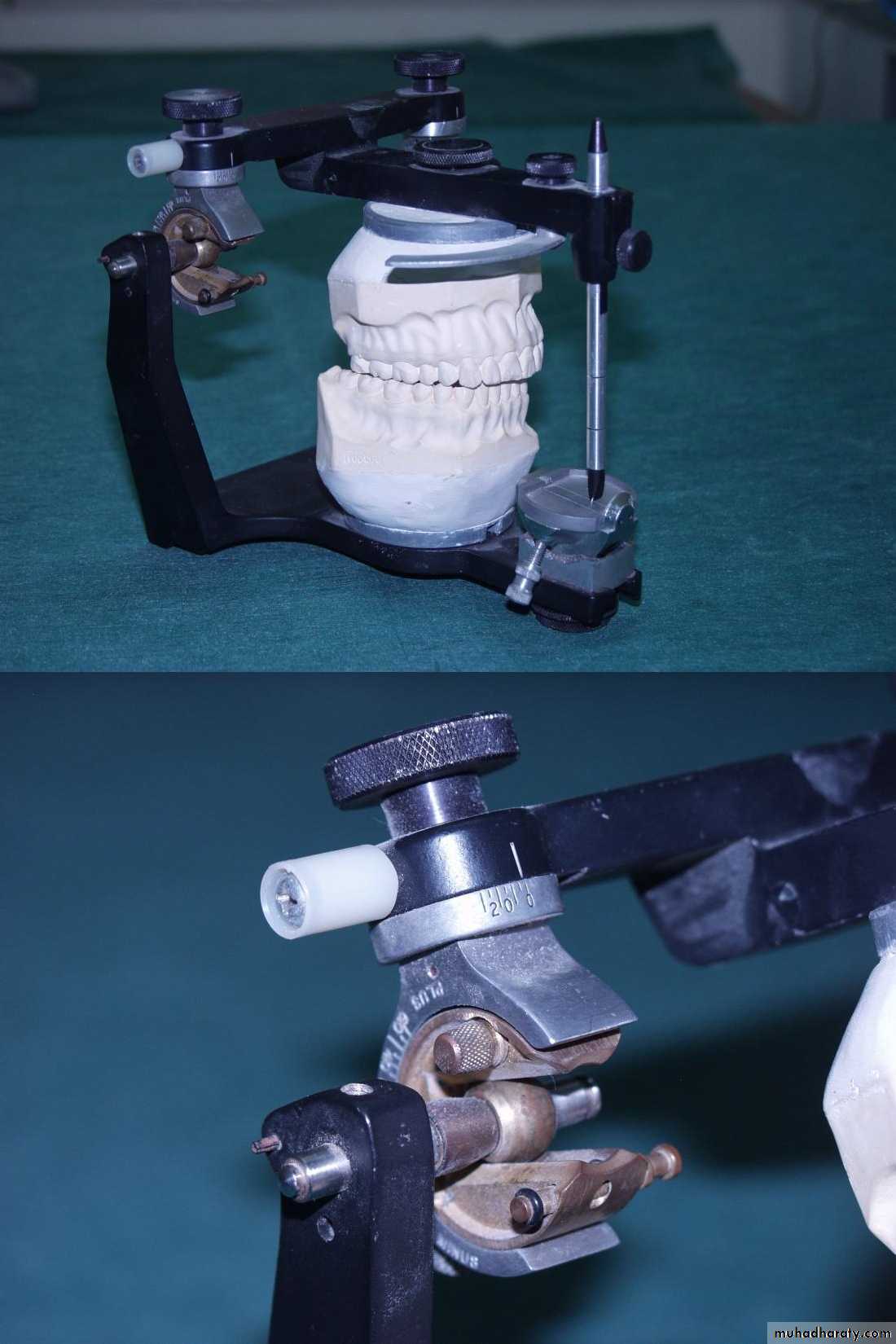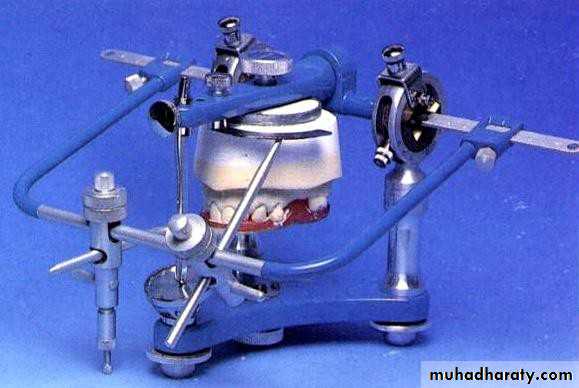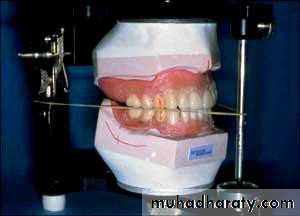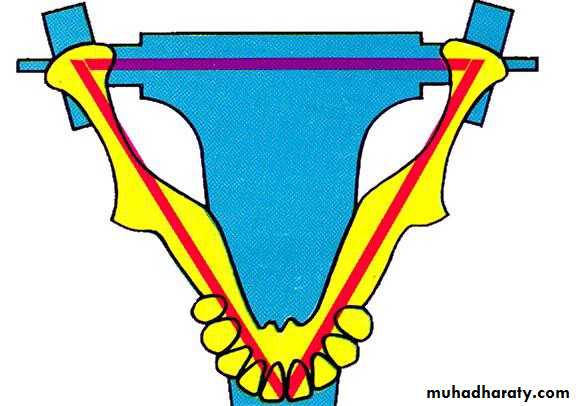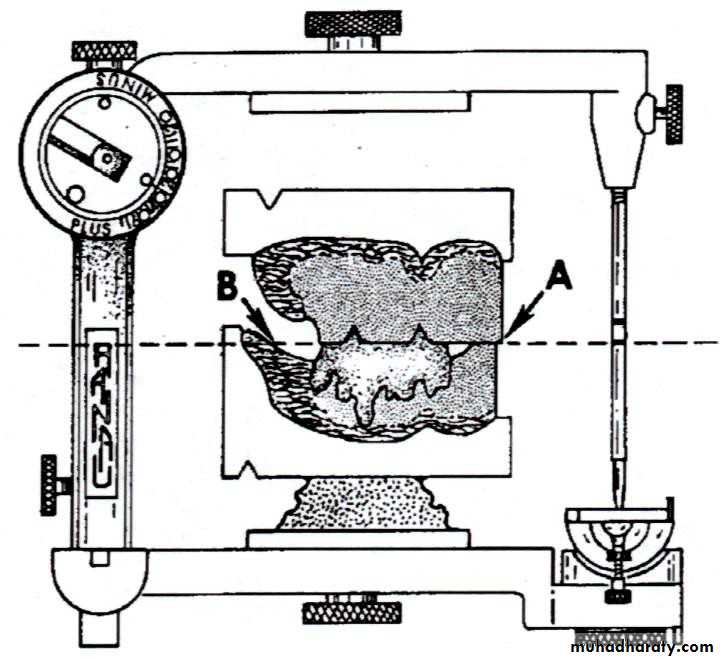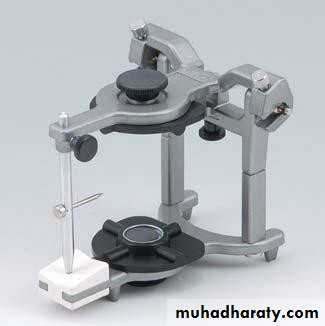صناعة اسنان \ خامس
د.منية م(4)3-11-2016
• I. Face-bows
• Definition
• A dental device which is used to determine the relationship between the maxilla and the axis of rotation (hinge axis) of the TMJ and transfer this relation to the articulator, to ensure the best mounting of the upper cast in relation to the articulators.• Face-bow
• Is an imaginary transverse line around which the mandible can rotate without translatory movement of the condyles.
• An opening or closing movement
• of the mandible about the hinge axis.• Hinge Movement
• MP
• MO• ICP
MP = Maximal protrusion
• ICP = Intercuspal position RCP= Retruded Contact position HA = Hinge axis
• MO = Maximum opening EE=edge to edge
• Posselt’s Figure
• RCP
• EE• HA
• Exact hinge axis: Accurate method using “kinematic” hinge axis locator (mandibular face bow).• Arbitrary hinge axis: based on anatomic
• averages:
• Beyron’s point 11-13 mm from tragus
• Palpate condylar pole.
• Earbow.
• Maxillary (Arbitrary) face-bows are less accurate than the Kinematic type, but they suffice for many routine dental procedures.
• Mandibular (Kinematic face-bows) are indicated when it is critical to reproduce the exact opening & closing movement of the patient on the articulator.
• When the relationship between the maxilla & the axis of rotation has been reproduced, the mandibular cast can be accurately positioned & mounted through the use of an interocclusal record.
• (Mandibular Face Bow=Hinge axis locator= adjustable axis face-bow= hinge bow )
• A device, with adjustable side arms, which is attached to the mandible and used to locate the retruded hinge axis.• ( Mandibular Face Bow )
• To locate the exact terminal hinge axis (rotational axis of the TMJ ) for subsequent use of maxillary face-bow
• To record the centric relation.
• Mandibular Face Bow
• Limited opening and closing allows the condylar rods to draw arcs. The rods are moved towards the center of the arcs, until they move in a point . The latter is called the still point and represents the condylar axis. The condyle in this position lies in the most retruded unstrained position in the glenoid fossa, so mandible and maxilla are in centric.
• The condylar axis lies nearly
• 11 mm anterior to the tragus• of the ear on an imaginary line between the outer canthus of the eye and the upper surface of the tragus of the ear or lies 13 mm in front of the anterior margin of the external auditory meatus.
• 13mm
• Arbitrary methods with maxillary
• face-baw• MAXILLARY FACE BOW
• The Facebow Record
• Face-bow: records the 3-d position of the maxilla relative to a pre-determined planes.
• This allows:• Duplication of the same opening & closing arc as natural teeth and
• Aids in reproducing lateral movements.
• Face-bow Function
• Duplicates opening
• and closing arc of natural teeth by relating maxillary• arch
• to the hinge axis of
• opening and
• closing.
Aids in reproducing
lateral jaw movements• Face-bow Function
• As the mandible closes around hinge axis (mha), the cusp tip of each mandibular tooth moves along an arc.
• The distance between the teeth and the axis of rotation on the small instrument is consider shorter than it is in the skull with a resultant less of accuracy.
• If the location of the axis of rotation relative to the cusp tip differs markedly from the patient to the articulator, the radius of the arc of closure of the cusp tips may be different producing an error.
• The large dissimilarity between the (aha) and (mha) will produce a large discrepancy between the arc of closure of the articulator and of the mandible.
What if patient doesn’t match
articulator?• Articulator
• Patient• Articulators
• aha• mha
• Patients• Therefore the distance from the condyle to the teeth is crucial
• aha• mha
• We obtain a measurement of this distance with a facebow
• Occlusal discrepancies in the
• mouth.
• If discrepancies are left uncorrected, occlusal & associated neuromuscular disorders may result.• There will not be the border movements, which are usually employed in making lateral movements. In the protrusive movement it will be an unlikely piece of luck if the condyle path is copied.
• Graduated
• Condylar Rods• Tightening clamp
• U Shaped Bow
• Bite Fork
• Universal Joint / Jack Clamp
• Infraorbital Pointer
• Graduations on the rod
• Facebow with infra-orbital
• pointer.• The ear-bow uses the
• external reference• auditory point
• meatus when
• determining the
• arbitrary
• hinge axis
• location.
• Facebow Landmarks
• Facebow
Face-bow Record
(maxillary)• 1 . Maxillary face-bow or ear-bow. 2 . Bite-fork.
• 3 . Bunsen burner
• 4. .Millimeter rule.
• . Indelible pencil (Transfer Sticks)
• . Semi-adjustable articulator. 7 . Plaster bowl and spatula.
• 8 . A second maxillary record base with occlusion rim.
• EQUIPMENT NECESSARY
• Casts are prepared for mounting by cutting in thickest part of the base: three V-shaped grooves, two in the posterior section and one in the anterior.
• Before Face Bow Record
• 11- 13 mm
• 1- The condylar axis is determined either: arbitrary or by using mandibular face bow record.
• 1- Mark the relative position of the condylar axis. This
• can be done by drawing a line from the upper margin of the external auditory meatus to the outer canthus of the eye.• The condylar axis lies nearly 13 mm. In front of the anterior margin of the external auditory meatus or 11 mm. anterior to the tragus of the ear.
• 2- A third point of reference placed on the lowest point on the infra orbital margin, is determined for establishing the axio- orbital plane.
• 3- Bite fork is heated and inserted into the rim midway its height and parallel to its plane.
• X
• 4- Insert occlusion• block
• in patient’s mouth
• and keep it in place.• The lower occlusion block may be used for
• this purpose to
upper
• support the block.
• 5- Slip the clamp of face-bow on the stem of bite fork. Let
• the clamp be loose.• Both condylar rods lie on cheek marks.
• Condylar rods show equal calibration with slight tension.• 6- Adjust the condylar rods of face-bow to the width of the face in such a way that :
• The equal calibration can be done by:
• A- Lock one condylar rod to show calibration of 6, for example, place it over the mark of the condylar axis.• Bring the other cond. rod over the opposite mark of cond. axis, apply slight tension and read calibration on that side. Say it reads for example 8. Add both calibrations together and divide them equally 6+8=14/2=7.
• Lock condylar rods firmly.
• The equal calibration can be done by: d- Recheck and be sure that no
• displacement occur during locking of
• clamp.
• E- Lock the clamp firmly on the stem of bite fork then release condylar rods after adjustment of infra orbital pointer. this establishes the elevation of the face bow in relation to the axis-orbital plane.
• 7- Adjust the infra-orbital pointer to be placed on the lowest point on the infra orbital margin.
• 8- Generally the intercondylar axis will parallel the interpupillary plane. Check the alignment of the face-bow
• with that plane.
• 9- The universal
• then tightened
• joint attachment is with the locknut and the
• entire assembly is inspected to make• certain that :
• The maxillary record base is properly
• seated.
• The fork parallels the occlusal plane.
• The frame of the face-bow parallels the interpupillary plane.
• The condylar rods are just lightly contacting the face over the arbitrarily located axis.
• The condylar rods show equal
• readings.
• F- All
• lock screws are firmly set.
• When the patient’s face is centralized in the
• bow, all clamps are tightened.• Notice position of the
• Condylar Rods• Infraorbital Pointer
• Bite Fork.
• Once the Universal joint tightened , never opened.
• Then the MAXILLARY FACE-BOW Transfer will bestarted
• The slide bar clamp is unscrewed and The entire assemblage is now removed and transferred to the articulator.
• Assembly is now centralized on the articulator. Again notice position of - condylar rods
• infraorbital pointer
• L shaped bitefork bypassing incisal pin
• Maxillary Face Bow Transfer
• The entire assemblage
• is transferred to the articulator. The articulator should be located in centric with the incisal pin flush with the upper member.• Re-equalizing the calibrations to bilaterally equivalent
• readings before tightening the condylar rods.
• The face bow is adjusted by the elevating screw to align the occlusal plane with the groove marked around the halfway point of the incisal pin.
• The third point of reference, on the articulator, is the infraorbital indicator, which must be snug to
• the right so that it will be above the tip of the infraorbital
• pointer, the entire face bow with maxillary cast in place• must be raised until the tip of the pointer
• contacts the infraorbital plane indicator (infraorbital plate).
• The cast is then supported in position (using Hanau mounting support or prop) to support the weight of the maxillary cast and plaster during the mounting process.
• Not all the semi adjustable art. have orbital plane guides. It allows the casts to be mounted in relation to the axis-orbital plane of the patient
• N.B.
• The face bow records not only the radius from the condyles to the incisal contacts of the upper central incisors but also the angular relationship of occlusal plane to the axio- orbital plane, face bow must be positioned on the articulator in the same axio-orbital relation as on the patient.
• P.O.
• Accurately mount the maxillary cast to articulator
• Procedures
• MAXILLARY EAR BOW
• MAXILLARY EAR BOW
• CENTRIC RELATION
• CENTRIC RELATION• Definitions
• Centric Jaw Relation Centric Occlusion
• METHODS TO GUIDE THE MANDIBLE IN
• CENTRIC RELATION
• 1 . Tongue retrusion 2 . Swallowing
• . Fatigue
• . Relaxation
• . The Operator’s Fingers
• Method Of Jaw Relation Records
• WAX REGISTRATION METHOD• GRAPHIC TRACING METHODS TERMINAL HINGE AXIS METHOD
• CHEW IN OR FUNCTIONAL RECORD METHODS
• Centric Relation Record
• Wax Registration Method• Graphic Tracing Method
• ECCENTRIC JAW RELATIONS• Recording Protrusive and Lateral Relations
• to Adjust the Controls of Articulator.
• Methods of Registration
• Wax registration method.
• Graphic tracing method.
• Chew – in or Functional method.
• Christensen Phenomena
• When the• mandible moves to edge to edge position ,
• separation
• occurs distally between the natural dentition or occlusion rims .
• Protrusive Record
• The occlusion rims are reestablished and checked for 3mm. Clearance in a protrusive excursion
• The protrusive relationship determines the angle of the horizontal condylar path
• N.B. Physiologically 2mm. protrusion is the limit of functional range, But from the mechanical point of view, practically it is found that less than 4mm. protrusion increase the error of
• setting the condylar guidance of the articulator.
• Horizontal condylar guidance
• Lateral condylar guidance
• Arrangement of Anterior Teeth to Adjust
• the Incisal Guidance
• The six maxillary and six mandibular teeth are set up in arrangement dictated by the patient’s esthetic and phonetic requirements.• Gently guide the maxillary cast to bring the anterior teeth into a straight protrusive
• edge-to-edge contact just slide upon one another.
• The incisal guide is then rotated antero-posteriorly
• to make contact with the end of the incisal pin and the lock-nut is
• tightened to maintain the registration. Then the frontal (lateral) adjustment is determined.
• The teeth should be arranged so that there is maximum interdegitation of the cusps in the opposing fossae (centric occlusion) with the casts in centric relation.
• Then Balance in lateral occlusion: Check for any adjustments to free and balance the occlusion.
• Return to centric and adjust if necessary (lateral position of the incisal pin of the articulator may be slightly raised from the table).
• Repeat the procedure for the opposite lateral occlusion. Balance in protrusion: Free the occlusion from any interlocking and balancing contacts will be sought between the position teeth or at least the molar teeth.
• Return to centric occlusion and adjust if necessary.
laboratory remounting is performed to
correct the occlusionlaboratory remounting is performed to
correct the occlusionlaboratory remounting is performed to
correct the occlusion• C.R. Record
• Terminology
• (Eccentric) Excursion
• The movement occurring when the mandible moves away from maximum intercuspation• Excursive Movements
• Directions of Excursive Movements
• Protrusive• Laterotrusive (working movement)
• Mediotrusive (non-working movement)
• Lateroprotrusive
• Protrusive
• A movement of the mandible towards• the anterior, pushing it forwards
• Excursive Movements
• Protrusive Movement
• Excursive Movements
• Protrusive Record
• Used to set condylar inclination
• Record is taken with the mandible in a protrusive jaw relationship• Wax
• Excursive Movements
• Laterotrusive
• Also called a working movement• A movement of the mandibular condyle in a lateral direction, away from the midline
• Specify side movement is occurring on-
• e.g. Left or right.
• Mediotrusive
• Also called non-working or balancing movement• A movement of the mandibular condyle in a medial direction, towards the midline.
• Excursive Movements
• Lateral Excursions
• Lateral Excursions
• Excursive Movements
• Laterotrusive and Mediotrusive• Balancing Side
• Working Side• Lateral Excursions
• Lateroprotrusive
• A movement of the mandibular condyle with a protrusive and a lateral component.• A combination of a protrusive and laterotrusive movement.
• Excursive Movements
• Hanau suggests that final occlusal correction in the mouth or the use of static lateral jaw relation records to mount the opposing casts in lateral positions will not eliminate all possible interferences.
• It should be remembered that …when lateral and protrusive records are used to adjust an instrument of this class, the settings will be accurate for only those positions at which the records were made. What happens between the position of centric relation and the position of the record remains unknown. The position will be accurate, but the pathways between these positions will not be.
• Remember
• The Hanau H series is not capable of accepting lateral jaw relation records.
• Some semi-adjustable articulators (for example, the Hanau H series, the Dentatus, and the Gysi) have the condyles attached to the upper member of the instrument (non-arcon), whereas others have the condyle attached to the lower member as occurs in nature (arcon )• Mounting the upper cast
• By face bow record.• By Bonwill triangle.
• Mounting the upper cast
• By Bonwill triangle• Plasticine
• Semi-adjustable Articulator
• Can be programmed to reproduce• some MN movement capabilities; usually limited to straight line movements
• Remember
• Semi-adjust. Articulator Mechanics
• Maxillary Cast: related with face-bow.• Mandibular Cast: related with interocclusal record or “hand articulate”. This relates the mandibular cast to the hinge axis through its relationship with the maxillary cast.
• Excursive Guidance: set incisal guide table and condylar guidance.











